
| [Printing: I recommend you print this in landscape mode, and if you then bind the printouts across the top, you will have a nice flip-book.] |
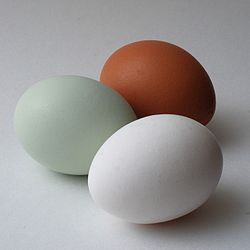 This is a partial list of mostly chicken breeds, chosen for their potential usefulness especially as a
household-support fowl.
This is a partial list of mostly chicken breeds, chosen for their potential usefulness especially as a
household-support fowl.
This list is mostly clean-legged (no feathers on the feet) breeds and mostly omits show-only breeds.
Some bantams are included for those who want to raise a smaller size chicken.
Some hybrids (offered by specific hatcheries) are included for interest, but keep in mind their chicks
may not have the same characteristics (won't breed true).
Every hatchery linked for a breed has that breed available for sale. Click their link for full details.
"NAH" means Not A Hatchery; those sources are included for information but you can't buy the chickens from them.
Q: "I live in the city-- all the noisy rooster crowing will get me in trouble with the neighbors or worse!"
A: In most cases, hatcheries give you the choice of buying mixed roosters and hens, all roosters, or all hens.
Some people buy all roosters, fatten them up for a couple of months, and then slaughter them for the freezer.
Others, such as yourself,
buy all hens, especially of an egg-laying breed. Hens don't crow, and many breeds are very quiet. Laying hens also
don't need a rooster around to lay eggs-- remember that most eggs you buy in the store are "unfertilized"! If you
buy all hens, you'll have to order replacements for them every few years as they age and "pass away",
but after you have your chicken accommodations set up, this should be a nominal expense.
Furthermore, if you have space for only a few chickens, some of the hatcheries will let you order just a handful of chicks, along with a warmer (costs a bit extra) to keep them cozy during the journey to your home.
And finally, especially in these economic times, many cities already allow, or are deciding to allow, the keeping of chickens in city limits, as long as they are clean, not a health hazard, and don't disturb the neighbors.
Q: "I'm a vegan-- why would I need to keep chickens??"
A: If you garden and raise some of your own food, a handful of chickens could be very handy. Most chickens are pretty good at hunting down and snacking on bugs, but a number of breeds are noted for it. I list them below under the bug-hunters.
And, of course, they give you free fertilizer for your garden-- just compost it and serve (to your tomato plants). The nitrogen in the bugs they eat makes the fertilizer all the richer!
- - -
This site is starting out as a USA-centric site; but it doesn't have to stay that way. If you know of a good
hatchery or hatcheries in your area, I will be happy to add them to the listing for every breed they provide.
Just drop me a line at 
All comments [in italic brackets] are the comments and anecdotes of me (the editor of this website), not of the sources.
"Most large chicken breeds have a bantam counterpart, sometimes referred to as a miniature. Miniatures are usually one-fifth to one-quarter the size of the standard breed, but they are expected to exhibit all of the standard breed's characteristics. A true bantam has no large counterpart, and is naturally small...[I found that detailed information (rate of lay, etc) about the "bantam" or "miniature" versions of the breeds/varieties was hard to come by. With the above statement by Wikipedia in mind, I have assumed here that the bantam or miniature of a variety has the same characteristics as the large edition... except for egg and body size, of course. Every characteristic that I had to assume in this way is listed in this italic bracketed text.They are suitable for smaller backyards as they do not need as much space as other breeds. Bantam hens are also used as laying hens, although Bantam eggs are only about one-half to one-third the size of a regular hen egg..." - Wikipedia
Recall that 16 ounces = 1 lb.]
|
|
|
 Single Comb
Single Comb
|
 Rose Comb
Rose Comb
|
 Pea Comb
Pea Comb
|

Spiked Rose Comb |

Buttercup Comb |
 "V" Comb
"V" Comb
|
|
See more about comb types at U of Illinois; and
in technical jargon. Tables courtesy Murray McMurray Hatchery. |
|
|
|
|
| CRITICAL: Fewer than 500 breeding birds in the United States, with five or fewer primary breeding flocks (50 birds or more), and globally endangered. | flocks, and globally endangered. Also included are breeds with genetic or numerical concerns or limited geographic distribution. |
| THREATENED: Fewer than 1,000 breeding birds in the United States, with seven or fewer primary breeding flocks, and globally endangered. | RECOVERING: Breeds that were once listed in another category and have exceeded Watch category numbers but are still in need of monitoring. |
| WATCH: Fewer than 5,000 breeding birds in the United States, with ten or fewer primary breeding | STUDY: Breeds that are of interest but either lack definition or lack genetic or historical documentation. |
If you want to raise 'little cornish hens' as a home flock that you can manage in the normal way, you might think about choosing any of the bantam varieties of Cornish. They are a similar size to "Cornish game hens", but much more vigorous, and no hurry to slaughter them "before they pass their prime".]
"Have you ever admired the Cornish Game Hens for sale in the supermarket? Have you ever wondered if you could grow them yourself? Now you can! Murray McMurray Hatchery can supply you with baby chicks from the broiler industry’s top breeders. We sex these Jumbo Cornish X Rocks and provide you with the pullets to use for your Cornish Game Hens. BUTCHER AT 2-1/2 POUNDS LIVE WEIGHT and you will be eating the most delicious chicken in your life and you grew it yourself!
Please Note: Cornish Game Hens are hybrids. Therefore we do not recommend breeding, they will not produce the same high quality in the next generation and due to the extreme rate of growth they will be too large at time of sexual maturity to breed successfully."
Murray McMurray Hatchery"This is the most remarkable meat producing bird we have ever seen. Special matings produce chicks with broad breasts, big thighs, white plumage, and yellow skin. The rapid growth of these chicks is fantastic and the feed efficiency remarkable. Whether you get these Cornish X Rock chicks for your own pleasure or to raise and sell, you can’t do better. If you want to raise capons, buy males and have them caponized at 2 or 3 weeks of age. Females have a fine smooth finish when dressed and reach beautiful roasting size. Buying straight run chicks gives you some of each sex so that you can take advantage of the strong points both ways. We think our Cornish X Rock chicks are among the finest meat birds in America. We should know. We fill our family freezers with them every year! Males will dress from 3 to 4 pounds in six to eight weeks and females will take about one and one-half weeks longer to reach the same size. Please Note: These birds are not recommended for raising at altitudes above 5000 feet.
"Please Note: Jumbo Cornish X Rocks are hybrids. Therefore we do not recommend breeding, they will not produce the same high quality in the next generation and due to the extreme rate of growth they will be too large at time of sexual maturity to breed successfully."
Murray McMurray Hatchery"A broiler is a type of chicken raised specifically for meat production. Modern commercial broilers, typically known as Cornish crosses or Cornish-Rocks are specially bred for large scale, efficient meat production and grow much faster than egg or traditional dual purpose breeds. They are noted for having very fast growth rates, a high feed conversion ratio, and low levels of activity. Broilers often reach a harvest weight of 4-5 pounds dressed in only eight weeks...
"Broilers are often called "Rock-Cornish," referring to the adoption of a hybrid variety of chicken produced from a cross of male of a naturally double breasted Cornish strain and a female of a tall, large boned strain of white Plymouth Rocks. This first attempt at a hybrid meat breed was introduced in the 1930s and became dominant in the 1960s. The original cross was plagued by problems of low fertility, slow growth, and disease susceptibility, and modern broilers have gradually become very different from the Cornish x Rock hybrid...
"Modern broilers are typically a third generation offspring (an F2 hybrid). The broiler's four grandparents come from four different strains, two of which produce the male parent line and two of which provide the female parent line, which are in turn mated to provide the broilers...
"Broiler chickens may often get joint disorders because their legs cannot bear the heavy bodies... Additionally, it is very inactive and as a result is a poor forager, prone to predation, and is generally not suited to small free range homestead flocks."
Wikipedia
|
Best Egg Layers per Murray McMurray: The Pearl-White Leghorn (white eggs) Black Star (brown eggs) Red Star (brown eggs) Rhode Island Reds (brown eggs) |
Best Egg Layers per Ideal Poultry Breeding Farms: Ideal 236 (hybrid) (white eggs) California Whites (hybrid) (white eggs) Production Black (white eggs) Production Red (brown eggs) |
Best Egg Layers per Randall Burkey Company: Hubbard ISA Brown (brown eggs) (~60% of world's brown egg market) |
|
|
||||||
|
|
Winter-Hardy (may not be frost-proof) |
|
Happy In The Heat | |||
|
Araucana/Ameraucana and Araucana Bantam Brahmas (and bantams) |
||||||
|
||||||
|
||||||
|
||||||
|
||||||
|
I'm calling them 'moderate' for now.
|
||||||
|
|
|||||||
| Jump To A Chicken Variety By Name: | |||
|
Ancona Blue Andalusian Appenzeller see Silver Spangled Spitzhauben Araucana/Ameraucana Araucana Bantam Black Australorp Barnevelder Black Star see Black Sex Link Brabanters Cream Brabanter Gold Brabanter Brahmas Buff Brahma Dark Brahma Light Brahma Broilers Black Broiler Color Range Broiler Red Broiler Buckeyes Buttercups Campines Golden Campine Silver Campine Buff Catalana Chanteclers Buff Chantecler Partridge Chantecler Red Chantecler Production Red Cinnamon Queen Cornish Blue Laced Red Cornish Bantam Buff Cornish Dark Cornish Dark Cornish Bantam Spangled Cornish Bantam White Laced Red Cornish White Laced Red Cornish Bantam White Cornish Bantam |
Cubalayas Black Breasted Red Cubalaya Blue Red Cubalaya Delaware Delaware X Hampshire Dominique Dominique Bantam Egyptian Fayoumi Guinea Fowl Hamburgs Blue Hamburg Golden Penciled Hamburg Golden Spangled Hamburg Silver Penciled Hamburg Silver Spangled Hamburg Barred Holland Iowa Blue Mottled Java Jersey Giants Black Jersey Giant White Jersey Giant Kraienkoppes Black Breasted Red Kraienkoppe Silver Kraienkoppe La Fleche Lakenvelders Golden Lakenvelder Silver Lakenvelder Leghorns Buff Leghorn California White Danish Brown Leghorn see Single Comb Brown Leghorn Exchequer Leghorn Ideal 236 Pearl White Leghorn Red Leghorn Rose Comb Brown Leghorn |
Leghorns (con't) Single Comb Brown Leghorn Single Comb Dark Brown Leghorn Single Comb Light Brown Leghorn Silver Leghorn White Leghorn Cuckoo Marans Minorcas Black Minorca Buff Minorca Naked Neck see Turken Norwegian Jaerhon Spangled Russian Orloff Orpingtons Buff Orpington Buff Orpington Bantam White Orpington Production Black Production Red (Cherry Eggers) Reds New Hampshire Red New Hampshire Red Bantam Rhode Island Red Rhode Island Red Bantam Rhode Island Whites Red Cap/Derbyshire Red Cap Red Jungle Fowl Red Star see Red Sex Link (Plymouth) Rocks Barred Rock Barred Rock Bantam Buff Rock Partridge Rock Partridge Rock Bantam Silver Penciled Rock Silver Penciled Rock Bantam White Rock |
Sebrights Buff Laced Sebright Golden Sebright Silver Sebright Sex Links Black Sex Link Brown Sex Link Gold Sex Link Golden Comet Hubbard ISA Brown Red Sex Link Sicilian Buttercups see Buttercups Silver Gray Dorking Silver Spangled Spitzhauben Sumatra Sumatra Bantam Speckled Sussex Turken Twentse see Kraienkoppes Welsummer White Faced Black Spanish Wyandottes Blue Laced Red Wyandotte Blue Laced Red Wyandotte Bantam Buff Wyandotte Buff Wyandotte Bantam Buff Columbian Wyandotte Bantam Columbian Wyandotte Columbian Wyandotte Bantam Golden Laced Wyandotte Golden Laced Wyandotte Bantam Partridge Wyandotte Partridge Wyandotte Bantam Silver Laced Wyandotte Silver Laced Wyandotte Bantam Silver Penciled Wyandotte White Wyandotte |
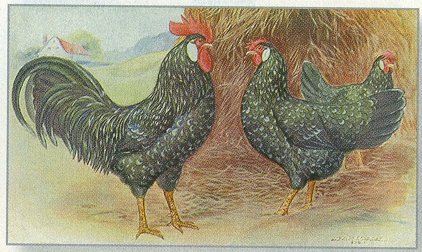
| Male Mature Weight: 6 lbs |
| Female Mature Weight: 4.5 lbs |
| Comb Type: Single |
| Egg Color: White
Egg Size: 24-25 Ounces/dozen Rate of Lay: "Very Good", ~ 5/week |
| Type: Meat - Laying - Dual-purpose - Other |
| Setting: No |
| Disposition/Temperament: Alert, quick, get along well w/humans and other chickens, tolerates confinement |
| Climate Hardiness: All Climates, Winter-hardy [1], [2] |
| ALBC Priority: Watch |
| Show Class: Mediterranean |
Famous as layers of good sized white eggs, non-setters, these beautiful chickens have lustrous black plumage with white tips on every few feathers. They are about the same size to a little heavier than Leghorns. The dark color and active temperament make them a good bird to raise where hawks, owls, and animal predators are a problem because they do not show up like white breeds; and they are very quick and alert. They are an old breed in the Mediterranean Class, coming from the area around Ancona, Italy via England to the United States by the late 1800's. Baby chicks are very bright and snappy looking with their approximately half and half combination of black and white patches.
Customer comments:
My Grandmother and I had purchased several varieties of chicks from you over thirty years ago.
We always had good results with them, as well as countless hours of fun watching the unusual varieties
take shape! Last year, I was able to order some Anconas for my children to enjoy raising. They were
beautiful, healthy chicks and have made wonderful layers of large white eggs. We have gathered eggs
everyday since they started laying, right through the winter. Thanks for the wonderful experience
then and now.
- - -
These birds are great. The males are very watchful over the hen for danger and the hens take care
of each other really well. The birds learn very fast and get along good with other breeds of birds.
They accept new birds in there flock well also. They are very healthy and fun to work with. Thank
you Warrens Wi
- - -
In the last group of chicks I got were two Anconas. What sweet and easy birds. Although a bit jumpy,
once trust is formed they are your pals. My two follow me around the yard, fly up onto my arm or
shoulder when I am filling the feed cans and love to eat out of my hand! They don't like to be pet or
handled but like to be around you. Great birds! I can't wait for them to begin laying which will be
any day now.
Ideal Poultry Breeding Farms, Inc:
Similar to the Brown Leghorn except for their color.
Anconas, which originated in Eastern Italy near the port of Ancona, are an attractive, distinctive, white egg breed with size and body shape very similar to Leghorns. They are small, active and alert with black plumage that has some V-Shaped tipped feathers evenly distributed throughout the plumage. They are good foragers, considered non-broody and very good layers of white eggs. The black and white chicks are very eye appealing.
Standard weights at maturity are males-6 lbs. and hens-4 1/2 lbs.
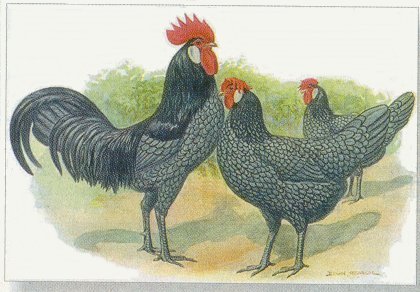
| Male Mature Weight: 7 lbs |
| Female Mature Weight: 5.5 lbs |
| Comb Type: Single |
| Egg Color: White
Egg Size: 24-25 Ounces/dozen Rate of Lay: "Very Good" |
| Type: Meat - Laying - Dual-purpose - Other |
| Setting: No |
| Disposition/Temperament: Flighty, noisy, can be confined |
| Climate Hardiness: Not winter-hardy [2] |
| ALBC Priority: Threatened |
| Show Class: Mediterranean |
These beautiful blue fowl originated in Andalusia, a province of Spain, but have long been known in England and the United States. They are magnificent to look at with their graceful, stately carriage and delicately blue-laced plumage; and this marks them as an especially fine breed for exhibition. The ideal feather color is a beautiful slatey blue with a narrow lacing of darker blue. The male has a cape of lustrous blue-black, sometimes shading almost to a dove gray, and feathers from this are fine material for tying artificial flies. Skin color is white and shanks and toes are a leaden blue. Andalusian hens are fine layers of white or slightly tinted eggs with very little tendency towards broodiness. Both sexes have long, deep bodies, well set up, with plenty of vitality. In size they are bigger than Leghorns, about the same as Minorcas.
THE COLOR BLUE: A unique genetic feature of this breed is the constant recurrence in the offspring
of not only all blue chicks, but also the black, white, and black-white colors used in the original
matings many generations ago to produce these blue birds. All of these chicks carry the blue genes
and when mated black on white or with other blues in turn produce many blue offspring. In our
breeding flocks, however, only blue males of the finest color are used.
Approximately 50% of the baby chicks will be all blue. The other 50% will be black, white, and
black/white combinations.
Customer comments:
I realy loved the product, and would buy again. had full egg production, and am very satisfied!!
- - -
We are so pleased with our free "rare chick". "Silver" has matured into a handsome rooster now.
He keeps a watchful eye over his brown egg layer hens. His proud crowing adds a nice touch around
the house. "Silver" is indeed a fine example of the great birds from McMurray Hatchery.
- - -
Despite having heard that Blue Andalusions are flighty and nervous around people, I have found our
blue andalusion hen "Olga" to be an absolute delight. She has a personality all of her own, and
actually comes over and "asks" to be picked up. Thanks McMurray!
- - -
We ordered Blue Andalusians from you last year and they are beautiful! We showed them in the Avenue
of Breeds at the State Fair. A photographer took pictures of them and our rooster ended up being
in the Midwest Millions Commercial for the Iowa Lottery! Thanks again for your great stock.
- - -
We have been very impressed with our Blue Andalusian hens. They are alert, terrific foragers and
are stately to behold. They are also quiet when picked up and are the favorite of my children.
They have asked me, in fact, to order more.
- - -
In 2006 at the Kentucky State Fair, our son won the 4-H reserve grand champion of the Mediterranian
Class with one of your Blue Andalusian poulets. Beautiful medium size white eggs.
- - -
Your Blue Andalusians are great - I bought/bred about 50+ this year from various places and one of
the 12 pullets from you is the best of all of them - gorgeous looking and great personality!
I'm going to breed her to my best rooster and hoping for great results next year.....
Ideal Poultry Breeding Farms, Inc:
The Blue Laced Color does not breed true. A mating of blue x blue produces three colors- black, blue, & splash white (white with blue cast).
Blue Andalusians, which were named for the Providence of Andalusia in Spain, are one of the oldest Mediterranean breeds. They are an attractive, small, active, closely feathered breed, which lay white eggs and is classified as a non-sitter. The blue in Blue Andalusians is the result of a heterozygous combination; therefore, they do not breed true.
Standard weights at maturity are males-7 lbs. and hens-5 1/2 lbs.
When blue (Bl bl) variety males are crossed with blue (Bl bl) variety females, the ratio of colors produced is as follows: 1 black (bl bl), 2 blue (Bl bl) and 1 splash (Bl Bl) (white with a blue cast). Any blue variety ordered from Ideal Poultry may include black, blue or splash chicks.
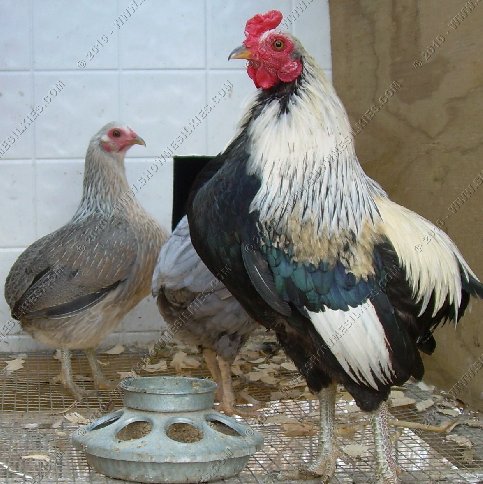 Show Me Silkies.com |
| Male Mature Weight: 5 lbs |
| Female Mature Weight: 4 lbs |
| Comb Type: Pea |
| Egg Color: Multicolored
Egg Size: 25-26 Ounces/dozen Rate of Lay: "Excellent" |
| Type: Meat - Laying - Dual-purpose - Other |
| Setting: Yes (1 hatched ducklings) |
| Disposition/Temperament: Friendly and gentle, tolerates confinement |
| Climate Hardiness: All Climates, Winter-hardy, Heat-hardy [1], [2] |
| ALBC Priority: Study |
| Show Class: All Other Standard |
The "Easter Egg Chicken", This unusual breed gets its name from the Indian tribe of Chile where they were first discovered. Araucanas lay beautiful colored eggs of blue-green shades from turquoise to deep olive. These natural Easter Eggs will amaze your friends and make a great "show and tell" project for school. Adults are of medium size with pea combs and our breeding stock is selected for their ability to produce colored eggs. They exhibit a wonderful combination of colors and color patterns and 10 or 20 of these birds make an absolutely beautiful laying flock that is extremely hardy and will be the talk of the town. Baby chicks come in all colors, plain and fancy, just like the adults. This is a unique breed and great fun to have when the colored eggs start coming. Our Araucanas are recommended for egg laying color and ability and not for exhibition.
Customer comments:
I ordered 10 Araucanas from McMurray and everyone loves them. People think that they are fascinating! I get
alot of money for the eggs and my friends thought that they were funky. Buy some! They're really great and
tame!
- - -
We ordered 25 Araucana chicks and just love them! My 5 year old and 8 year old were so excited over the
first blue egg that you would have thought it was pure GOLD. Everyone thinks we have the most beautiful
flock because they are all so different in their colorations. You will love the pure novelty of these
handsome birds!
- - -
I ordered my Aracana day old chicks on a friday afternoon, and by sunday afternoon I had my 26 Beautiful
little chicks. They are all so healthy and strong. All of them have the nicest assortment of colors I've ever
seen! I will recommend McMurray Hatchery to all of my friends! I have a new Favorite site! Thank You, Cheri
- - -
Last year I ordered 3 Araucana chicks along with others in my order. I love seeing the green eggs in my
fridge. While the other hens have stopped laying for a while, I can always count on 2 green eggs a day in
the nest box. Every kid we know wants to take one to school for show and tell. Love this site!
- - -
I live on a farm in Somerset County,PA. I ordered 2 araucana hens. In this area the people that I sell eggs
to are so amazed with their magnificent green color. Thank you Murray Mcmurray Hatcheries!
- - -
We have 8 araucunas and love them! We live on an island in SE Alaska and our hens weather the winters fine.
They are predictable layers, and matured months before the rest of our hens who were hatched at the same
time! Would highly reccomend to all chix owners as good producers.

|
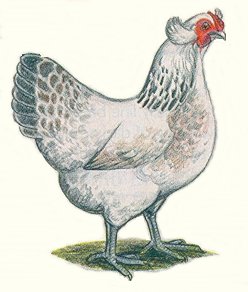 Murray McMurray- "tufted" type |
The Araucana ... is a curious and funny sort of fowl. They are quite personable and come in a rainbow of colors. They are rumpless and have tufts of feathers protruding from each side of the neck. Bred primarily for its novel characteristic of blue eggs, the Araucana is, nevertheless, a dual purpose fowl that carries a plump and meaty body. The hens are good layers of medium sized eggs.
Araucanas have a rich and arguable history. Little is known of the origin of the Araucana except that some came from South America and they have the distinction of laying a blue or turquoise shelled egg. The first written evidence of the existence of blue eggs in Chile was in 1883. The characteristic for blue egg color is dominant and will occur in the offspring when this fowl is crossed with another breed of domestic chickens: hence, cross-breeds which lay blue or tinted eggs are often mistaken for Araucanas. [They] originated in a remote area of Chile ruled by fierce Araucana Indians who resisted European domination until the 1880’s.
The distinctive traits of blue egg, tufts and rumplessness originally were found in two distinct breeds from this region. The first breed, named “Collonocas”, laid blue eggs and was rumpless. There is circumstantial evidence that the blue egg color came from crosses of chickens with pheasants. While most hybrids are sterile, a small percentage is not. And the motive for crossing the two was the belief that the offspring made superior game fighting stock. The novelty of a blue egg meant that these rare fertile hens were used for breeding. The Persian Rumpless, a rumpless breed, was introduced by the Dutch during the colonial period and became widespread. The Araucana Indians preferred this trait since they believed that lack of tail feathers made it harder for predators to catch them.
The second breed, called “Quetros”, had unusual tufts, but was tailed and laid brown eggs. The tufts gene is the most mysterious of all. Presumably there was a mutation in a gene that resulted in these ornamental tufts. Left to natural selection the trait would soon die out because of its negative affects on the developing embryo. The gene mutation is lethal if two copies are present, and the embryo dies in shell. Even one copy of the gene is associated with about 20% mortality. Therefore, the Araucana Indians must have decided that it was a desirable trait and consciously propagated it.
The development of the modern Araucana breed begins with the great Chilean breeder, Dr. Ruben Bustros. As a young man in the Chilean army, he encountered the Araucana Indians in remote areas and observed their unique types of chickens during the 1880’s. He returned later and obtained some of the Quetros and Collonocas stock. Crossing these two breeds, over many years he developed tufted, rumpless birds that laid blue eggs, the first Araucanas. He was visited in 1914 by Professor Salvador Castello Carreras of Spain, who introduced them at the World Poultry Congress in 1918. Attempts to import Araucana stock into the United States over the years met with great difficulties. They were first imported into the United States in the early 1930's. However, there was no common goal among these few dedicated breeders until the 1960’s when Red Cox started an Araucana breeders group. His untimely death set things back, and it wasn’t until the late 1970’s that the Araucana was recognized as an official breed.
[Ameraucanas]: The "Easter Egg Chicken" originally came from Chile in South America, discovered by the Araucana Indians. The true Araucana chicken is rumpless (tailless) and has a small curling tuft of feathers next to each ear. The Easter Egg Chicken (Ameraucanas) are different because they have a full beard under the beak and have a tail. Cackle hatchery offers for sale the Ameraucana or better described as the "Easter Egg Chicken."
Cackle hatchery's breeding program objectives for the "Easter Egg Chickens" are: to produce chickens with a wide variety of colors, patterns, combinations of colors, with a full beard under the beak and high egg production of colorful eggs. The color of their egg shells vary from pale blue to dark blue, to various shades of green and a few light brownish/pink eggs. Their meat is delicious and it has a taste similar to quail. We do not offer a specific color variety of this breed; however, we do breed for a wide variety of colors.
Hen-----------5 1/2 lbs
Rooster-------6 1/2 lbs
Pullet--------- 4 1/2 lbs
Cockerel----- 5 1/2 lbs
Ideal Poultry Breeding Farms, Inc:
("Ameraucanas":) Araucanas originated in Chile, S.A. and in the U.S. have been bred with a pygostyle (tail head) and muffs & beards have replaced the ear tufts to produce Ameraucanas. They lay green, blue, pink and light brown eggs and are known as the "Easter Egg Bird".
Ameraucanas, known as the "Easter Egg Breed", are a multicolored breed. They have beards, muffs and a normal tail with a tail head. They are often incorrectly called Araucanas, which have ear tufts, are rumpless, and do not have a tail head which gives them a bunny tail appearance. Most of the chicks sold as Araucanas are really Ameraucanas, which are excellent, efficient producers of large eggs of many colors and shades including blue and green.
Standard weights at maturity are males-5 lbs. and hens-4 lbs.
Ameraucanas are a very popular breed because of the beautiful blue or green tinted eggs they lay which have contributed to their nickname as the "Easter Egg Chicken." This unusual multicolored breed efficiently produces many large and colorful eggs that are fun to give both family and friends; as you will find many people have never seen naturally colorful eggs like the eggs from an Ameraucana.
Comb: Pea.
Standard weight at maturity: Hens 4 lbs, males 5 lbs.
Egg color: Tinted
Wikipedia-- Ameraucana: [NAH]
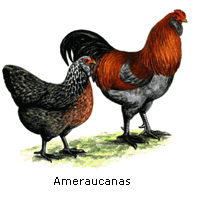 |
Ameraucanas are similar to Araucana chickens because both have pea combs and lay blue shelled eggs, but they have many differences and are completely different breeds. Some other Ameraucana traits include full tails, muffs and slate or black legs depending on the variety. Bantam cocks weigh 30 ounces and bantam hens weigh 26 ounces while large fowl cocks weigh 6½ pounds and large fowl hens weigh 5½ pounds.
Confusion with Easter Egg chickens:
The Ameraucana Breeders Club defines an Easter Egg chicken, or Easter Egger, as any chicken that possesses the blue egg gene, but doesn’t fully meet any breed description as defined in the APA standards. Further, even if a bird (that possesses the blue egg gene) meets an APA standard breed description, but doesn’t meet a variety description or breed true at least 50% of the time it is considered an Easter Egg chicken...
In other words, most Easter Egg chickens are "mutts" which happen to carry the blue egg gene. True Ameraucanas are rare.
Ameraucanas were bred from Easter Eggers, a mixed non-standard breed derived from breeding the native South American Araucana with Old World varieties...
The characteristic muff and breed of the Ameraucana are present in U.K. Araucana as these traits are present in the Mapuche and Quechua de Artes founder stock imported into Europe from the Falkland Islands. The fully feathered faces of the founder stock are of vital importance as they insulate the birds against the frigid cold of southern coastal South America. Winds from Antarctica bring the temperatures to below zero for months at a time. Blue egg laying chickens brought to the Falklands by Argentinians, traded from Mapuche and Quechua speaking Indians, were later exported from the Falkland Islands by British guano and fishing fleets. The Ameraucana is descended of U.K. Araucanas brought into North America during the World Fair in Toronto and Montreal's 1967 Expo...
Wikipedia-- Araucana: [NAH]
The Araucana, also known in the USA as a South American Rumpless, is a breed of chicken originating in Chile. The Araucana is often confused with other fowl, especially the Ameraucana and Easter Egger chickens, but has several unusual characteristics which distinguish it. They lay blue eggs, have feather tufts near their ears, and a tail...
The ancestors of the modern Araucana chicken were purportedly first bred by the Araucanians Indians of Chile -- hence the name "Araucana." The Araucana is a hybrid of two South American breeds: the Collonca (a naturally blue-egg laying, rumpless, clean-faced chicken) and the Quetro (a pinkish-brown egg layer that is tailed and has ear-tufts).
[It is rumored that the original Araucana chickens were brought to South America by Polynesian travelers.]
See also: Backyard Chickens.com: Araucana [NAH]
Backyard Chickens.com: Ameraucana [NAH]
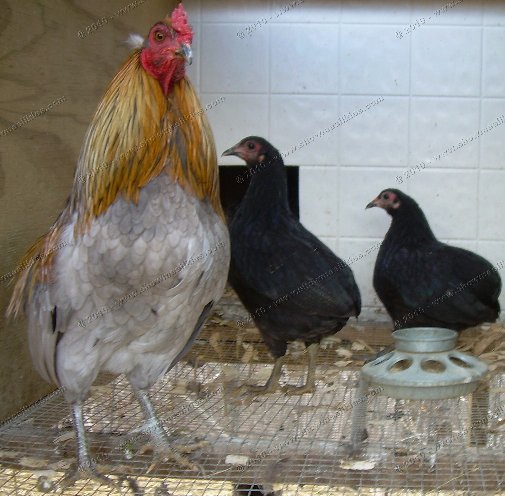 Show Me Silkies.com |
| Male Mature Weight: 30-36 oz |
| Female Mature Weight: 26-34 oz |
| Comb Type: Pea |
| Egg Color: Multicolored
Egg Size: [Small] Rate of Lay: ["good" to "excellent"] |
| Type: Meat - Laying - Dual-purpose - Other |
| Setting: ["Yes"] |
| Disposition/Temperament: [Friendly and gentle, tolerates confinement] |
| Climate Hardiness: All Climates, Winter-hardy, Heat-hardy [1], [2] |
| Show Class: All Other Combs, Clean Legged Bantams |
The bantam that lays the colored egg. Their eggs are a bluish green and they are treasured for this quality. The Araucana is one of the United States most recent breeds and like their standard size relatives come in many different colors and feather patterns.
Customer comments:
Araucana Bantams make excellant pets for childern. Also they are very good PETS for beginners.
Your friends will oooh and ahhh over these beautiful blue and green eggs!!
- - -
My Araucana, Lela is the nicest hen of all time. She loves to be cuddled, and she lays beautiful
green and blue eggs. On top of everything, Lela is a VERY pretty little girl!
The Araucana bantam is a curious and funny sort of fowl. They are quite personable and come in a rainbow of colors. They are rumpless and have tufts of feathers protruding from each side of the neck. Bred primarily for its novel characteristic of blue eggs, the Araucana is, nevertheless, a dual purpose fowl that carries a plump and meaty body. The hens are good layers of medium sized eggs.
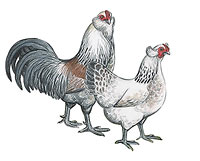 Murray McMurray Hatchery (tufted type) |
Araucanas have a rich and arguable history. Little is known of the origin of the Araucana except that some came from South America and they have the distinction of laying a blue or turquoise shelled egg. The first written evidence of the existence of blue eggs in Chile was in 1883. The characteristic for blue egg color is dominant and will occur in the offspring when this fowl is crossed with another breed of domestic chickens: hence, cross-breeds which lay blue or tinted eggs are often mistaken for Araucanas. [They] originated in a remote area of Chile ruled by fierce Araucana Indians who resisted European domination until the 1880’s.
The distinctive traits of blue egg, tufts and rumplessness originally were found in two distinct breeds from this region. The first breed, named “Collonocas”, laid blue eggs and was rumpless. There is circumstantial evidence that the blue egg color came from crosses of chickens with pheasants. While most hybrids are sterile, a small percentage is not. And the motive for crossing the two was the belief that the offspring made superior game fighting stock. The novelty of a blue egg meant that these rare fertile hens were used for breeding. The Persian Rumpless, a rumpless breed, was introduced by the Dutch during the colonial period and became widespread. The Araucana Indians preferred this trait since they believed that lack of tail feathers made it harder for predators to catch them.
The second breed, called “Quetros”, had unusual tufts, but was tailed and laid brown eggs. The tufts gene is the most mysterious of all. Presumably there was a mutation in a gene that resulted in these ornamental tufts. Left to natural selection the trait would soon die out because of its negative affects on the developing embryo. The gene mutation is lethal if two copies are present, and the embryo dies in shell. Even one copy of the gene is associated with about 20% mortality. Therefore, the Araucana Indians must have decided that it was a desirable trait and consciously propagated it.
The development of the modern Araucana breed begins with the great Chilean breeder, Dr. Ruben Bustros. As a young man in the Chilean army, he encountered the Araucana Indians in remote areas and observed their unique types of chickens during the 1880’s. He returned later and obtained some of the Quetros and Collonocas stock. Crossing these two breeds, over many years he developed tufted, rumpless birds that laid blue eggs, the first Araucanas. He was visited in 1914 by Professor Salvador Castello Carreras of Spain, who introduced them at the World Poultry Congress in 1918. Attempts to import Araucana stock into the United States over the years met with great difficulties. They were first imported into the United States in the early 1930's. However, there was no common goal among these few dedicated breeders until the 1960’s when Red Cox started an Araucana breeders group. His untimely death set things back, and it wasn’t until the late 1970’s that the Araucana was recognized as an official breed.
 |
Hen .................26 oz.
Rooster ..........30 oz.
Pullet ..............24 oz.
Cockerels ......26 oz.
Ideal Poultry Breeding Farms, Inc:
[Ameraucanas]: Ameraucana (Araucana) Bantams are clean leg, multicolored producers of multicolored eggs, primarily shades of blue and green. Ameraucanas are many times incorrectly called Araucanas. Ameraucanas have muffs, beards and tail heads. Araucanas have ear tuffs and do not have tail heads. Both of these characteristics present complicated breeding problems.
Standard weights at maturity are male-36 oz, and hen-34 oz.
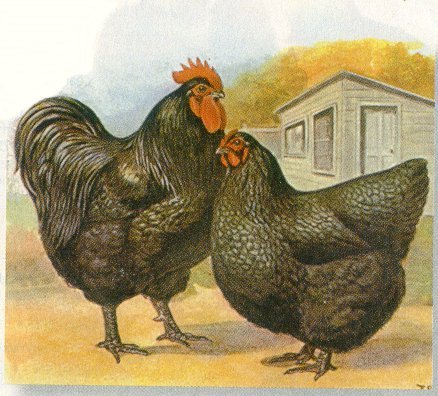
| Male Mature Weight: 8.5 lbs |
| Female Mature Weight: 6.5 lbs |
| Comb Type: Single |
| Egg Color: Brown
Egg Size: 25-26 Ounces/dozen Rate of Lay: "Excellent" |
| Type: Meat - Laying - Dual-purpose - Other |
| Setting: Average |
| Disposition/Temperament: Calm, friendly, good w/kids, stand confinement well |
| Climate Hardiness: All Climates, Winter-hardy [1], [2] |
| ALBC Priority: Recovering |
| Show Class: English |
This breed originated in Australia developed from Black Orpingtons imported from England; and the emphasis of the breeding program was on egg production without sacrificing too much in size and meat quality. Some sensational results were made in the Australian program, and one hen set a laying record of 364 eggs in 365 days. Introduced into this country in the 1920's, they have become useful and popular and are certainly one of the best layers of light brown eggs of all the heavy breeds. A flock of Black Australorps with their glossy black plumage which has a greenish-purple sheen and their larger than average bright red combs make an unusually handsome sight. They are big birds, cockerels weighing 6 to 8 pounds at maturity and pullets 5 to 7. They have a pinkish white skin and plump bodies which dress out nicely once the birds have their final plumage. Pullets mature early and many will be in production between 5 and 6 months of age. They are quiet, gentle, and stand confinement well. Baby chicks are black with a good deal of white in the underparts and small white patches around the head and wings. We have handled this breed for years and think it is one of the best of the heavy breeds.
Customer comments:
...The Black Australorps have always done very well and produce large brown eggs and LOTS of them!!! ...
- - -
We wanted chickens for our children. This breed of bird is so gentle, they practically became our
children. Easily handled and friendly. We had only 4 hens and I was giving eggs away because we couldn't
keep up! They are a beautiful black bird, I would recommend them to anyone, especially a chicken novice!
- - -
...The Black Austrolopes are gentle, and good layers.Fairly sturdy birds.Thanks alot!
- - -
These birds are #1!
- - -
I have been ordering black australorps along with other poultry for over ten years from Murray McMurray
When I was younger I showed alot of the poultry that I bought. I named one of my Black roosters Sidney,
he won the Grand Champion Pure Bred Large Breed award at the county fair three out of four years. I bred
him with some other quality Black hens and supplied the 4-H kids with show birds. Needless to say, I am
more than satisfied with the Black Australorps from Murray McMurray.
- - -
Of the five breeds that we purchased last June, this was the calmest and friendliest (second was the Buff
Orpingtons). These girls are queen layers too. I recommend them as all around great birds and my little
boys LOVE them.
- - -
I have raised many types of chickens and BLACK AUSTRALORPS is probably one of my all time favorites. They
are beautiful to watch, easy to raise, and also make great pets. My children always tame one or two of
this breed each raising. The hens will actually sit in wagons and wheelbarrows and be wheeled around. What
makes the chicken great is that it withstands the interaction with children very well.
Karen Moore,
Sanford, NC
- - -
This was our free chick, and it's one of our favorites! We love it! We're just going to keep our fingers
crossed it's a girl!
- - -
These birds are great. The hens are great layers, and the rooster is beautiful and takes care of his girls
well. I am happy to say that one of my hens just hatched out four cute little chicks and is a great mother.
Originated in Australia, bred for egg production and known for their shiny rich black feathering. Recognized by the American Standard of Perfection as a distinct breed of poultry in 1929 and makes an excellent winter laying hen.
Hen -------6 1/2 lbs
Rooster----8 1/2 lbs
Pullet------5 1/2 lbs
Cockerel--7 1/2 lbs
Ideal Poultry Breeding Farms, Inc:
One of the hardiest of all breeds- Excellent small flock producer.
Black Australorps are one of the most popular producers of large brown eggs and they are known for persistency of lay even in hot weather. The green sheen of this solid black plumage bird presents a truly beautiful sight, particularly when the sun is reflecting off the plumage.
Standard weights at maturity are males-8 1/2 lbs. and hens-5 1/2 lbs.
The Black Australorp is originally from Australia and became internationally popular in the 1920s for their strong egg laying. They are a large, soft-feathered bird with glossy black feathers having a green tint. They have a single comb with five points that stand upright. Black Australorps are considered to be a docile bird and a good dual purpose breed. Well maintained hens can lay approximately 250 eggs annually.
Comb: Single
Standard weight at maturity: Hens 5 ½ lbs, males 8 ½ lbs.
Egg color: Brown
See also: Backyard Chickens.com: Australorp [NAH]
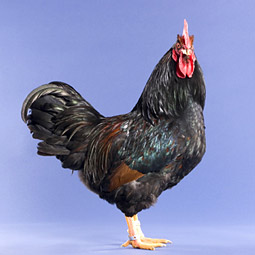 Rooster |
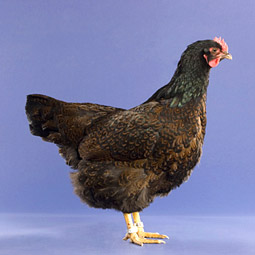 Hen MyPetChicken |
| Male Mature Weight: 6 lbs |
| Female Mature Weight: 5 lbs |
| Comb Type: Single |
| Egg Color: Brown to Very dark brown
Egg Size: Medium to Large Rate of Lay: 180-200/year |
| Type: Meat - Laying - Dual-purpose - Other |
| Setting: Not a lot |
| Disposition/Temperament: Quiet, bears confinement well |
| Climate Hardiness: All Climates, Winter-Hardy [1], [2] |
| Show Class: Continental (Northern European) |
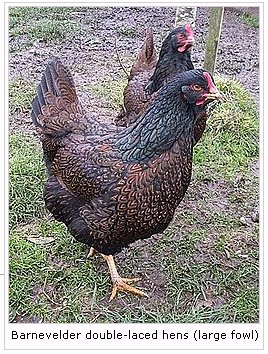 Wikipedia |
Barnevelders are a rare breed that originated in Holland. They are best known for the production of very dark brown eggs. The plumage is very tight and of nice texture. Much of the plumage is either black, reddish brown with lustrous greenish black lacing or black with reddish brown edging. The plumage is very tight, of nice texture and displayed in a pattern known as double-laced partridge. They have yellow skin, shanks and toes.
Standard weights at maturity are males- 6 lbs. and hens- 5 lbs.
Wikipedia: [NAH]
...The breed gained worldwide recognition and was exported to many countries because of its ability to lay approximately 180-200 large brown eggs per year.
...Barnevelders are bred both as a utility breed and a show breed. They are medium heavy dual-purpose chickens laying a good number of eggs but also yielding a reasonable carcass. They are hardy birds and good foragers. While they became famous for their dark brown eggs in the first half of the 20th century most birds now appear to be in the hands of show breeders and not much attention has been given to maintaining the dark brown egg colour or to productivity with the focus being on external characteristics instead. Many flocks now lay eggs of a much lighter brown than before and are sometimes not quite as productive as befits their reputation. They are good winter layers and have a quiet disposition.
...
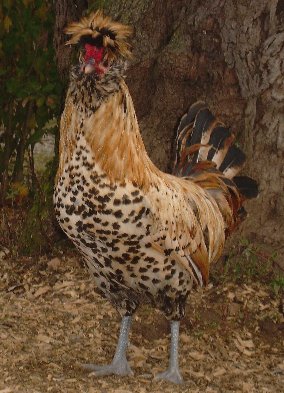 Cream Brabanter rooster - Show Me Silkies. |
Feathersite. Notice the resemblance to the Spitzhauben. 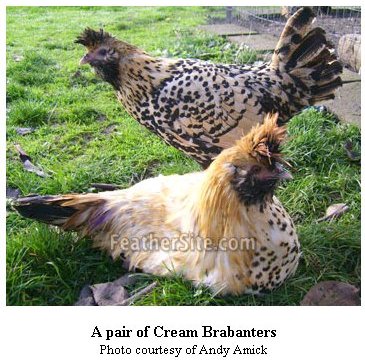 |
| Male Mature Weight: 7 lbs |
| Female Mature Weight: 5.5 lbs |
| Comb Type: V with feathered crest |
| Egg Color: White
Egg Size: "Large" Rate of Lay: "Medium", 150 eggs/year |
| Type: Meat - Laying - Dual-purpose - Other |
| Setting: No |
| Disposition/Temperament: Said to be docile, may be flighty, OK in confinement |
| Climate Hardiness: All Climates [1] |
Ideal Poultry Breeding Farms, Inc:
Cream Brabanters are a very rare, white egg variety, Brabanters either originated in the Netherlands or the Southeast Districts of Belgium. All indications are that this is a very ancient breed. Paintings from the 16th and 17th Centuries show fowl that look like this breed. The most recognizable characteristics of this breed are the flat-sided, upright crest with front feathers bent a little forward and their well-developed muffs and beard which form three lobes that cover the cheek and chin. All of the plumage of Cream Brabanters is cream with each feather ending with a half-moon black spangle; however, the tail may be entirely black.
Standard weights at maturity are males-7 lbs. and hens-5 1/2 lbs.
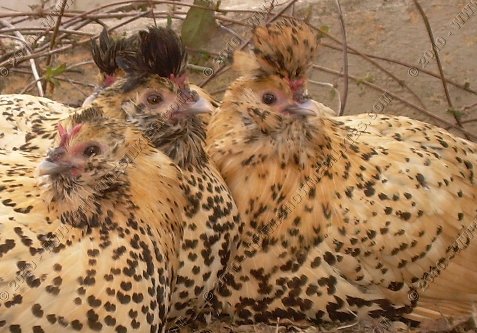 A cozy pile of pullets. You can see their "V" combs. Show Me Silkies |
This age old standard Chicken, with its pointy comb resembling horns, bluish tinted legs and beak is extremely rare and critically endangered. Paintings from the 16th and 17th centuries show chickens that resemble the Brabanters. A very old Dutch breed that became extinct around 1900 and was re-created again in 1920. Brabanter chickens are more intelligent than many chickens. They are good foragers. They are good at flying and climbing. Hens lay 150 large eggs a year and occasionally hens will go broody. They lay more eggs in the winter than most chickens. They are a good dual purpose breed for meat and eggs.
Very rare in the US, though there are some here, in Cream and Gold varieties. The Gold and Cream plumage color both have black, half moon spangle on each feather. Its narrow, flattened crest, The crest points forward like women used to wear in the Appenzellerland of the Netherlands. Thus sometimes Brabanters are called Appenzellers. Three cornered beard and its peculiar V-shaped comb with 2 small rounded spikes (also called horns). Their beak is large with deep nostrils and a fleshy knob at the front of the beak. The wattles are fine and long. The ear lobes are white and oval shaped. This "new" Brabanter is not as large as the original seems to have been, but it surely is a most attractive fowl.
Nantahala Farm: [NAH for this breed]
Brabanters are a very old Dutch breed that lay a large white egg. Paintings from the 16th and 17th centuries show chickens that resemble the Brabanter. They went extinct in the 1900s but were recreated in 1920. Cocks weigh 7 pounds and hens weigh 5 1/2 pounds. Brabanters have a V-shaped comb with 2 small rounded spikes. The crest points forward like women used to wear in the Appenzellerland of the Netherlands. Thus sometimes Brabanters are called Appenzellers. The wattles are fine and long. The ear lobes are white and oval shaped. Their beak is large with deep nostrils and a fleshy knob at the front of the beak. Their eyes are brown. They do not have feathers on their legs.
Brabanter chickens are more intelligent than many chickens. They are good foragers. They are good at flying and climbing. Since they have small wattles and combs, they are not prone to frostbite. Brabanters do all right in confinement and are fairly docile except for roosters who are sometimes aggressive.
Hens lay 150 large eggs a year. They lay more eggs in the winter than most chickens. They can sometimes be broody. They are a good dual purpose breed for meat and eggs. Branbanter chickens are extremely rare and critically endangered.
Feathersite: (NAH)
"The information on this breed is thanks to Elly Vogelaar of Aviculture Europe.
"The Brabanter is a very old Dutch breed that became extinct around 1900 and was re-created again in 1920. This "new" Brabanter is not as large as the original seems to have been, but it surely is a most attractive fowl, with its narrow, flattened crest, its three cornered beard and its peculiar comb with the two v-shaped horns. The recognized colours are: black, blue, white cuckoo, gold (the plumage is golden bay with a black, half moon spangle on each feather), silver (silver with black markings), and chamois (buff with white markings).
"They are non-sitters and lay a good-sized white egg. Brabanters are said to do OK in confinement and to be fairly docile.
...
"Brabanters are very rare in the US, though there are some here, in Cream and Gold varieties."
On Clinch Mountain: (NAH)
Fun blog about sheep and snakes and chickens and everything... oh, and occasionally, the local Brabanter.
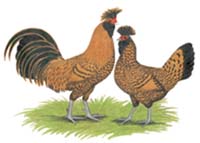 |
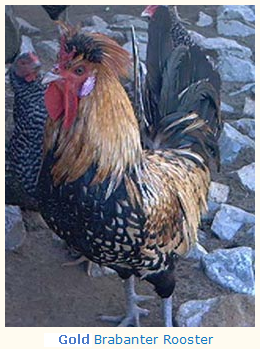 Nantahala Farm. This is a Gold Brabanter per Show Me Silkies. |
| Male Mature Weight: 7 lbs |
| Female Mature Weight: 5.5 lbs |
| Comb Type: V, with feathered crest |
| Egg Color: White
Egg Size: "Large" Rate of Lay: "Medium", 150 eggs/year |
| Type: Meat - Laying - Dual-purpose - Other |
| Setting: No |
| Disposition/Temperament: Said to be docile, may be flighty, OK in confinement |
| Climate Hardiness: All Climates [1] |
Ideal Poultry Breeding Farms, Inc:
Gold Brabanters are a very rare white egg variety. A discussion of Brabanter history is contained in the Cream Brabanters paragraph. Brabanters have the appearance of strong, hardy birds with very large bodies; although, they are not heavy in bone. The most recognizable characteristics of Brabanters are the flat-sided, upright crest with the front feathers bent a little forward and their well-developed muffs and beard which form three lobes that cover the cheek and chin. All of the hard, tight plumage of Gold Brabanters is gold with each feather ending with a half-moon black spangle; however, the tail may be entirely black.
Standard weights at maturity are males-7 lbs. and hens-5 1/2 lbs.
This age old standard Chicken, with it's pointy comb resembling horns, bluish tinted legs and beak is extremely rare and critically endangered. Paintings from the 16th and 17th centuries show chickens that resemble the Brabanters. A very old Dutch breed that became extinct around 1900 and was re-created again in 1920. Brabanter chickens are more intelligent than many chickens. They are good foragers. They are good at flying and climbing. Hens lay 150 large eggs a year and occasionally hens will go broody. They lay more eggs in the winter than most chickens. They are a good dual purpose breed for meat and eggs.
Very rare in the US, though there are some here, in Cream and Gold varieties. The Gold and Cream plumage color both have black, half moon spangle on each feather. Its narrow, flattened crest, The crest points forward like women used to wear in the Appenzellerland of the Netherlands. Thus sometimes Brabanters are called Appenzellers. Three cornered beard and its peculiar V-shaped comb with 2 small rounded spikes (also called horns). Their beak is large with deep nostrils and a fleshy knob at the front of the beak. The wattles are fine and long. The ear lobes are white and oval shaped. This "new" Brabanter is not as large as the original seems to have been, but it surely is a most attractive fowl.
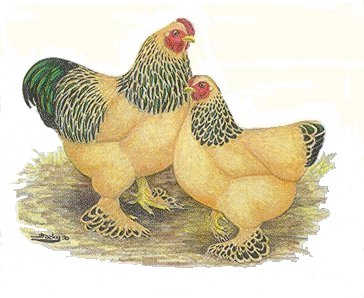
| Male Mature Weight: 12 lbs |
| Female Mature Weight: 9.5 lbs |
| Comb Type: Pea |
| Egg Color: Brown
Egg Size: Medium to Large Rate of Lay: ~3/week |
| Type: Meat - Laying - Dual-purpose - Other |
| Setting: Yes |
| Disposition/Temperament: Very quiet and gentle, tolerates confinement |
| Climate Hardiness: All Climates, Winter-hardy [1], [2] |
| ALBC Priority: Watch |
| Show Class: Asiatic |
These have the same large size and quiet temperament of the other Brahmas. They were developed much later, however, and are still very rare. The color pattern is the same as the Light Brahma except that the white sections are replaced by golden buff. The black markings are identical on both varieties. The buff and black combination and great size make this variety a truly beautiful and regal bird. Buff Brahmas lay brown eggs, will set, are gentle, and are very nice show birds.
Customer comments:
Buff brahmas are the smartest chickens I have ever had. They do very well as a show bird or as a
pet! Thank you McMurray Hatchery!
- - -
I am so pleased with my Buff Brahamas. They are large gentle creatures just as you stated in the
catalog. Thanks so much!
- - -
Buff Brahmas are a very gentle bred of large fowl. They are a rarer bred and are extreamly good for
4-H shows. Thanks for having this bred, McMurray Hatchery.
- - -
We love our Buff Brahma pair. We originally wanted just hens in our hen house, but were pleasantly
surprised to get a lovely Buff Brahma rooster and a hen. He is timid yet very polite around our kids.
He is stunning to look at, and his crow is wonderful and unique. He is very proud. A great rooster for
our family flock. Thanks!
Originated in Asia and brought to this country in mid-1800's. Brahmas are exceptionally quiet, gentle, and easy to handle. Their small pea comb, great size, and heavy plumage make them almost immune to cold weather. The hens are good layers of brown eggs, excellent brood mothers and very children friendly for pets.
Hen-----------9 1/2 lbs
Rooster-------12 lbs
Pullet--------- 7 lbs
Cockerel----- 9 lbs
Ideal Poultry Breeding Farms, Inc:
Buff Brahmas are a very rare variety that are hatched by only a few hatcheries. Brahmas, which originated in India, have a unique stately appearance. They have massive bodies, pea combs and fully feathered shanks and toes. Brahmas grow at a relatively slow rate and are not a good choice for producing broiler meat. The hens which lay medium sized brown eggs, and are useful for fowl meat when their use for laying is over.
Standard weights at maturity are males-12 lbs. and hens-9 1/2 lbs.
Buff Brahmas originated in India and are an especially rare variety hatched by very few hatcheries here in the United States. They are a large bodied breed that has a beautiful golden buff and black feather pattern, and fully feathered shanks and toes. Like other Brahmas, they have a quiet disposition, and make wonderful show birds, but are also considered a good dual purpose breed.
Comb: Pea.
Standard weight at maturity: Hens 9 ½ lbs, males 12 lbs.
Egg color: Brown
See also: Backyard Chickens.com: Brahma [NAH]
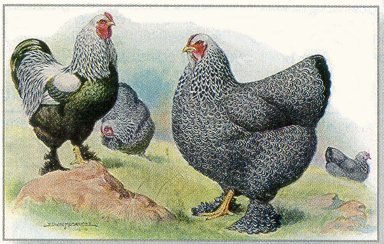
| Male Mature Weight: 12 lbs |
| Female Mature Weight: 9.5 lbs |
| Comb Type: Pea |
| Egg Color: Brown
Egg Size: Medium to Large Rate of Lay: ~3/week |
| Type: Meat - Laying - Dual-purpose - Other |
| Setting: Yes |
| Disposition/Temperament: Very quiet and gentle, tolerates confinement |
| Climate Hardiness: All Climates, Winter-hardy [1], [2] |
| ALBC Priority: Watch |
| Show Class: Asiatic |
Large gentle chickens like the Light Brahmas. Striking plumage color in black and silvery white for males and beautiful silver penciled steel gray for females. Developed from Asiatic fowl brought to New England by China clipper ships in the last century.
Customer comments:
My experience with dark brahma chickens has been nothing but positive. The friendliest hen I ever
owned was a beautiful dark brahma hen. They are very quiet and have a very pleasant temperament.
Ideal Poultry Breeding Farms, Inc:
Dark Brahmas, which lay brown eggs, are a very beautiful silver penciled plumage patterned bird that has a stately stature. This variety, which is beautiful, and unique, is rare and hatched by only a few hatcheries. They have massive bodies, pea combs and fully feathered shanks and toes. They are very hardy and have a quiet temperament, that makes them an excellent choice for pets. Although the adults are very large, Brahmas grow at a relatively slow rate and are not a good choice for producing broiler meat. Mature hens can be used for fowl meat when their use for laying is over.
Standard weights at maturity are males-12 lbs. and hens-9 1/2 lbs.
See also: Backyard Chickens.com: Brahma [NAH]
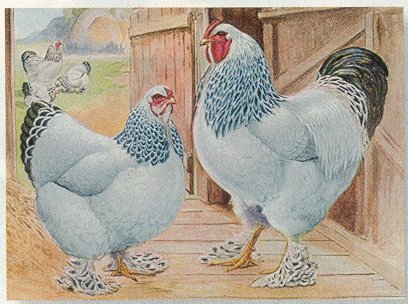
| Male Mature Weight: 12 lbs |
| Female Mature Weight: 9.5 lbs |
| Comb Type: Pea |
| Egg Color: Brown
Egg Size: 24-25 Ounces/dozen Rate of Lay: "Good" |
| Type: Meat - Laying - Dual-purpose - Other |
| Setting: The hens will set. |
| Disposition/Temperament: Very gentle, peaceful, good with kids, tolerates confinement |
| Climate Hardiness: All Climates, Winter-hardy [1], [2] |
| ALBC Priority: Watch |
| Show Class: Asiatic |
The Brahmas are a very old breed from Asia, probably originating in India and brought to this country about 1850 by Yankee sailors on their return from trading in Far Eastern ports. Because of its massive size, full feathered shanks and toes, and striking black and white plumage pattern, it has always been one of the most interesting varieties to work with. Brahmas are exceptionally quiet, gentle, and easy to handle. Their small pea comb, great size, and heavy plumage make them almost immune to cold weather. The hens are good layers of brown eggs, especially in winter, and will also set. Cockerels develop a tremendous frame, grow rather slowly, but when fully fleshed make a beautiful roasting chicken. They are easy to dress with light plumage and yellow skin. Baby chicks are creamy white, but some have shades of gray on the back.
Customer comments:
Loved these chickens! Quiet and beautiful. The rooster is an excellent peaceful bird.
- - -
These are the best chickens ever! You couldn't ask for any better. They have a wonderful temperment, and are
great around kids. The babies are very hardy especially in the winter time. I was very pleaed with my order of
baby chicks. Thanks McMurray!
- - -
Thank you so much for my healthy Brahmas & Orpingtons. I had brought several of your medicines and wormer
products but thus far I havent had to use them ! In my small town, news of my chickens from Iowa spread and we
have had many visitors to see them.
- - -
My light brahmas, orpingtons, and black giants are some of the most gentle birds. They are more like pets.
They serve their purpose well and yet are very fun and enjoyable. Thanks for standing by your items.
- - -
I have been around chickens all my life, but have never had any that were as gentle and friendly as the Light
Brahmas. Many a time I would find my 10 year old daughter sitting in the pen with little chicks roosting all
over her. They are 1 year old now and are great pets. Even the rooster is gentle enough to pick up and pet.
- - -
Thanks for your wonderful chicks. I have ordered twice now, and have gotten heathy chicks, and great customer
service as well. I love my light brahma "Griz"-he is a big pet. I also ordered cornish-x meat birds--I was so
impressed with their growth--one was so large he didnt fit in a gallon ziplock bag when we butchered! Thanks
for your excellent chicks!!
- - -
Of the 4 heavy breeds we purchased, the Light Brahma is far and away our favorite. Sturdy, intelligent,
active, friendly, and the least liable to pick or harass -- next time, it will make up our entire chick order.
Thanks for such healthy birds!
- - -
We just got 9 light Brahmas and all of them are doing great. They are my favorite of the 5 breeds we got.
Thanks for the awesome chicks.
- - -
I love these Chicks. they are growing fast and are so gentle. Thanks Mcmurry!
- - -
I love this breed of pleasant, peaceful egg laying olympians! All winter long, there was no lapse in
production. Even the rooster is a gentle giant. A beautiful size for roasting, though I have not tried them yet.
Originated in Asia and brought to this country in mid-1800's. Brahmas are exceptionally quiet, gentle, and easy to handle. Their small pea comb, great size, and heavy plumage make them almost immune to cold weather. The hens are good layers of brown eggs, excellent brood mothers and very children friendly for pets.
Hen-----------9 1/2 lbs
Rooster-------12 lbs
Pullet--------- 7 lbs
Cockerel----- 9 lbs
Ideal Poultry Breeding Farms, Inc:
Tall, beautiful breed with white feathers on legs and both white and black feathers covering toes.
Light Brahmas, which lay brown eggs, originated in India. They are the most popular variety of Brahmas. They are very attractive and have a stately stature. They have a beautiful, striking black and white Columbian plumage color pattern. They have massive bodies, pea combs, and fully feathered shanks and toes. Their growth rate is relatively slow and, therefore, are a poor choice for producing broiler meat. Mature hens can be used for fowl meat when their use for laying is over.
Standard weights at maturity are males-12 lbs. and hens-9 1/2 lbs.
Light Brahmas are thought to have originated in India and were introduced to the United States in the 1800’s. They are a hefty breed with a prominent black and white Columbian plumage color pattern and fully feathered shanks and toes. Although they make a fine roaster, their relatively slow growth rate makes them a poor choice economically as a meat bird.
Comb: Pea.
Standard weight at maturity: Hens 9 ½ lbs, males 12 lbs.
Egg color: Brown
See also: Backyard Chickens.com: Brahma [NAH]
and here's a lovely picture.
The first broilers were hybrids of Cornish x large-boned Plymouth Rocks, created in the 1930s, which became the major kind of broiler by the 1960s. However, due to their extremely fast growth rate, this cross is prone to leg problems and other ailments. Modern broiler strains are a more complicated cross (4 grandparents) which makes them sturdier but they still won't breed true. - ed]
See Wikipedia link for a more detailed discussion of broilers.
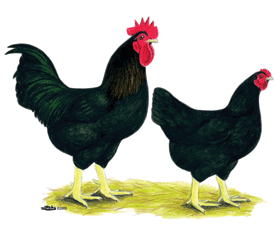
| Male Mature Weight: 6 lbs+ |
| Female Mature Weight: 6 lbs+ |
| Comb Type: Single |
| Egg Color: Brown
|
| Type: Meat - Laying - Dual-purpose - Other |
| Setting: N/A |
| Disposition/Temperament: [Unknown] |
Black Broilers are very efficient producers of broiler meat, especially for those who prefer the darker skin variety of broilers. Although considered a slower developing meat bird than Cornish Rocks, they can reach approximately 6 pounds in as little as 8 weeks. These darker plumage meat birds are more active and will generally have fewer leg and fluid retention concerns than the faster developing Cornish Rock. They are brown egg layers, but not considered a good choice as an efficient producer of brown eggs.
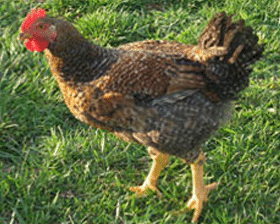
| Male Mature Weight: 4-5 lbs+ |
| Female Mature Weight: 4-5 lbs+ |
| Comb Type: Single |
| Egg Color: [Unknown]
|
| Type: Meat - Laying - Dual-purpose - Other |
| Setting: N/A |
| Disposition/Temperament: [Unknown] |
The Color Range breeding stock is imported from the regions of Burgundy and Brittany (France). The genetic stock is derived from the American and European old heritage breed of chicken and was developed in the early 1960’s to meet the highest standards of the French Label Rouge Free Range program. Currently, the Colored Range genetic stock is used by most non-factory farm production models (alternative) all across Europe and also by small pastured poultry producers in search of a traditionally raised farm chicken - just like the "oldies", healthy and with a succulent flavor and texture.
Since the Colored Range Broilers are a slower growing breed, they are naturally better suited to the higher welfare and all true natural rearing systems (full pasturing, free range, organic, certified, backyard etc.…). In the United States most modern poultry industrial production models use fast growing breeds (hybrid white synthetic Cornish crosses).
Natural instinct and behavior is preserved in the selection and growing methods of the Colored Range breeding stock. It goes without saying that our birds love foraging in pastures, free ranging outside, always looking for natural sunlight and fresh air, as well as ground scratching and dust bathing.
We strongly believe in traditional, sustainable, and environmentally friendly farming methods, and we are convinced that allowing the chickens to do what comes naturally ensures an incredible meal for your table!
Based on the results and experiences of our own flocks and our customers’ flocks, the Colored Range assortment will reach 4 to 5 LBS Live Weight in a minimum of 9 weeks and a maximum of 11 weeks. In no way does this data constitute a warranty or guarantee of the same performance as conditions of nutrition, management, health, density or physical and biological environments (weather and relief) vary from producers to producers.
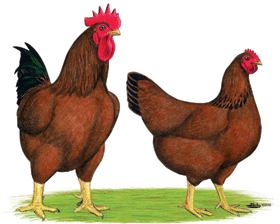
| Male Mature Weight: 6 lbs+ |
| Female Mature Weight: 6 lbs+ |
| Comb Type: Single |
| Egg Color: Brown
|
| Type: Meat - Laying - Dual-purpose - Other |
| Setting: [Unknown] |
| Disposition/Temperament: [Unknown] |
Red Broilers are very efficient producers of broiler meat, especially for those who prefer the darker skin variety of broilers. Although considered a slower developing meat bird than Cornish Rocks, they can reach approximately 6 pounds in as little as 8 weeks. These darker plumage meat birds are more active and will generally have fewer leg and fluid retention concerns than the faster developing Cornish Rock. They are brown egg layers, but not considered a good choice as an efficient producer of brown eggs.
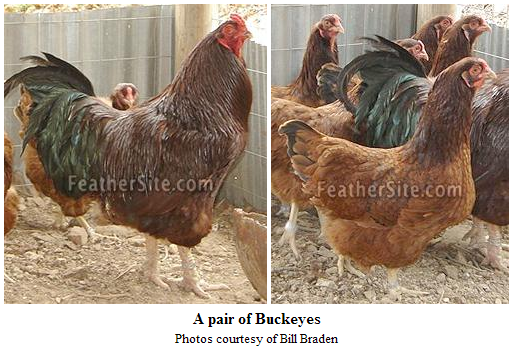 Feathersite |
| Male Mature Weight: 8 lbs |
| Female Mature Weight: 5.5 lbs |
| Comb Type: Pea |
| Egg Color: Brown
Egg Size: "Medium" Rate of Lay: 150-200/year |
| Type: Meat - Laying - Dual-purpose - Other |
| Setting: "Average" |
| Disposition/Temperament: Generally calm, but assertive. Can be noisy. Tolerates confinement but prefers free range. |
| Climate Hardiness: All Climates [1] |
| ALBC Priority: Critical |
| Show Class: American |
Ideal Poultry Breeding Farms, Inc:
Buckeyes are a rare American breed originating in Ohio, the "Buckeye State", with color similar to the richly colored buckeye nut. All of the general surface plumage is an even shade of rich mahogany bay in all sections with the exception of the unexposed primaries and secondaries and the main tail feathers that may contain black. They have stout muscular thighs, broad, well rounded breasts and pea combs. They are known as a dual-purpose breed that is mainly kept for the production of brown eggs.
Standard weights at maturity are males-8 lbs. and hens-5 1/2 lbs.
Wikipedia: [NAH]
...Created in the late 19th century, Buckeyes are the only breed of American chicken known to have been created by a woman, and the only one to have a small "pea" comb. As of 2008, Buckeyes are extremely rare, and breed conservation organizations have recognized them as critically endangered... They are a dual-purpose chicken that have a decent laying ability and strong meat production characteristics. Buckeyes are yellow skinned chickens who lay brown eggs.
The Buckeye was first bred and developed in 1896, by a Warren, Ohio resident named Nettie Metcalf... Metcalf crossbred Barred Plymouth Rocks, Buff Cochins, and some black breasted red games to produce the Buckeye. Her goal was a functional breed that could produce well in the bitter Midwest winters...
... It also bears some traits of Game fowl in frame and disposition, being assertive in character and a very good forager. Generally calm, the cock birds in rare cases may become aggressive. Despite its game heritage, it tolerates confinement well, although it will be much happier and produce better if allowed to range on grass. The Buckeye is said by breeders to be disinclined towards feather picking. A good meat producer and layer of between 150 to 200 eggs per year, the Buckeye is a dual purpose chicken well–suited to small farmyard and backyard flocks.
See also: Backyard Chickens.com: Buckeye [NAH]
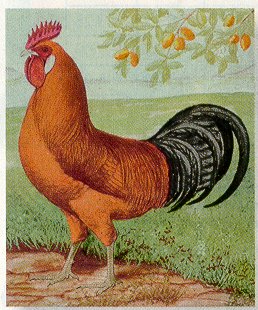
| Male Mature Weight: 6.5 lbs |
| Female Mature Weight: 5 lbs |
| Comb Type: Buttercup |
| Egg Color: Brown
Egg Size: 'Small' Rate of Lay: ~2/week |
| Type: Meat - Laying - Dual-purpose - Other- "Ornamental" |
| Setting: Seldom |
| Disposition/Temperament: Active, Calm and friendly, need to roam |
| Climate Hardiness: Heat, not winter-hardy [1], [2] |
| ALBC Priority: Threatened |
| Show Class: Mediterranean |
This interesting breed was imported from the island of Sicily over 100 years ago and is another member of the Mediterranean class. It has attracted wide-spread interest over the country because of its unique beauty. The golden color and cup-shaped comb are the basis for the very descriptive name. The comb is a cupshaped crown with a complete circle of medium sized regular points. The male and female do not look alike in coloring. The males are a rich, brilliant orange red with some black spangles in the feather of the body fluff and cape feathers at the base of the hackle; with lustrous, greenish black tail. The base color of the female is buff with all feathers on the body marked by parallel rows of black elongated spangles, giving the hen an appearance of being beautifully spotted and suggesting a ringneck pheasant hen. Skin color is yellow and shanks and toes are a willow green. Because of its unusual appearance the Buttercup is an excellent breed for exhibition projects.
Customer comments:
I loved the Buttercup pullets that came in my Ornamental Layer collection. They are fairly calm, with big,
brown eyes and are great little layers. Confirmation, leg color, and combs are close to perfect.
- - -
I have purchased several varieties and I can say without reservation that Buttercups are my favorite!!!
They are friendly, fun and inquisitive. They always try to sit on my shoulder when I am cleaning and feeding!
- - -
I had some Buttercups in my home flock, and mine seemed very laid back. They are a beautiful breed.
- - -
We have several breeds of chickens that we keep free-range and the Buttercups are one of our favorites!
They are very friendly and love to fly up and sit on your arm or shoulder whenever they see you. Excellent
flyers. For chickens and while eggs are a small-to-medium size, they are very reliable layers. Great chickens
as pets or for first time owners of chickens!
- - -
Thank you once again. This is our second batch of chicks we have ordered from you in year, and can't be any
happier! Our girls we got last year gave us our first brown egg the day they turned 4 months old. We are
loving them all so much! Thank you again Alice & Rob Fey (Happy Hens Eggs)
- - -
I received 1 female and 1 male Buttercup last spring, and a female this spring. The 2 females both love to
fly on my arm when I'm in the pen. The male Buttercup is the prettiest rooster I have ever seen and he
has a beautiful crow that is lovely to listen to. -Thanks
- - -
The Sicilian Buttercup was reportedly imported to America in 1835 and not until 1918 admitted to
the American Standard of Perfection.
The Sicilian Buttercup originated in Sicily. It has a beautiful cup-shaped comb. A great barnyard or
show fowl that is sure to please everyone.
Hen ------ 5 lbs
Rooster ---6 1/2 lbs
Pullet------4 lbs
Cockerel--5 1/2 lbs
Ideal Poultry Breeding Farms, Inc:
Sicilian Buttercups are a very unique breed. They are the only breed with a distinctive cup-shaped comb consisting of two single comb rows that form a complete circle. They are very active, good hustlers and considered to be non-setters, which lay white eggs. Males, with lustrous, reddish orange plumage, are much darker than the females, which have a beautiful, golden buff plumage color pattern that is unique to this breed.
Standard weights at maturity are males-6 1/2 lbs. and hens-5 lbs.
Sicilian Buttercups are a breed originating in Sicily, Italy and brought to the United States over 100 years ago. These medium sized birds lay smaller sized eggs and are typically enjoyed for their aesthetics. The cockerels have a large cup-shaped comb that is unique in the world of poultry. Both males and females are similar in their very rich and bright orange, red, and black feathers.
Comb: Buttercup.
Standard weight at maturity: Hens 4 ½ lbs.
Egg color: White
Wikipedia: [NAH]
...Eggs are small and can be colored anywhere from white to heavily tinted. They are good fliers and free-ranging Buttercups will often be seen perching in elevated areas such as fencetops, haylofts, trees, and arbors.
See also: Backyard Chickens.com: Sicilian Buttercup [NAH]
Campine is an older European breed that is a descendant of the Kempishe Brakel.The are named Campine because they originated in the north east area of Belgium called Campine. People in that region say the Campine has been around since the time of the Roman caesars.
The name is pronounced kam-peen... They have a long back and carry their tail very upright. Males weigh average 5-6 lbs and hens are around 4-5 lbs. Their single comb is fairly large and often flops over. The combs are susceptible to frostbite... They feather quickly but mature relatively late. They lay an average 3 eggs per week. While they are considered a egg production hen, they are primarily kept for ornamental purposes. Campines tolerate confinement [but] they do much better if allowed to free range... Silver Campines look very similar to Egyptian Fayoumis as chicks. The head and neck feathering will be a more pure white rather than the silver/grey of the Fayoumi’s. Per the standard, the black barring on the Campine should be iridescent; this is not true of the Fayoumi. The Campine will have lead colored legs vs the Fayoumis will be slate colored or willow green. Campines' feather pattern is barred and Fayoumi’s are more penciled...
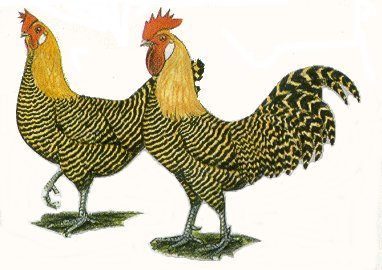
| Male Mature Weight: 6 lbs |
| Female Mature Weight: 4 lbs |
| Comb Type: Single |
| Egg Color: White
Egg Size: "Medium" Rate of Lay: ~3/week |
| Type: Meat - Laying - Dual-purpose - Other |
| Setting: "Don't go broody." |
| Disposition/Temperament: Friendly but flighty, intelligent, tolerates confinement |
| Climate Hardiness: All Climates, Winter-hardy but prone to frostbite [1], [2] |
| ALBC Priority: Critical |
| Show Class: Continental |
This is a very old and rare breed which originated in Belgium. Golden Campines feature a beautiful combination of lustrous black and golden bay to make the distinctive barred feather pattern. They are rather small and lay white eggs. The chicks are the most highly colored we hatch, showing a bright zigzag pattern of black, brown, and white stripes.
Customer comments:
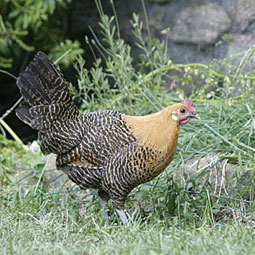 Hen... My Pet Chicken |
Ideal Poultry Breeding Farms, Inc:
Golden Campines, which have a distinct golden plumage pattern, have white skin, are excellent white egg producers and normally do not go broody. They have been bred for production of white-shelled eggs for several centuries. They are very rare and are kept primarily for display and exhibition because of their strikingly beautiful plumage. The male and female color patterns are uniquely the same because Campine males possess a modified form of "hen feathering." The Silver Campine paragraph has additional information about Campines.
Standard weights at maturity are males-6 lbs. and hens-4 lbs.
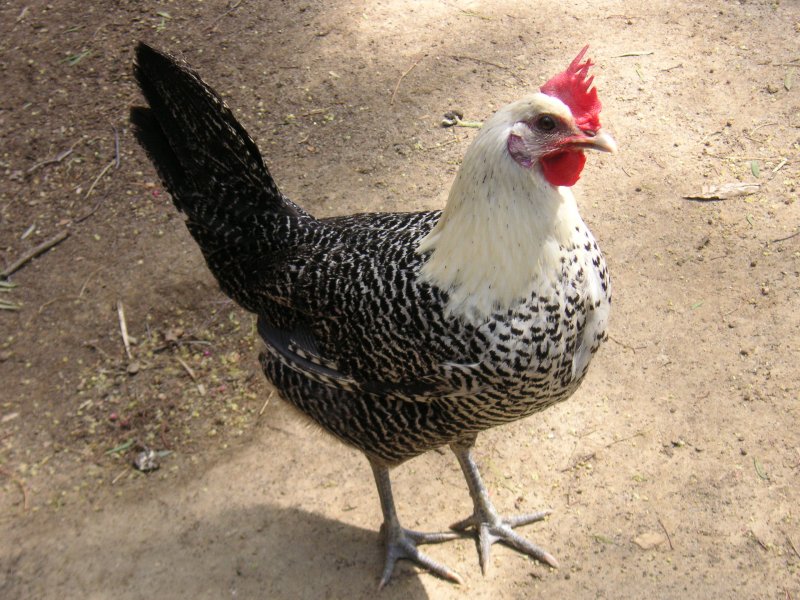 BackyardChickens.com |
| Male Mature Weight: 6 lbs |
| Female Mature Weight: 4 lbs |
| Comb Type: Single |
| Egg Color: White
Egg Size: "Medium" Rate of Lay: ~3/week |
| Type: Meat - Laying - Dual-purpose - Other |
| Setting: "Don't go broody." |
| Disposition/Temperament: Friendly but flighty, intelligent, tolerates confinement |
| Climate Hardiness: All Climates, Winter-hardy but prone to frostbite [1], [2] |
| ALBC Priority: Critical |
| Show Class: Continental |
Ideal Poultry Breeding Farms, Inc:
Silver Campines are the best-known variety of Campines, have white skin, are excellent white egg producers and normally do not go broody. This breed was named after Campine Country in Belgium where they originated. The male and female color pattern is uniquely the same because Campine males possess a modified form of "hen feathering". Campine males have saddle and hackle feathers while Sebrights, which are a true "hen feathered" breed (Hf Hf), have neither saddle nor hackle feathers. The Golden Campine paragraph has additional information about Campines.
Standard weights at maturity are males-6 lbs. and hens-4 lbs.
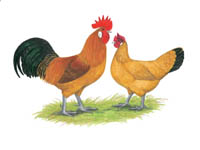
| Male Mature Weight: 8 lbs |
| Female Mature Weight: 6 lbs |
| Comb Type: Single |
| Egg Color: White
Egg Size: "Medium" Rate of Lay: ~4/week |
| Type: Meat - Laying - Dual-purpose - Other |
| Setting: Seldom |
| Disposition/Temperament: Flighty, active, shy, does not tolerate confinement |
| Climate Hardiness: Heat, not winter-hardy [1], [2] |
| ALBC Priority: Watch |
| Show Class: Mediterranean |
Ideal Poultry Breeding Farms, Inc:
Buff Catalanas, which originated in Spain, have become popular in Latin American Countries but are extremely rare in the U.S. They are a dual-purpose breed, with pinkish white skin, that produces both meat and large white-shelled eggs. They are one of the largest white egg breeds. Their shanks and toes are bluish slate. They have black tails, while the remainder of the plumage is buff to reddish buff.
Standard weights at maturity are males-8 lbs. and hens-6 lbs.
Backyard Chickens.com: [NAH]
Developed in Spain, near Barcelona, as a dual purpose bird. First exhibited in 1902 at the Madrid World's Fair. Popular in Latin America due to good heat tolerance, rare in North America.
Also known as Buff Catalana, or Catalana del Prat Leonada, or just Prat. Eggs vary from white to light cream or light pinkish. Body from light buff to golden-red, tail iridescent greenish-black. Legs not feathered, slate to greenish; earlobes white, wattles red. Comb single with 6 points, erect in males, can be floppy in females. Chicks buff, with or without faint chipmunk markings. Hardy, active, good foragers. Hens are said to be unlikely to go broody, but one of my two did so within a few months of first laying. Said to be the best meat bird of the Mediterranean breeds. My two Catalana hens are not really friendly to humans, but also are not aggressive.
...The only native Canadian breed, the Chantecler was developed in the early 20th century, at the Abbey of Notre-Dame du Lac in Oka, Quebec. It is extremely cold-resistant, and is suitable for both egg and meat production.
At the dawn of the 20th century, no breeds of chicken had been established in Canada, and Canadian farmers and poultry fanciers only had fowl of European and American derivation. This fact was noted by Brother Wilfred Chantelain, a Trappist monk and Doctor of Agronomy, as he toured the poultry flocks of the Oka Agricultural Institute, an agricultural school at his abbey which is affiliated with the Université de Montréal.
In 1907, the Brother set out to remedy this void and create a practical chicken that would be suited to Canada's climate and production needs. Working at the Abbey of Notre-Dame du Lac in Oka, Chantelain first combined Dark Cornishes, White Leghorns, Rhode Island Reds, White Plymouth Rocks and White Wyandottes, creating the White variant of the Chantecler...
At the outset, it was only intended for the breed to be white in color... In the 1930s, the Partridge Chantecler was generated by crossing Partridge Wyandottes, Partridge Cochins, Dark Cornishes, and the rose comb type of Brown Leghorns to produce a chicken more adapted to free range conditions... There has also been a Buff variety present since the 1950s, but it has never been admitted to show standards.
In 1979, the extinction of the Chantecler was publicized, with what was thought to be the last rooster of the breed dying at the University of Saskatchewan's Department of Animal and Poultry Science. However, despite the disappearance of the breed in institutional and commercial hatcheries, it was still maintained by a few small farms. In the 21st century, the breed persists, but is listed as Critical by the American Livestock Breeds Conservancy.
Backyard Chickens.com: [NAH]
"In my experience Chantecler hens are a great bird, they lay a medium sized egg, that is a light brown to pinkish in colour. They are good layers and they give an egg almost every day with taking a break once in a while. They are great birds for places with cold weather, because their combs and wattles are so small and they are nice and plump and do not get cold easily. They probably would not do well in places with high, high heat temperatures at a constant rate. They will go broody (some birds more than others) and they are great mothers that can cover a large amount of eggs. I would highly recommend Chanteclers to anyone." - Settler'sDreamFarm
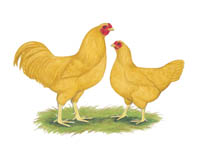
| Male Mature Weight: 7.5 lbs |
| Female Mature Weight: 5.5 lbs |
| Comb Type: Pea/cushion |
| Egg Color: Brown
Egg Size: "Medium" Rate of Lay: ~4/week |
| Type: Meat - Laying - Dual-purpose - Other |
| Setting: "Average" |
| Disposition/Temperament: Friendly, bears confinement well |
| Climate Hardiness: Cold, Winter-hardy [1], [2] |
| ALBC Priority: Critical |
| Show Class: Not recognized |
Ideal Poultry Breeding Farms, Inc:
Chanteclers are the first breed of Canadian creation. They were bred to produce a general-purpose bird with a vigorous and rustic temperament that could resist the cold climatic conditions of Canada. They are a dual-purpose breed with yellow skin that is used to produce both meat and brown-shelled eggs. All of the plumage is buff or straw colored. Their appearance is very strong and stable with clean legs. They have very small cushion combs that are set firm and low on the fore part of the head.
Standard weights at maturity are males-7 1/2 lbs. and hens-5 1/2 lbs.
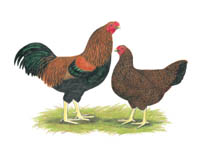
|
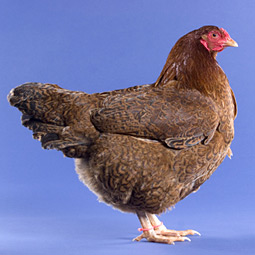 Hen-- My Pet Chicken |
| Male Mature Weight: 8.5 lbs |
| Female Mature Weight: 6.5 lbs |
| Comb Type: Pea/cushion |
| Egg Color: Brown
Egg Size: "Medium" Rate of Lay: ~4/week |
| Type: Meat - Laying - Dual-purpose - Other |
| Setting: "Average" |
| Disposition/Temperament: Friendly, bears confinement well |
| Climate Hardiness: Cold [1] |
| ALBC Priority: Critical |
| Show Class: American |
Ideal Poultry Breeding Farms, Inc:
Chanteclers are the first breed of Canadian creation. They were bred to produce a general-purpose bird with a vigorous and rustic temperament that could resist the cold climatic conditions of Canada. They are a dual-purpose breed with yellow skin that is used to produce both meat and brown-shelled eggs. The plumage of Partridge Chantecler males is very different from the plumage pattern of the females. The upper body of the male is primarily rich, brilliant red while the lower body and tail is black. Most of the female's plumage is either black with reddish bay lacing or reddish bay with black lacing.
Standard weights at maturity are males-8 1/2 lbs. and hens-6 1/2 lbs.
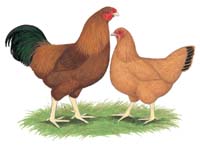
| Male Mature Weight: 7.5 lbs |
| Female Mature Weight: 5.5 lbs |
| Comb Type: Pea/cushion |
| Egg Color: Brown
Egg Size: "Medium" Rate of Lay: ~4/week |
| Type: Meat - Laying - Dual-purpose - Other |
| Setting: "Average" |
| Disposition/Temperament: Friendly, bears confinement well |
| ALBC Priority: Critical |
Ideal Poultry Breeding Farms, Inc:
Red Chanteclers originated at Ideal Poultry from an original cross in 2002 involving Buff and Partridge Chanteclers. They are solid red with the males being darker than the females. These breeds originated in Canada and have been bred for production of both meat and brown-shelled eggs in cold climates. They have a very small cushion comb that is set very low and forward on the head.
Males may be expected to weigh about 7.5 pounds while mature hens weigh abut 5.5 pounds.

| Male Mature Weight: 7-8 lbs |
| Female Mature Weight: 5-6 lbs |
| Comb Type: Single |
| Egg Color: Brown
Egg Size: 'Large' Rate of Lay: high |
| Type: Meat - Laying - Dual-purpose - Other |
| Setting: [Unknown] |
| Disposition/Temperament: [Unknown] |
The Cinnamon Queens are one of three Modern Day Brown egg laying strains from hybrid breeding that produce fast body development and fast egg production. These strains will start to lay eggs at a younger age than most standard breeds and produce big brown eggs. They are also color sexable as chicks, cockerels are white, and the pullets are more brownish red in color. You are sure to be pleased with any one of the three we offer.
Hens------5-6 lbs
Roosters--7-8 lbs
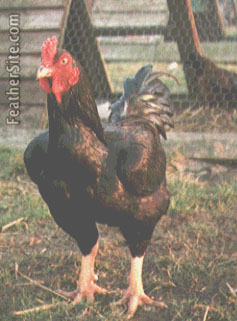
"Bevis," a Dark Cornish male
Photo courtesy of a friend in the UK
Although it is known in some areas as the Indian Game, the Cornish was actually developed in Cornwall, England. Asil, Old English Games, and Malays are included in its heritage. It is a "hard feathered" breed, with a plumage that sits very close to the body, and it carries a small pea comb.
The Cornish is a very sturdy bird. From the front its fairly short strong legs should be set widely apart. It is a heavy bird, with a wide breast, and the males may reach 10 1/2 pounds. More so than in most breeds of chicken, body conformation is the same in both sexes.
The poultry industry is heavily dependent upon this bird. Most broilers in the supermarket are the result of a cross between a White Cornish and a White Plymouth Rock. These Cornish/Rock crosses are the mainstay of the poultry industry. Be aware, however, that you can't just cross any Cornish and Rock and get a supermarket carcass. The parental lines of these crosses have been developed extensively over the years by the commercial industry.
A Word About "Rock Cornish Game Hens"
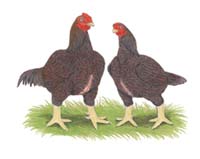
| Male Mature Weight: 44 oz |
| Female Mature Weight: 36 oz |
| Comb Type: Pea |
| Egg Color: Brown
Egg Size:[Small] Rate of Lay: ["good"] |
| Type: Meat - Laying - Dual-purpose - Other |
| Setting: ["Average"] |
| Disposition/Temperament: [Gentle], Active, bear confinement well |
| Climate Hardiness: All Climates, Winter-hardy [1], [2] |
| Show Class: All Other Combs, Clean Legged Bantams |
Ideal Poultry Breeding Farms, Inc:
Blue Laced Red Cornish Bantams are a relatively new variety that has a very beautiful plumage pattern. Like other blue laced varieties, this variety does not breed true, and a larger population is required for the same level of selection to be applied relative to breeding solid colors. They have an active, upright, vigorous, alert appearance. They are very stocky with a wide breast, short legs and plumage, which is short, hard, brittle and tight fitting. They do not appear to weigh nearly as much as their actual weight.
Standard weights at maturity are male-44 oz, and hen-36 oz.
The blue (Bl) gene only has an effect on black plumage resulting in blue plumage when the blue gene is present in the heterozygous state (Bl bl). Other plumage colors are not affected by the blue gene. When blue (Bl bl) males are mated with blue (Bl bl) females, the ratio of colors produced is as follows: 1 black (bl bl), 2 blue (Bl bl) and 1 splash (Bl Bl) (white with a blue cast). Any blue variety ordered from Ideal Poultry may include chicks with black, blue or splash plumage patterns.
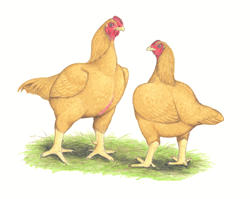
| Male Mature Weight: 10.5 lbs |
| Female Mature Weight: 8 lbs |
| Comb Type: Pea |
| Egg Color: Brown
Egg Size: 24-25 Ounces/dozen Rate of Lay: "Good" |
| Type: Meat - Laying - Dual-purpose - Other |
| Setting: "Average" |
| Disposition/Temperament: Gentle, Active, bear confinement well |
| Climate Hardiness: All Climates, Winter-hardy [1], [2] |
| ALBC Priority: Watch |
| Show Class: English |
Ideal Poultry Breeding Farms, Inc:
Buff Cornish, which have a rich solid buff colored plumage, are an extremely rare variety. They have pea combs with a very distinctive, thick, compact body shape with unusually wide backs and deep, broad breasts. They have very tight muscling; therefore, Cornish, which lay brown eggs are very popular with those who prepare poultry dishes, which need the meat to be firm following cooking, such as gumbo, stew and soup.
Standard weights at maturity are males-10 1/2 lbs. and hens-8 lbs.
Backyard Chickens.com: [NAH]
"They are quiet and calm, they can also be easily approached. They are ideal for frying and are broilers. They need substantial amounts of feed due to being heavy feeders." - eggsrcool
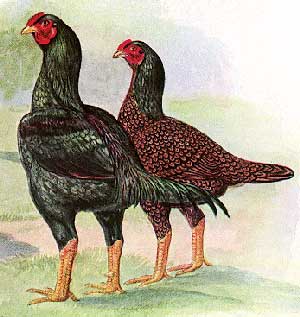
| Male Mature Weight: 8.5 lbs |
| Female Mature Weight: 6.5 lbs |
| Comb Type: Pea |
| Egg Color: Brown to tinted
Egg Size: 24-25 Ounces/dozen Rate of Lay: "Good" |
| Type: Meat - Laying - Dual-purpose - Other |
| Setting: Good, good mothers |
| Disposition/Temperament: Gentle but stand up to predators, Active, bear confinement well |
| Climate Hardiness: All Climates, Winter-hardy [1], [2] |
| ALBC Priority: Recovering |
| Show Class: English |
The name Cornish indicates the origin of these handsome birds in Cornwall, England and they belong to the English Class. At one time they were known as "Indian Games" because of the use of both Old English Game chickens and Aseels from India in developing this breed.
They are unique because of their thick, compact bodies, unusually wide backs, and broad, deep breasts. These super meat qualities have made the Dark Cornish a truly gourmet item to raise for eating. The hens are nice layers of firm-shelled brown eggs and wonderfully hardy. This variety will come as close as any to rustling for themselves under rough conditions and also make good setters and mothers. Another very distinctive character is the close fitting, rather hard textured feathers with unusual lustre and brilliance. The close feathering and compact build will fool you on weight. They are always much heavier than they look. Baby chicks, all purebred and from the same strain, can vary greatly in color from a light reddish buff to a darker reddish brown with dark markings on the head and sometimes a dark stripe on the outer edge of the back.
Customer comments:
Years ago, I got a Dark Cornish hen in an assortment package. She laid the most beautiful dark brown eggs and
was a wonderful mother. Once a hawk had been picking off her latest brood, and when I accidentally chased the hawk
into the coop, our hen followed the hawk in and attacked it. What a chicken!!
- - -
We ordered the Cornish Game Hens years ago, and the hens are still strong and good egg layers. They run around the
yard and forage with little difficulty with the local predators. Very friendly hens. We love these birds.
- - -
I ordered about 50 of these chickens and they are the best and most gentle chickens, and they are setting and have
hatched out the healthiest chicks. EXCELLENT MOTHERS!! I would recommend these birds to everyone. and when mcmurry
sent them they were big and healthy!!!
The Dark Cornish used to be known abroad as the "Indian Game" and originated in Cornwall, England. Admitted to the American Standard of Perfection in 1893. They have thick, compact bodies and very close fitting body feathers. They usually weigh more than they look. The hens lay brown eggs. The cockerels are an excellent meat bird with broad, deep breasts. which have a range of mixed colors in the feathers and the egg shell tints are also in many colors. A great breed for backyard enjoyment and natural colored eggs to eat. Several variety colors were admitted to the American Standard of Perfection in 1984.
Hen-----------8 lbs
Rooster-------10 1/2 lbs
Pullet--------- 6 1/2 lbs
Cockerel----- 8 1/2 lbs
Ideal Poultry Breeding Farms, Inc:
Well known "old breed" that have become rare-- Excellent wide breast of firm meat.
Dark Cornish are the most popular variety of Cornish, also known as Indian Games. They were developed using Aseels, Black Breasted Red Old English and Malays, with selection for an abundant volume of breast meat. Cornish are very hardy and can survive adverse conditions, but have a relatively slow growth rate. They are not a good choice for egg producers, since their rate of lay and egg size is less that other brown egg layers. They have pea combs with a very distinctive, thick, compact body shape with unusually wide backs and deep, broad breasts. They have very tight muscling; therefore, Cornish are very popular with those who prepare poultry dishes, which need the meat to be firm following cooking, such as gumbo, stew and soup.
Standard weights at maturity are males-10 1/2 lbs. and hens-8 lbs.
Dark Cornish, which have also been commonly referred to as Indian Games, are the most popular variety of the Cornish breeds. The Dark Cornish breed was developed by using Aseels, Black Breasted Red Old English, and Malays. They have a very thick, compact body with wide backs and broad breasts. Cornish are a very popular meat bird for dishes requiring firm meat after cooking.
Comb: Pea.
Standard weight at maturity: Hens 8 lbs, males 10 ½ lbs.
Egg color: Brown
Backyard Chickens.com: [NAH]
"They are quiet and calm, they can also be easily approached. They are ideal for frying and are broilers. They need substantial amounts of feed due to being heavy feeders." - eggsrcool
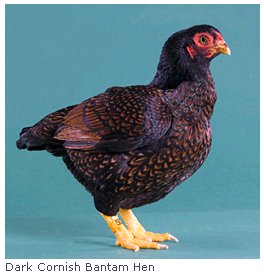
My Pet Chicken |
| Male Mature Weight: 44 oz |
| Female Mature Weight: 36 oz |
| Comb Type: Pea |
| Egg Color: Brown
Egg Size: [Small] Rate of Lay: [Varies. 1/week and up] |
| Type: Meat - Laying - Dual-purpose - Other |
| Setting: [Good] |
| Disposition/Temperament: [Gentle], Active, bear confinement well |
| Climate Hardiness: All Climates, Winter-hardy [1], [2] |
| Show Class: All Other Combs, Clean Legged Bantams |
These are exact replicas of the large size breed except for their miniature size. They are very tightly feathered, alert, and quick. They have a large breast that many times will push the feathers aside exposing skin, a desirable trait for show. They lay brown eggs and are good to eat and popular for show.
A miniature size of the Cornish Standard breed and admitted to the American Poultry Standard of Perfection in 1942 (White Laced Red and White (1933) Dark variety.
Hen ................36 oz.
Rooster ..........44 oz.
Pullet ..............32 oz.
Cockerels ......40 oz.
Ideal Poultry Breeding Farms, Inc:
Dark Cornish Bantams are the most popular variety of Cornish Bantams. The females have a beautiful, unique, plumage color pattern. The breast and back are deep lustrous chestnut with each feather edged with a narrow lacing of brilliant greenish black. The males have brilliant greenish black plumage that does not completely cover their broad, full, deep breasts.
Standard weights at maturity are male-44 oz, and hen-36 oz.
Our bantams are purebred and represent the breed and variety; however, we do not guarantee or represent that they are of show quality.
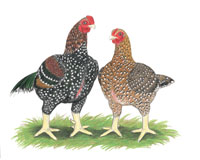
| Male Mature Weight: 44 oz |
| Female Mature Weight: 36 oz |
| Comb Type: Pea |
| Egg Color: Brown
Egg Size: [Small] Rate of Lay: [May be: "Average"] |
| Type: Meat - Laying - Dual-purpose - Other |
| Setting: [Yes] |
| Disposition/Temperament: [Gentle], Active, bear confinement well |
| Climate Hardiness: All Climates, Winter-hardy [1], [2] |
| Show Class: All Other Combs, Clean Legged Bantams |
Ideal Poultry Breeding Farms, Inc:
Spangled Cornish Bantam males have lustrous, dark red plumage with each feather ending in a V-shaped or diamond shaped white spangle. They have black breasts, tails and wing feathers, which also are tipped with a white spangle. The female's breast and body plumage is rich salmon, evenly stippled with brown and each feather is tipped with a white spangle. The tail and wing plumage is primarily black with white spangles while the back is black, finely stippled with brown and the head and hackle plumage is golden red, stippled with black.
Standard weights at maturity are male-44 oz, and hen-36 oz.
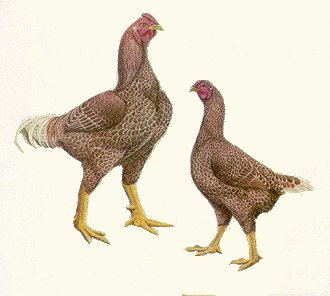
| Male Mature Weight: 10 lbs |
| Female Mature Weight: 8 lbs |
| Comb Type: Pea |
| Egg Color: Brown
Egg Size: "Medium" Rate of Lay: "Low" |
| Type: Meat - Laying - Dual-purpose - Other |
| Setting: Yes, "broody" |
| Disposition/Temperament: Calm, Active, bear confinement well |
| Climate Hardiness: All Climates, Winter-hardy [1], [2] |
| ALBC Priority: Watch |
| Show Class: English |
The ideal plumage pattern in which each feather is a rich dark red narrowly laced with white is very difficult to achieve but tremendously impressive in those individuals which are marked that way. Even though others may not quite realize this perfection they are handsome birds in their red and white plumage and deep yellow skin color, and display to a high degree the square, blocky type of true Cornish. They mature rather slowly. Hens are fair layers of brown eggs which have firm, strong shells. Chicks are rather small and of varying shades of reddish buff.
Customer comments:
The white laced red cornish is a very unique bird. I received four last year, and they are very calm.
Our hens can be very broody and have hatched several on their own. I love them very much and plan getting
some more this year.
Ideal Poultry Breeding Farms, Inc:
White Laced Red Cornish are a beautiful, rare variety of Cornish that originated in Cornwall, England. They have pea combs with a very distinctive, thick, compact body shape with unusually wide backs and deep, broad breasts. They have very tight muscling; therefore, Cornish are very popular with those who prepare poultry dishes which need the meat to be firm following cooking, such as gumbo, stew and soup. They are a rich, lustrous, dark red with most feathers either tipped with silvery white V-shaped lacing or have a narrow lacing of silvery white. The tails are red with each feather laced with white. The feathers are close fitting, short, narrow, hard and very brittle. Cornish are very hardy and can survive adverse conditions, but have a relatively slow growth rate. They are not a good choice for egg producers, since their rate of lay and egg size is less that other brown egg layers.
Standard weights at maturity are males-10 1/2 lbs. and hens-8 lbs.
Backyard Chickens.com: [NAH]
"They are quiet and calm, they can also be easily approached. They are ideal for frying and are broilers. They need substantial amounts of feed due to being heavy feeders." - eggsrcool
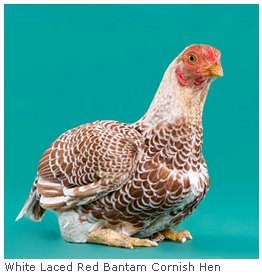 My Pet Chicken |
| Male Mature Weight: 44 oz |
| Female Mature Weight: 36 oz |
| Comb Type: Pea |
| Egg Color: Brown
Egg Size: [Small] Rate of Lay: ["Low"] |
| Type: Meat - Laying - Dual-purpose - Other |
| Setting: Yes, "broody" |
| Disposition/Temperament: [Calm], Active, bear confinement well |
| Climate Hardiness: All Climates, Winter-hardy [1], [2] |
| Show Class: All Other Combs, Clean Legged Bantams |
All cornish were originally known as Indian-Game bantams and have been around since the early 1900’s. Like their cousins, the Dark Cornish, these beautiful White Laced Reds are known for their sturdy looks and brilliant rich red feathers which are laced (tipped) in white.
A miniature size of the Cornish Standard breed and admitted to the American Poultry Standard of Perfection in 1942 (White Laced Red and White (1933) Dark variety.
Hen ................36 oz.
Rooster ..........44 oz.
Pullet ..............32 oz.
Cockerels ......40 oz.
Ideal Poultry Breeding Farms, Inc:
White Laced Red Cornish Bantams have one of the most beautiful of all plumage color patterns, which presents a unique, striking appearance on the distinctively shaped Cornish bodies. Most of the feathers of both males and females are brilliant, rich red with each feather laced with a narrow white lacing conforming to the shape of the individual feather.
Standard weights at maturity are male-44 oz, and hen-36 oz.
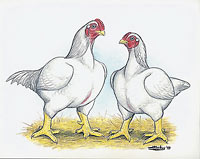
| Male Mature Weight: 44 oz |
| Female Mature Weight: 36 oz |
| Comb Type: Pea |
| Egg Color: Brown
Egg Size: [Small] Rate of Lay: ["Average"] |
| Type: Meat - Laying - Dual-purpose - Other |
| Setting: [Yes] |
| Disposition/Temperament: [Gentle], Active, bear confinement well |
| Climate Hardiness: All Climates [1] |
| Show Class: All Other Combs, Clean Legged Bantams |
WHITE CORNISH: Pure white in color, these stocky cornish bantams are very desirable to the hobbiest. They have a pea comb and are yellow skinned. The hens lay brown eggs and the males are a nice small meat bird.
A miniature size of the Cornish Standard breed and admitted to the American Poultry Standard of Perfection in 1942 (White Laced Red and White (1933) Dark variety.
Hen ................36 oz.
Rooster ..........44 oz.
Pullet ..............32 oz.
Cockerels ......40 oz.
Ideal Poultry Breeding Farms, Inc:
White Cornish Bantams have plumage that is pure white in all sections. They have a very distinct, compact, unique body shape with very broad, full and deep breasts. The plumage is short, scant, moderately narrow, close fitting and firm, which produces an overall hardness of feather that does not fully cover the male's breast.
Standard weights at maturity are male-44 oz, and hen-36 oz.
Wikipedia: (NAH)
In the middle 19th century, the Spaniards brought to Havana, Cuba, several varieties of Asiatic game fowl that originated in the Philippine Islands. The Cubans crossed the Asiatic breeds, and subsequently re-crossed them with birds of European origin.
These birds were then selectively bred for wide, extended tails and a curving beak, fierce eyes, and a courageous expression. In this manner the Cubalaya was created, independent from any scientific control. In 1935, the Asociacion Nacional de Avicultura (Cuban National Poultry Association) approved the breed. Their name was chosen in honor of the Republic of Cuba, which had patronized and refined them.
...
Cubalayas are characterized by their stately carriage; pea comb; abundant, flowing hackle feathers and long, well-spread tail carried about 20 degrees below the horizontal. They possess a friendly, curious disposition, are very heat tolerant and make excellent foragers when allowed to range. The hens lay small eggs and are good brooders.
Feathersite: (NAH)
[Extracts]
with permission from SPPA Bulletin, 2001, 6(1):5
...
One thing is for sure, the Cubalaya is not strictly an Oriental breed, but a combination Oriental fighting
stock combined with British and European utility breeds. This is mirrored in the fact that the Cubalaya is
strictly a white skinned, white legged (slate in Blacks) breed. They also have multiple spurs. Most spurs
have round knobs, though, indicating other than Sumatra blood. From the European side of their ancestry stems
a fairly good production in number of eggs. They are almost pure white in color and more round than pointed...
Since we know they have Oriental ancestry, we can only guess breeds used from the opposite side of the world.
In my breeding line I constantly experience a high percentage of five toes usually in Siamese style forming one
unit and usually only on one foot. All genetic science points to a dominant gene for five toes, here it shows
up in a recessive incomplete form. First, I thought that maybe the Dorkings were the other half of the pedigree,
but have discarded that thought and actually have to lean toward the Faverolles. Several hundred years ago
the French epicures valued the Faverolles as one of the finest meat-breeds at that time and I believe the
British followed suit. It is claimed that no white skinned European breed has finer texture and tastier meat.
What makes me think of the Faverolles is actually the color and the five toes combined.
...
The reason the cross between Orientals and European breeds took place was the Latin origin of the Cuban people, especially the men. They enjoyed a good cockfight every now and then, while the women of the household had to feed the family and wanted eggs and meat. A double purpose satisfied everyone. ...
When kept on free range, they practically nourish themselves foraging. They are easy on the eye to look at, they are nice to have around and are very smart. I have never had one to attack his human keeper and they are naturally tame from day one. It is not uncommon to see your breeding rooster jump on your lap and look you straight in the eye and/or one of his hens on the other leg just wanting to get petted. ...
Artificial incubation is excellent, but traditionally right from the start takes 22 days. The Cubalaya as a backyard fowl, a show fowl, meat and egg fowl or just a plain pet is hard to beat, that's why it takes another day of incubation to put the whole package together.
Backyard Chickens.com: [NAH]
...Cubalaya are classified as an Oriental Game breed. The breed standard was first approved in 1935, by the American Poultry Association, with the name Cubalaya in honor of Cuba where the breed originated. Cubalaya have a very nice white meat, lay an average of 4 – 5 eggs per week during their peak egg-laying season, and serve as a dual purpose breed in Cuba. Within the United States, they are typically kept for ornamental and exhibition purposes. "Cubalaya are a magnificent and beautiful specimen. The breed exhibits an upright stately carriage, fierce bay colored eyes, and a very “people-friendly” nature. From chick to mature adult, Cubalaya are very curious animals and typically easily tamed. The males, at 6 lbs, have gorgeous long, lobster-shaped tails, rosary spurs, and a fierce, predatory head-shape. The females are slightly smaller at 4 lbs, and though they are pale in color compared to their male counterparts they do make excellent protective brood hens. Please note that Cubalaya may take up to 2 – 3 years to reach full maturity, especially in the males concerning tail growth and weight. The ALBC lists Cubalaya status as Threatened. There are a few hatcheries that offer Cubalaya; however, quality brood stock is currently difficult to locate. While the APA only lists three approved colors, there are various other wheaten based color varieties such as the blue/red, gold & silver duckwing, pyle, blue/gold, ginger, black/red, lemon blue, etc…" - Cuban Longtails
My Pet Chicken: [NAH]
"... these chickens are said to produce prime white meat, with hens that can lay fairly well. "
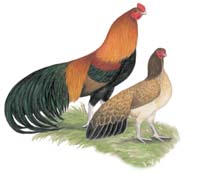
| Male Mature Weight: 6 lbs |
| Female Mature Weight: 4 lbs |
| Comb Type: Pea |
| Egg Color: Brown
Egg Size: "Medium" Rate of Lay: up to ~4/week in season |
| Type: Meat - Laying - Dual-purpose - Other- Bug-hunters |
| Setting: Yes, good brooders |
| Disposition/Temperament: Friendly and curious, but males may not get along with other roosters |
| Climate Hardiness: All Climates, Winter-hardy [1], [2] |
| ALBC Priority: Threatened |
| Show Class: "Oriental" |
Cackle Hatchery: (Bantam version)
A miniature size of the Black Breasted Red Cubalaya standard chicken breed and admitted to the American Poultry Standard of Perfection in 1960. The Cubalaya is a great show bird and hard to find breed. The bird originated in Cuba. Notable features are the pea comb and low carried tail. The males do not produce a natural spur and/or the spur is just a nub.
Wheaten color also available.
Hen .................22 oz.
Rooster ..........26 oz.
Pullet ..............20 oz.
Cockerels ......22 oz.
Ideal Poultry Breeding Farms, Inc:
Black Breasted Red Cubalayas, which lay brown eggs, originated in Cuba where they are extensively bred. The most distinguishing feature of Cubalayas is their stately carriage with tails that are long, broad and carried well below the horizontal, which is a unique characteristic of this breed [and Sumatras] only. The males of this variety are very colorful and present an excellent exhibition display. This oriental, long-tailed breed is extremely rare and chicks are seldom made available for purchase other than from Ideal.
Without specific, individual management, such as correct lighting and heating, growers should not expect the male's tails to reach the extremely long lengths. Ideal's Cubalaya will have tails the length shown on our pictures without special attention.
Standard weights at maturity are males-6 lbs. and hens-4 lbs.

| Male Mature Weight: 6 lbs |
| Female Mature Weight: 4 lbs |
| Comb Type: Pea |
| Egg Color: Brown
Egg Size: "Medium" Rate of Lay: up to ~4/week in season |
| Type: Meat - Laying - Dual-purpose - Other- Bug-hunters |
| Setting: Yes, good brooders |
| Disposition/Temperament: Friendly and curious, but males may not get along with other roosters |
| Climate Hardiness: All Climates, Winter-hardy [1], [2] |
| ALBC Priority: Threatened |
| Show Class: Not recognized by APA |
Ideal Poultry Breeding Farms, Inc:
Blue Red Cubalayas, which lay brown eggs, originated in Cuba where they are extensively bred. They are an oriental, long-tailed breed, which can be traced back to birds coming from the Orient, most probably the Philippine Islands. Their most distinguishing feature, which is unique to the Cubalaya breed, is their stately carriage with long broad tails that are carried well below the horizontal. Males of this variety are very colorful and present a unique poultry display. Seldom is this extremely rare variety available from any source other than Ideal Poultry.
Without specific, individual management, such as correct lighting and heating, growers should not expect the male's tails to reach the extremely long lengths. Ideal's Cubalaya will have tails the length shown on our pictures without special attention.
Standard weights at maturity are males-6 lbs. and hens-3 lbs.
The blue (Bl) gene only has an effect on black plumage resulting in blue plumage when the blue gene is present in the heterozygous state (Bl bl). Other plumage colors are not affected by the blue gene. When blue (Bl bl) males are mated with blue (Bl bl) females, the ratio of colors produced is as follows: 1 black (bl bl), 2 blue (Bl bl) and 1 splash (Bl Bl) (white with a blue cast). Any blue variety ordered from Ideal Poultry may include chicks with black, blue or splash plumage patterns.
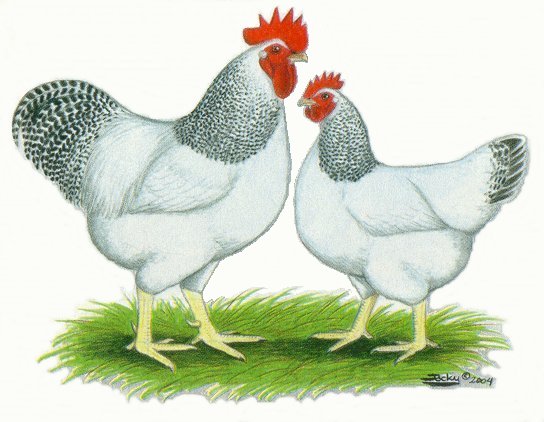
| Male Mature Weight: 8.5 lbs |
| Female Mature Weight: 6.5 lbs |
| Comb Type: Single |
| Egg Color: Brown
Egg Size: 25-26 Ounces/dozen Rate of Lay: "Good", ~ 4/week |
| Type: Meat - Laying - Dual-purpose - Other |
| Setting: "Average" |
| Disposition/Temperament: Gentle, like to be petted, bears confinement well |
| Climate Hardiness: All Climates, Winter-hardy [1], [2] |
| ALBC Priority: Threatened |
| Show Class: American |
This breed was founded in the state of Delaware from an original Barred Rock and New Hampshire cross. The Delaware is considered a heavy breed which lays a nice brown egg. Males are medium size and large enough to butcher for meat and the hens will make a nice "stewing" dish when they are done laying. The feathering on these beautiful birds is almost all white but shows a slight indication of barring in the hackle and tail. Delaware are a nice quiet bird when well tended to.
Customer comments:
This was my first year ordering from McMurray. All of the chicks that I ordered
grew to be full grown chickens. Out of all the chickens I ordered the Delawares
are all ways the ones to get noticed first and I am all ways getting told that
the Delawares are so beautiful. The Delawares are so gentle even the rooster who
my brother named Spot, likes you to pick him up and rub his wattles. Thanks for
the wonderful chicks. Cory
- - -
I just love my "delies"! They are as sweet as they are beautiful, and very bright,
too. They love to be petted, and a couple of them actually "cuddle" back when held,
crooning quietly, wing on one shoulder, head on the other. They started laying at
just under 5 months old, with decent size (1 1/2 oz), well-formed eggs of dark,
pinkish brown. I'll be getting more "delies" soon!
Originated and developed in the state of Delaware USA in the 1940's and admitted into the American Standard of Perfection in 1952. The Delaware is a dual purpose chicken with a single comb and a layer of brown eggs. Plumage is nearly white and the bird is a rapid grower.
Hen-----------6 1/2 lbs
Rooster-------8 1/2 lbs
Pullet--------- 5 1/2 lbs
Cockerel----- 7 1/2 lbs
Ideal Poultry Breeding Farms, Inc:
A medium sized, docile white bird which is more decorateve than solid white plumage birds.
Delawares are a relatively new breed, which were first developed in the state of Delaware from off colored sports that occurred when Barred Plymouth Rock males were mated to New Hampshire females. Their plumage is the beautiful, attractive black and white Columbian color pattern. They have the same general shape as New Hampshire Reds, which is much shorter and more compact as compared with Plymouth Rocks. They are an excellent dual-purpose breed that efficiently produces large brown eggs.
Standard weights at maturity are males-8 1/2 lbs. and hens-6 1/2 lbs.
Delawares were originally developed in the state of Delaware from crossing a Barred Plymouth Rock male with a New Hampshire female. Although much different in color, their shape resembles that of a New Hampshire breed rather than the Barred Plymouth Rock. The Delaware is solid white except for some barring on both the hackle and tail feathers. They are quiet and easy to handle.
Comb: Single.
Standard weight at maturity: Hens 6 ½ lbs, males 8 ½ lbs.
Egg color: Brown
| Male Mature Weight: 8.5 lbs |
| Female Mature Weight: 6.5 lbs |
| Comb Type: Single |
| Egg Color: Brown
|
| Type: Meat - Laying - Dual-purpose - Other |
This is a cross between a purebred Delaware Rooster over the pure New Hampshire hen. This cross makes for a vigorous healthier bird and excellent brown egg producer. Dual purpose - both meat and eggs.
Hen -------6 1/2 lbs
Rooster----8 1/2 lbs
Pullet------5 1/2 lbs
Cockerel--7 1/2 lbs
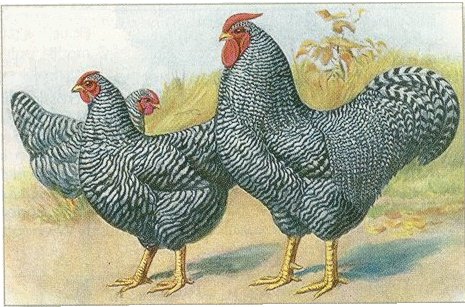
| Male Mature Weight: 7 lbs |
| Female Mature Weight: 5 lbs |
| Comb Type: Rose |
| Egg Color: Brown
Egg Size: 25-26 Ounces/dozen Rate of Lay: "Very Good", ~3/week |
| Type: Meat - Laying - Dual-purpose - Other |
| Setting: "Average" |
| Disposition/Temperament: Gentle, docile, bears confinement well |
| Climate Hardiness: All Climates, Winter-hardy [1], [2] |
| ALBC Priority: Watch |
| Show Class: American |
This breed is distinctly American, dating way back to the early days in New England. Pioneers brought these west with them and in the old days amost any black and white barred plumage chicken was referred to as a 'Dominiker'. They have rose combs, medium sized bodies, prominent tails, and the black and white barred plumage.
Customer comments:
We recently received a Dominique rooster and he is the funniest thing that I think I have ever seen. He goes
into the nest with the hens, and will roll over and let you pet his stomach. I would recomend a Dominique to
anyone. They are the most gentle chickens you will ever come about.
- - -
I purchased four dominique chickens over the summer and fell in love. I never knew that having chickens as
a pet could be so much fun. This year I plan to get many more.
- - -
I bought four Dominques and they were the talk of the neighborhood. They all grew up and are laying eggs.
They are so docile and delightful. I had a great first experience in the poultry world.
This chicken has been around in the old English history long before poultry standards existed. Originated date is unknown and many of today's recognized breeds were developed by using Dominique bloodlines. A great bird with a notable rose comb, barred feathering and a dual all purpose chicken.
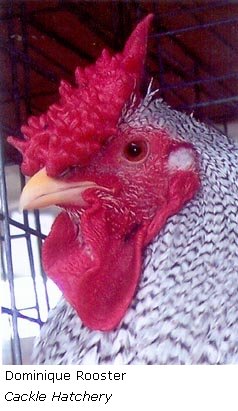 Hen -------6 1/2 lbs
Hen -------6 1/2 lbs
Rooster----8 1/2 lbs
Pullet------5 1/2 lbs
Cockerel--7 1/2 lbs
Ideal Poultry Breeding Farms, Inc:
They have rose combs and a more angular body than Barred Plymouth Rocks. These two breeds are many times confused.
Dominiques are one of the oldest American breeds having been plentifully bred as early as 1820. They are a black and white barred bird with the females being slightly darker than the males. Because males are the homozygous sex, they have two barred alleles (BB) and are therefore lighter in color than the females, which are the heterogametic sex and have only one barred allele(B_). Many times customers who want Barred Plymouth Rocks ask for "Dominickers". Dominiques have rose combs, angular bodies and are smaller than Barred Rocks. They are excellent, efficient producers of brown eggs.
Standard weights at maturity are males-7 lbs. and hens-5 lbs.
Dominiques are one of America’s oldest breeds of chicken, dating back to the early 1800’s when they were commonly referred to as “Dominikers”. A popular breed for early settlers because they are good foragers and a good dual purpose breed. Dominiques were used in developing the Barred Plymouth Rock that are commonly confused with Dominiques, which may have played a role in the Dominiques’ near extinction.
Standard weight at maturity: Hens 5 lbs, males 7 lbs.
Egg color: Brown
The exact origin of the Dominique chicken is not known, but they probably came from European chicken breeds and later in its refinement, some Asian breeds. The name of "Dominique" probably came from birds imported from the French colony of Saint-Domingue (Haiti). Early names of these poultry include Blue Spotted Hen, Old Grey Hen, Dominico, Dominic, and Dominicker.
Dominique fowl was common on American farms as early as the 1820s, where they were kept as a dual-purpose chicken. In 1871 the New York Poultry Society decided that only rose combed Dominiques would be the breed standard. The single combed Dominiques were folded into the barred Plymouth Rock breed- a larger breed common in New England which were created by crossing large, single comb Dominiques with Java chickens. In 1874 the Dominique breed was officially admitted to the American Poultry Association's Standard of Perfection.
The Dominique was popular until the 1920s but then interest decreased. The breed survived during the Great Depression of the 1930s because it was hardy and easy to keep. By the end of World War II, as the industrial poultry industry began to increase, the Dominique again declined. By 1970 there were only four known flocks owned by: Henry Miller, Edward Uber, Robert Henderson, and Carl Gallaher. From 1983 with reports on the breed by American Livestock Breeds Conservancy, until 2006, Dominiques steadily increased in numbers. As of 2007, they are once again beginning to decline.
The Dominique chicken is a medium-sized black and white barred "cuckoo" patterned bird. This pattern makes the Dominique less visible to predators. Dominique fowl have a rose comb with a short upward curving spike. The roosters average seven pounds and the hens five pounds. The Dominique's tightly arranged plumage keeps the birds warm in winter and provides plenty of feathers for pillows and featherbeds. Dominiques carry their heads high up on well-arched necks. Their body is broad and full with long and full tail feathers that are held the highest of the American breeds. Their legs are yellow.
The Dominques are a dual-purpose breed (meat and eggs), but are mostly kept for being good egg producers. Hens average 230-275 small- to medium-sized brown eggs per year. Dominiques are self sufficient and will scratch for their own food, making them less expensive to maintain than many of today's specialized breeds of chickens. Dominiques are good foragers. The hens are good mothers and easy going with humans.
A book about Dominique's is available: "The American Dominique: A Treatise for the Fancier" by Mark A. Fields.
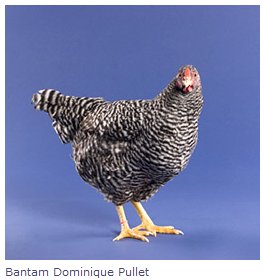 My Pet Chicken |
| Male Mature Weight: 28 oz |
| Female Mature Weight: 24 oz |
| Comb Type: Rose |
| Egg Color: Brown
Egg Size: [Small] Rate of Lay: ["Very Good"], ~3/week |
| Type: Meat - Laying - Dual-purpose - Other |
| Setting: ["Average"] |
| Disposition/Temperament: [Gentle, docile], bears confinement well |
| Climate Hardiness: All Climates, Winter-hardy [1], [2] |
A miniature size of the Dominique Standard chicken breed and recognized by the American Poultry Standard of Perfection in 1960. A great back yard chicken and show bird that will delight all.
Hen ................24 oz.
Rooster ..........28 oz.
Pullet ..............22 oz.
Cockerels ......26 oz.
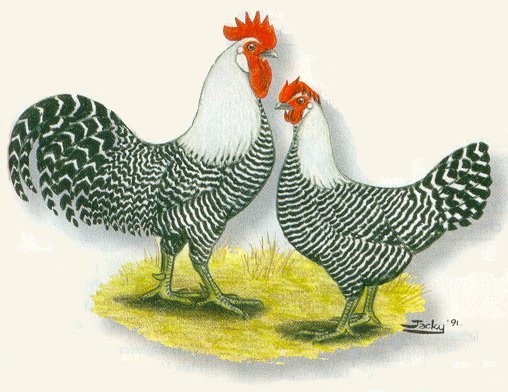
| Male Mature Weight: 5 lbs |
| Female Mature Weight: 4 lbs |
| Comb Type: Single |
| Egg Color: Pinkish
Egg Size: 'Small' Rate of Lay: 'Good', ~2/week |
| Type: Meat - Laying - Dual-purpose - Other |
| Setting: Yes, after 2-3 yrs |
| Disposition/Temperament: Alert, assertive, fast, intolerant of confinement |
| Climate Hardiness: Heat, not winter-hardy [1], [2] |
| ALBC Priority: Study |
These small, active, lovely chickens have been raised along the Nile River in Egypt for centuries, and even though quite common there, are practically unknown in this country. We got our start of this very rare breed from one of the state universities whose poultry department was using them for special studies in genetics. No other breed matures quite so quickly as these do and the young pullets are apt to start laying their small tinted white eggs at 4 to 4-1/2 months while the cockerels will start to crow at an unbelievable 5 to 6 weeks. They are attractively marked with silvery white hackle and white bars on black background throughout the body plumage. Leg color can be either willow green or slate blue. Baby chicks are highly colored in brown, black, and white markings on the back and a brownish purple head color.
Customer comments:
I have been purchasing my baby chicks from McMurray Hatchery for 3 years now, and each time I still
experience the same thrill and pride in my babies! I ordered a couple Egyptian Fayoumis from you last
March and was completely stunned by the little cockerels "in your face" attitude, he really knew how to
make me laugh! I currently only have the one rooster and the one hen in that breed, both from McMurray
Hatchery, and I am proud to say my hen is sitting on her first clutch of eggs as we speak!! I was
disappointed when she just up and disappeared from the farm one day but was overjoyed when I found
her sitting on ELEVEN little pinkish eggs in our workshop. I would like to THANK YOU for my great little
broody hen. The rooster is stunning and I take alot of pride in him as well. He is large, very stunning
in his coloration, and has a powerful crow that puts my Sumatra to shame! His tail is so huge and open,
it looks just like a peacock when he bends down to pick in the grass. I will definately be ordering
more Fayoumis from you this year, and have to recommend this breed to others!
- - -
Hi, This is the second year we have purchased from you and once again we are very satified with the
quality of chicks you sent us. This year we got an Egyptian Fayoumi as our free exotic chick. He is a
master escape artist and some how finds a way to get out of any pen we put him in. It is very fun watching
him run around the pen looking for a way out.
- - -
We ordered 2 Egyptian Fayoumis in our mixed batch, since my daughter was studying Eygpt. I can easily see
these birds escaping from crocodiles along the Nile. Even when they were chicks, they were the hardest to
catch; very alert. Even now, you can only pet them at dusk on the roosts. They are half the size of my
other hens- Rhode Island Reds, Australorps, etc. but they boss them around and hold their own. They are
amazing foragers and very quick and alert to danger. We love their small pinkish eggs.
- - -
These are lovely, if high-strung, chickens. We have had six of them over the years. Our first two were
hens and became very tame. The more outgoing of the two, Calico, used to sit on my lap and talk to me
while I read books, and would lay an egg into my hand every now and then. Both she and her sister Aurora
were patient enough to submit to being dressed in doll clothes. Our second batch had three hens and a
rooster, and they did not tame so well. They were very beautiful, but flocked on their own away from the
rest of the birds. The rooster was ill-tempered and the hens were feral. They clearly need plenty of gentle
handling (and treats) from day one! They are well-equipped to forage for themselves, but reluctant to
return to the enclosure unless well-trained and bribed. The breed has a very distinctive voice, alternating
between high, refined, and brittle tones or a drawling commentary on life that edges into sarcasm and humor.
From a distance, a group of Egyptian Fayoumis talking to each other can sound like a human conversation.
These clever birds take a lot of attention, but they're worth it.
- - -
Variety is the spice of life and my barnyard definitely has that! What a delight to watch my Egypian
Fayoumis each morning when I am out in the barnyard. I was fun to have the roosters crowing in 5 weeks,
and I look forward to the hens beginning to lay eggs in just a couple more months. Thanks for the great
chicks I've enjoyed from you over the years.
A very common Egyptian fowl raised along the Nile River for centuries. Egyptian Fayoumis lay tinted white eggs. Mature very fast with males trying to crow at an unbelievable 5 to 6 weeks. Feathering is silver and white on black background.
Hen---------3 lbs
Rooster-----4 lbs
Pullet--------2 1/2 lbs
Cockerel--- 3 1/2 lbs
Ideal Poultry Breeding Farms, Inc:
Silver Penciled Egyptian Fayoumi is the best-known variety of the Fayoumi breed, which originated in ancient Egypt in the district of Fayoumi. This is a relatively small breed with a rather upright carriage, that is very alert, graceful, very active and lay white eggs. They are early maturing and for a small breed, have an extreme tendency to go broody. They are recognized by The British Poultry Standards but have not yet been admitted to the American Standard of Perfection.
Standard weights at maturity are males-5 1/2 lbs. and hens-4 lbs.
The Fayoumi is an extremely old breed that originated in Egypt. This breed was brought to the U.S. in the 1940s to be studied at Iowa State University. Research has proven this breed to be very well suited to hot climates and possess strong foraging survival instincts. Hens will usually lay eggs at 4 months and have a strong tendency to go broody, while males will crow at 5-6 weeks.
Comb: Single.
Standard weight at maturity: Hens 3 ½ lbs, males 4 ½ lbs.
Egg color: White
Wikipedia: [NAH]
...Fayoumis are a hardy breed, and particularly well suited to hot climates. The breed, through poultry genetics research and anecdotal reports, is thought to be especially resistant to viral and bacterial infections. They are also very good foragers, and if left to their own devices on a free range basis they can fend for themselves in a nearly feral manner. Fayoumi hens are good layers of small, off-white eggs. They are not given to broodiness as pullets, but can be when they reach two or three years of age...
|
|
[Although these are not chickens, they could be a very useful variety of backyard poultry. - ed.]
All guineas originally came from Africa and have always been prized for their all-dark, gamey tasting meat. In many of the world’s top restaurants guinea is still found on the menu and demands a very high price. Guineas are very easy to raise. Once you get them started, they live and grow on bugs, insects and weed seeds. They newly hatched young are called keets and are very active from the start. Once guineas are grown they will range throughout your farmstead foraging for food and serving as your personal watchdogs by calling: females Buckwheat! Buckwheat! and males Chi! Chi! to all strangers that pull into your yard. Many of our customers report the addition of guineas to their homestead has greatly reduced the number of ticks, particularly the dreaded deer tick. Until 12 weeks of age, different colors of guineas will look similar and be difficult to distinguish.
The Pearl Guinea is the most common variety of Guinea today. Originating in Africa, the Pearl is the guinea seen in most nature shows posing as a look-out around the water holes. They are very alert and wonderful “buggers” (bug-hunters). Pearls are a joy to have around and a delicacy for the table.
Customer comments:
I believe these birds will do well for the Southern backyard gardener. - ed.]
The Pearl Guineas that I recieved from the hatchery are the hardiest birds I have ever seen. All
of my guineas got off to a good start but even in the coldest weather the pearls were the toughest
and largest. They're really an all-around great bird.
- - -
[I first got wind of these as a domesticated poultry bird when I was stationed in the South. I would
regularly see these birds hanging about someone's yard down some back country road in central
Louisiana. They (the Pearl variety) look a lot like polka-dotted bowling balls on legs, with a miniature turkey head and neck
on one end. One time I came within an ace of mashing a line of them crossing the road. It was a thick
fog, and dimly I saw a row of dark round objects spanning the road up ahead. I slowed
down, and when I got within 20 feet or so I saw it was a dozen guinea fowl walking across
single file! Naturally I waited for them to pass, not wanting to squash someone's poultry.
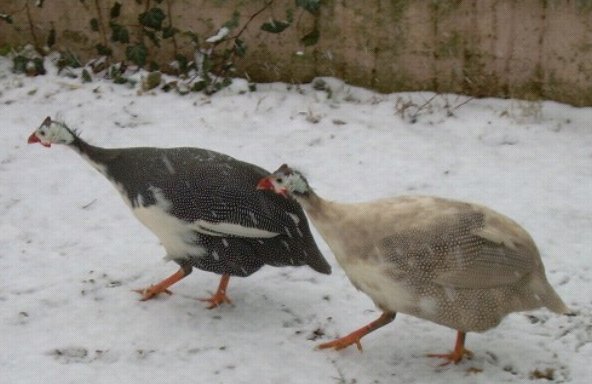 A pair of guineas pick their way through the snow in mid-Missori. Show Me Silkies.com |
The Guinea makes a very good watch dog and will let you know if something different is going on. They are known to be good tick and bug eaters and will let you know if an intruder is around. The origin of the Guinea is the West Coast of Africa.
Figures of the Guinea Fowl are found on buildings built by ancient Egyptians as far back as 2400/s B.C. In 400 B.C. the Greeks considered the meat and eggs delicacies.
Ideal Poultry Breeding Farms, Inc:
Pearl Guineas, which are sometimes called Pearl Gray Guineas, are the best-known variety of Guineas. The surface plumage background varies from dark slate gray to gleaming blue black and is uniformly spotted with bright white or pearly dots, which vary considerably in size on different areas of the plumage. The spots are ringed with black. They have dark skin and game-like, all dark meat that is very tasty. Young guineas, which are known as keets, are very active and easy to raise. After about 4 weeks of age, they require very little attention and will take care of themselves by hustling for their food. Some of the benefits of having a farm flock of guineas are as follows: very fine "watch dogs", keep snakes away from the farm and consume grasshoppers, ticks (including those which carry Limes Disease) and other insects.
Keets are available from Ideal only as Straight Runs from June through August.
[See also Ideal's selection of other Guinea varieties]
Pearl Guineas are the most common variety of Guineas available and a favorite among Guinea enthusiasts. Also commonly referred to as Pearl Gray Guineas, Pearls are dark gray with white dots covering their plumage. Pearl Keets are actually brown with black stripes and markings with more a solid tan underbelly. The Keet's head typically has wide black stripe running down the middle with two narrow black stripes on either side. Pearl Guineas are more likely to be available during the season than other varieties.
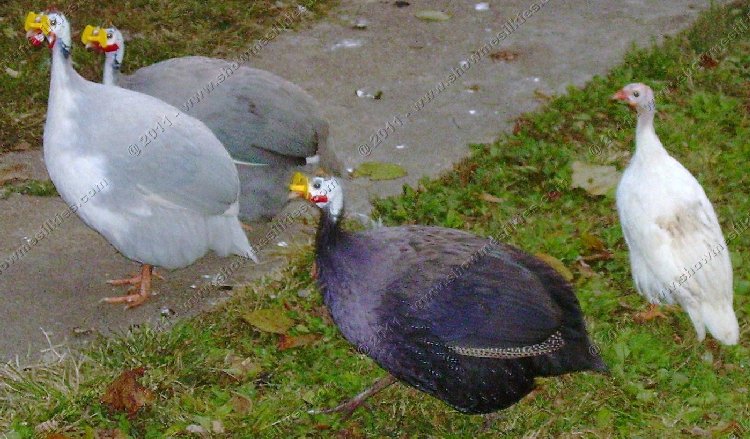 Breeders have created a number of other guinea fowl colors too. Shown here L-R are pewter pied, slate pied, royal, and white. The yellow gadgets on their beaks: "Some people call them 'blinders' and others call them 'peepers'. They are meant for pheasant but I experimented and used them on my Guineas to see if it helped with aggression. Guess what? It worked!!" - ShowMe Silkies.com (More about peepers) |
Clown faced birds that seem to never shut up is what most people think of after being around Guineas. In France, Guineas are very popular. Guinea meat is offered in their food markets. Here in the US, it has been claimed that Guinea is sometimes served in fine restaurants, but offered as pheasant. The cooked guinea fowl resembles chicken in texture, with a flavor much like pheasant (somewhere between chicken and turkey).
Guinea fowl have a long history of domestication. The young are called keets and very small at birth and easy to raise. Hens are not the best of mothers as they are always on the move and expect the keets to keep up. They are ground nesting birds who will find the most remote area to lay a clutch of eggs which is sometimes raided by predators. Guineas eat lice, worms, ants, spiders, weeds, seeds, and ticks while on range or they can also eat chicken layer crumbles. With their featherless heads, males and females have a distinctive black crest. Most species of guinea fowl have a dark gray or blackish plumage with dense white spots. Most notably Guineas are quick to sound their alarm, being very vocal. Guinea fowl are so alert that they can help keep away hawks, fox, coyote and snakes.
In 1994 I purchased land that had belonged to my Grandparents. The property had not been taken care for years and the once well-kept pastureland was over run with tall grass and snakes. Many hours went into cutting down the grass but I still needed a way to rid myself of the snake population. I was searching for a natural way to handle my problem so I spoke with a Wildlife officer. He suggested getting Guineafowl or Peafowl and let them free range the area. I went to the local auctions and bought myself several Guinea, spoke with some breeders and turned them loose. By the following year I had rid myself of my snake infestation and was being asked by the local Amish if I had any Guinea Keets for sale. Having many around the farm I began hatching and selling them to the Amish...
These normally docile but alert birds have a surprisingly acute awareness of predators within their habitats, and will alert to any intrusion, day or night. A distinct and rather operatic call will be sounded upon any strange intrusion. Many Guinea Fowl breeders will attest to their “watchdog” ability of being able to distinguish between family members and unfamiliar faces.
Guinea Fowl have been used for both pest control and as farm ‘watchdogs’ for decades. One of their relatively newer uses has been to the gardener and small crop grower. Guineafowl have proven most successful in organically controlling pests by eating most bugs in the garden, while leaving the green foliage virtually untouched.
Breeding season is normally April through October. If free ranged, hens will build nests in hard to find places. They usually lay between 7 to 20 eggs, which incubate for 27 days. It is not uncommon for several hens to use the same nest then let one hen raise the keets. If left to free range, wet grass can cause a large percentage of keets to die.
[Note that Hillview Farm is in Ohio, so Guineas are obviously winter-hardy!]
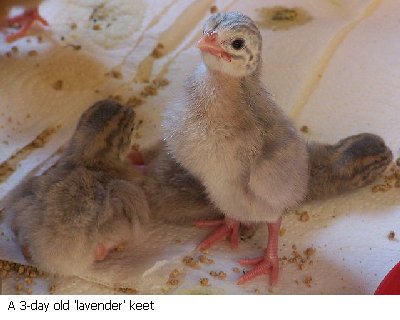
Wikipedia: [NAH]
Guineafowl, sometimes called Pintade, are a family of birds originating from Africa, related to other game birds such as the pheasants, turkeys and partridges, and having a long history of domestication, mainly involving the Helmeted Guineafowl.
They lay 25-30 eggs in a deep, tapering nest. Their eggs are small, dark and extremely thick shelled. The hens have a habit of hiding their nests, and sharing it with other hens until large numbers of eggs have accumulated. The incubation period is 26-28 days, and the chicks are called "keets." As keets they are highly susceptible to dampness (they are indigenous to the drier/arid regions of Africa) and can die from following the mother through dewy grass. However, after their first two to six weeks of growth, they can be some of the hardiest domestic land fowl.
Sexing the birds is not as simple as telling a rooster from a hen chicken. When they are adults, the helmet and wattles of the male are larger than those of the female, and only the female makes the two-note cry imitated as "Buck-wheat!" or "Pot-Rack!" Aside from that, however, the two sexes are mostly identical in appearance. As domestics, guineafowl are valuable pest controllers, eating many insects. They are especially beneficial in controlling the lyme disease-carrying deer tick, as well as wasp nests. While they are rarely kept in large numbers, a few are sometimes kept with other fowl to be used as a security system against birds of prey. They will call with their loud, high shrieking voices if concerned about intruders. They are highly social birds, and tend to languish when alone.
Within the domesticated species, many color variations have been created aside from the "pearl" or natural color of the Helmeted Guinea. These include White, Purple, Slate, Chocolate, Lavender, and Coral blue as well as Bronze, Pewter, Buff Dundotte, Blonde and even various Pieds.
It can be cooked using any recipe that calls for chicken but is considered to be more flavorful and, because of its higher cost, is generally served at special occasions. It is particularly common in French cuisine.
Guineafowl have a long history of domestication, mainly involving the Helmeted Guineafowl; in the UK they were usually known as "Gleanies". The young (called "keets") are very small at birth. The keets are kept in a brooder box inside the house until about six weeks of age, before being moved into a proper coop or enclosure. They eat lice, worms, ants, spiders, weedseeds, and ticks while on range or they can also eat chicken layer crumbles (one kind of commercial bird food) while housed in a coop. The cooked flesh of guineafowl resembles chicken in texture, with a flavour somewhere between chicken and turkey.
Feathersite: [NAH]
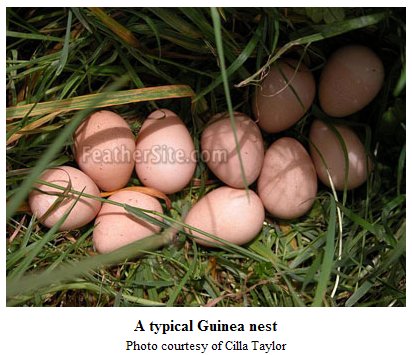 Feathersite |
Guinea Fowl
Numida meleagris
These very noisy birds look like a bunch of AWOL army helmets as they run across the yard. They are said to be good for controlling the Lyme Disease-bearing deer tick. I don't know any research on this, but lots of folk believe it and I sure hope it's true. They certainly range well and eat lots of small things. In fact, if you keep bees, you don't really want to keep guineas. They'll stand by the hive and snap up the bees as they come out. I haven't yellow jacket nests out in the field since I've had these birds.
(For more info on guineas and Lyme disease see: Duffy, David Cameron, R. Downer, and C. Brinkley, 1992. The effectiveness of Helmeted Guineafowl in the control of the deer tick, the vector of Lyme Disease, The Wilson Bulletin, 164(2): 342-345.)
Guineas often lay their eggs out in the fields and hatch their young by themselves. If you do find the eggs and wish to incubate them, the time period is 26 to 28 days and you treat them like chicken eggs. Young guineas are called "keets." Being native to dry areas of Africa, they are very susceptible to dampness during their first two weeks, and can die from following the mother through dewy grass. After two weeks of age, they are probably the hardiest of all domestic land fowl.
Sexing guineas is not easy to do by looking at the birds, although in older adults the helmet and wattles of the males are usually larger. The easiest way to sex them is by voice. Both males and females make a single syllable, machine-gunlike alarm call, but only the females have a two syllable call. It sounds like they're saying "buck-wheat."
When you get new guineas, don't let them out right away or they may well disappear down the street. The best way to acclimate them is to pen them where they can see the area where they'll be living. After they've been penned a week or two, let one out. Guineas hate to be alone, so that one won't go far, but it will learn its way around your place. After a few days, let another out to run with it. If they stay around it's usually safe to let the rest out soon thereafter. I use this same method with Peafowl, letting a new hen out before the male as the hens are more social.
Do not confine male guineas with chickens if there are roosters in the same flock. If the birds have free range during the day it's OK to keep them in the same coop at night, and even for a while if they're confined because of a blizzard or something, but the male guineas will run the roosters ragged and keep them from food and water. I lost my first 2 favorite roosters this way until I learned what was going on. Female guineas do not cause the same problems.
Here's an SPPA article on Guinea Fowl.
SPPA Article on Guineas: [NAH]
Early Birds: Guinea Fowl
by
Dennis Headley
with permission from
SPPA Bulletin, 2003, 8(3):8-9
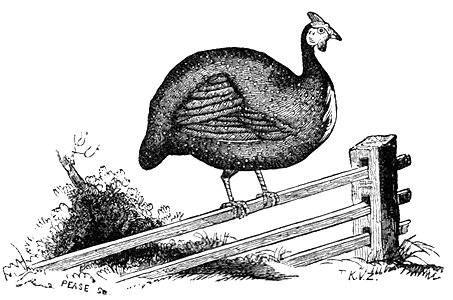
Engraving from The American Poulterer's Companion,
1863
Once, when I was newly married and was seeking low-cholesterol recipes (long before I left most of the cooking to the Stouffer and Ragu companies), I asked my Aunt Pauline if she had cooked "breast of guinea hen." After all, in my late mother's 1949 Joy of Cooking there were instructions to "lard" a "breast of guinea hen" before roasting it, so I reasoned it must be a beneficial, low-fat food which had mysteriously hitherto escaped my notice. "Oh no!" exclaimed Aunt Pauline. "Why, a guinea is such a sweet thing! They mate for life, you know, and when one is gone, the other mourns so!" I hadn't known, and I felt terrible for even thinking of being so cruel. If she, who had been raised on a farm and had never betrayed any visible sentimentality toward animals that I was aware of, had a soft spot for them, they must be something pretty special.
True, I had seen and heard Pearl Guineas before at my Aunt Ruth's farm, where I had the misfortune of startling a whole shed full of them. Apart from their shrieking, the guineas appeared to be demure enough. Round-shouldered, clad in sheer dark feathers with delicate white polka-dots, it was as if they were in mourning dress, the second-stage, more relaxed attire permitted by Queen Victoria after the first ten years of solid black. Now that I have read a number of descriptions of guinea fowl culture, some written within Victoria's very proper reign, I find that the poultry writers share my consternation at the unexpected complications of the guinea-fowl personality. Writers seem to speak of the guinea as they would an eccentric but wealthy relative who has come for an extended visit -- tolerated, even welcomed, in the unspoken hope that one day their benefits will outweigh their inconvenient behaviors. A few, such as E. Davenport in Domesticated Animals and Plants (1910), dismiss the guinea, saying "This noisy little hen is hardly worthy of being ranked as a domesticated fowl. The Guinea is really an African pheasant [sic] . . . rarely kept in numbers, but a few are often found with other poultry to scare off the hawks."
Most others are willing to grant the guinea a larger role in agriculture, however, and describe the best practices for keeping these birds of "a semi-wild nature." One good thing is that guineas are "best of all adapted to the 'let alone' system on a farm, where they will find nearly all their own living . . ." (Wright). In order to begin keeping guineas, F. H. Valentine tells us (in Farm Knowledge, 1918), "It is probably best to start by buying a setting of eggs since old birds are likely to leave a new home and fly back to the farm from which they were bought. They seem to consider the place where they were hatched as home." Place the purchased eggs under a broody hen, wait 26 to 28 days, and keep the newly hatched keets out of the damp and well-fed: six feedings a day are required due to their "very small crops" (Browne). By allowing the baby guineas to be mothered by a chicken, they will "grow up much more tame" than those raised by other Guineas (Wright).
Guineas are described as endearingly easy keepers. It sounds like we shouldn't build pens or order special feed for a guinea, since "Being of a roving disposition, thriving best when not restrained, it is better suited to the general farm where it can roam at will than to the restricted poultry plant. It may steal some grain and perhaps damage berries, tomatoes, and green crops in the garden if not prevented; but it will also destroy many insects and consume many weed seeds. Both old and young will thus obtain the greater part of their living by foraging, benefiting rather than injuring the farm crops" (Valentine).
When grown they "prefer trees for roosts so the cost of housing guineas is slight. Any cheap shed for use in bad weather is ample. Some growers who have had fair success in domesticating guineas put high roosts and well-hidden nests under open sheds and by feeding them regularly close by induce them to roost and lay in the sheds" (Valentine). Lewis Wright adds that guineas "prefer" to "roost in a house . . . in really bad weather, and if brought up to it," but "If they are to lay in the house, some pains should be spent, as with turkeys, to arrange nests which are not only secluded, but look naturally so; otherwise care must be taken to regularly visit all likely places about the farm." Your hunt around the farm is for the guinea's nest, and you should take a stick with you. "The fowls have been known to make a deep, tapering nest, in which they would lay twenty-seven to thirty eggs," which are "remarkably fertile" and "small, about two-thirds the size of an ordinary hen's egg. The shell is very strong, of a dark color, and spotted throughout." Do not depend on the guinea egg money to meet the next mortgage payment, since "The guinea hen's habit of hiding its nest and of sharing it with other guineas until a large number of eggs have accumulated, make egg production a less satisfactory enterprise" (Valentine). You need the stick and a degree of stealth as you gather the eggs because guineas ". . . like to conceal their nest and will leave it if they see a person near it. It is said that they are able to detect whether the hand has touched the nest in their absence, and if so they will desert it. If eggs are removed with a stick or spoon, either some should be left or others substituted so as to leave about five in the nest" (McGrew). When you do market them, remember the importance of presentation: The eggs "if collected fresh, sometimes find a good and regular market at first-class shops, packed in dozen baskets with a little moss, like the eggs of some game birds" (Wright).
Perhaps before we plan to market any eggs, we should solve the basic conundrum of telling the male and female guinea fowl apart. The male "is generally slightly larger, has larger wattles, his voice is a more shrill shriek . . . and he has a peculiar habit of strutting on tiptoe and arching his back." Although neither guinea is very nice to other poultry, the male is "very pugnacious . . . chasing them away from their food" (Wright). Perhaps the female is easier to recognize, since, according to Browne in The American Poultry Yard (1850), "the hen alone uses the call note 'come back, come back,' accenting the second syllable strongly, from which they are often called 'come backs'."
Call them clingy, but the "come back" cry must work, for the males are monogamous, just as my aunt told me. Although Lewis Wright says "The wild bird is monogamous, in domestication two hens may be allowed to one cock; more than this sometimes succeeds, but nearly as often fails," Browne is more detailed on the subject of guinea family life, and he has a slightly different opinion: "There is one circumstance in regard to the habits of the Guinea cock, which may not generally be known; that is he is monogamous, or having one wife only, pairing with his mate, like a partridge, or pigeon, and remaining faithful to her, (perhaps with one or two trifling peccadilloes,) so long as they continue to live together." If one tries to put one male with two females, "it will be found, on close observation, that though the three keep together so as to form one 'pack' according to their original instinct, yet that the cock and one hen will be unkind and stingy to the other unfortunate female, keep her at a certain distance, merely suffering her society, and making her feel that she is with them only on sufferance." The extra hen's eggs would be all right to eat, but will only produce "disappointment and addled eggs" if set. The Guinea hen, presumably happily married, will begin to lay anytime from the end of March through mid-May, and will continue through the end of August, producing 60 to one hundred eggs. Lewis Wright advises setting the April and May eggs, although the guinea hen will usually not go broody until August.
Perhaps guineas were too widely valued as insect-eaters to be killed and eaten themselves, or perhaps the nineteenth century farmer was too sensitive to deprive guineas of their mates, but a market for table guineas never developed. In 1850 this could be attributed to poor timing, since they were being sold during the gap between the last game birds and the first spring chickens, rather than "in late autumn and winter when they are younger" and are "more delicious and tender," "very choice and game-like." Perhaps they never caught on because of their small size (about three and a half pounds, sold intact except for the breast feathers, which were removed). By the end of the 19th century, "A few attempts have been made to breed them in considerable numbers, the most successful of which were in Ohio, where a guinea broiler farm of modest pretensions has been conducted for several years." Resourceful people seem to have made attempts to make use of the guinea by crossing guinea cocks with chicken hens. The "progeny in all such cases . . . [were] very wild and perfectly sterile. The Guinea cock also has been known to cross with small turkey hens occasionally. None of these results are of any practical interest" (Wright).
Should the reader conclude that if the guinea can't be conveniently domesticated, then let it become a game bird, like the pheasant or grouse, think again. It seems, according to Lewis Wright, that the bossy guinea kicks all the other game birds out of the covert, then refuses to fly (although it can do so very well), merely "running before the dogs . . . and . . . affording no sport." Despite its seeming disadvantages, most of the poultry writers maintained hope for the future of the guinea. Although F. H. Valentine does not use the term "niche market," he appears to have something like that in mind: "In reality as a side line in combination with crops to which they do little damage, and where a market for them exists or can be developed, guineas should prove a valuable feature. The bird is fine eating. It is in great demand in city hotels and clubs . . . The meat is dark and the birds are often served as game; prices, therefore, are high as a rule." McGrew adds, "if proper attention were given to the mating of guinea-fowls to improve their size and laying qualities, they could be developed into a most profitable kind of poultry." As it has taken over one hundred years for the guinea to be sufficiently accepted to be admitted to the Standard, it may take another century before it is raised and marketed in the manner of chickens and turkeys.
In the meantime, if its bug-eating talent is not enough to recommend it, then perhaps we should consider keeping the guinea fowl as a security system. "No strange person or noise escapes them, and then their screaming is not only effectual, but calculated of itself to frighten off any evilly disposed marauder" (Wright). The final word, however, is accorded to Browne, who, in passing the following judgment reveals that curious combination of admiration and exasperation found in so many writer's voices on the subject of the guinea: "This bird is no great favorite with poultry keepers, in general, but is one of those unfortunate beings, which, from having been occasionally guilty of now and then a trifling fault, has acquired a much worse reputation than it really deserves. Notwithstanding this, it is useful, ornamental, and interesting during life, and a desirable addition to the table, if properly dressed, when dead."
Bibliography
Browne, D.J., The American Poultry Yard. New York: C.M.
Saxton, 1849.
Davenport, E., Domesticated Animals and Plants. New York:
Ginn and Co., 1910.
McGrew, T. F., "Guinea Fowl," in The Cyclopedia of American
Agriculture, Vol.3, L. H. Bailey, ed., New York: Macmillan Co., 1909.
Valentine, F. H., "Guinea Fowl," in Farm Knowledge: Vol. I,
Farm Animals, E.L.D. Seymour, ed., New York: Doubleday, Page and
Co. for Sears, Roebuck and Co., 1918.
Wright, Lewis., The New Book of Poultry. London: Cassell and
Co., 1905.







The Hamburg or Hamburgh in Britain, is a type of chicken developed in Germany and Holland prior to 1700. It is comparatively rare, with less than 1000 registered in North America each year.
It is a small breed—cocks tend to weigh only 5 pounds and hens about 4 lb (2.25 and 1.75 kg) with slender legs and a neat rose comb. The bird comes in more than ten different varieties, including: Silver-Spangled, Golden-Spangled, Golden-Penciled, Silver-Penciled, White, and Black. Penciled breeds are smallest and self-colored birds are largest... Hamburgs are hardy, active birds who are capable of flight and often jumpy around humans.
Hamburgs mature quickly and are considered good egg producers. Their eggs are rather small with white, glossy shells...
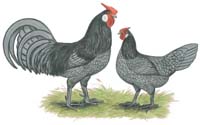
| Male Mature Weight: 5 lbs |
| Female Mature Weight: 4 lbs |
| Comb Type: Rose |
| Egg Color: White
Egg Size: 'Small' Rate of Lay: ~4/week |
| Type: Meat - Laying - Dual-purpose - Other |
| Setting: No |
| Disposition/Temperament: Active, often jumpy around humans, intolerant of confinement |
| Climate Hardiness: All Climates, Winter-hardy [1], [2] |
| ALBC Priority: "Extremely rare" |
| Show Class: Continental |
Ideal Poultry Breeding Farms, Inc:
Blue Hamburgs are an extremely rare white egg variety; very few breeders offer this variety for sale. The blue color is the result of a heterozygous combination of genes; therefore, they do not breed true. Because of this inheritance, a larger than normal flock must be kept to provide an adequate gene pool.
Standard weights at maturity are males-5 lbs. and hens-4 lbs.
When blue (Bl bl) variety males are crossed with blue (Bl bl) variety females, the ratio of colors produced is as follows: 1 black (bl bl), 2 blue (Bl bl) and 1 splash (Bl Bl) (white with a blue cast). Any blue variety ordered from Ideal Poultry may include black, blue or splash chicks.
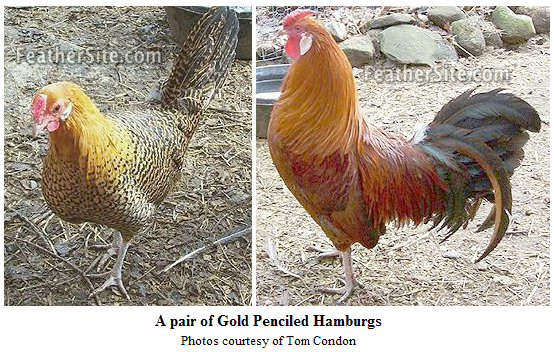 Feathersite |
| Male Mature Weight: 5 lbs |
| Female Mature Weight: 4 lbs |
| Comb Type: Rose |
| Egg Color: White
Egg Size: 'Small' Rate of Lay: ~4/week |
| Type: Meat - Laying - Dual-purpose - Other |
| Setting: No |
| Disposition/Temperament: Active, often jumpy around humans, intolerant of confinement |
| Climate Hardiness: All Climates, Winter-hardy [1], [2] |
| ALBC Priority: Watch |
| Show Class: Continental |
This is an absolutely beautiful variety of the Hamburgs; having finely penciled plumage of black barring on reddish base color, leaden blue shanks and toes, and a neat pointed rose comb. It is a finely built, small, active bird, lays a white egg, and is a non-setter.
Customer comments:
We have two beautiful Golden Hamburgs. Our young children love to hold them. They are great birds for a small
yard. Thanks!
- - -
Dependable egg layers and good foragers - definately ordering some more.
Ideal Poultry Breeding Farms, Inc:
Golden Penciled Hamburgs are one of the very rare varieties of the Hamburg breed, which originated in Holland. They are efficient producers of medium-size white eggs. Because of their productivity in years gone by, they were known as "Dutch Everyday Layers". Because of their refined body shape that resembles a pheasant, they have also been known as "pheasant fowls". They are extremely rare and Ideal is one of only few hatcheries to breed this very attractive variety.
Standard weights at maturity are males-5 lbs. and hens-4 lbs.
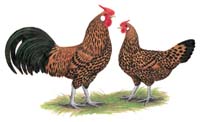
| Male Mature Weight: 5 lbs |
| Female Mature Weight: 4 lbs |
| Comb Type: Rose |
| Egg Color: White
Egg Size: "Medium" Rate of Lay: ~4/week |
| Type: Meat - Laying - Dual-purpose - Other |
| Setting: No |
| Disposition/Temperament: Active, often jumpy around humans, intolerant of confinement |
| Climate Hardiness: All Climates, Winter-hardy [1], [2] |
| ALBC Priority: Watch |
| Show Class: Continental |
Ideal Poultry Breeding Farms, Inc:
Golden Spangled Hamburgs are not as well known as Silver Spangled Hamburgs but are not nearly as rare as some of the other Hamburg varieties; nevertheless, Ideal is one of only a very few hatcheries which breed this variety. The sweeping, graceful, beautiful, unique plumage of Golden Spangled Hamburgs makes them an excellent choice for exhibition. This very active, alert variety, which efficiently produces medium size white eggs, is classified as a non-sitter.
Standard weights at maturity are males-5 lbs. and hens-4 lbs.
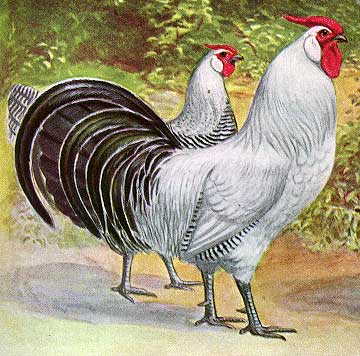
|
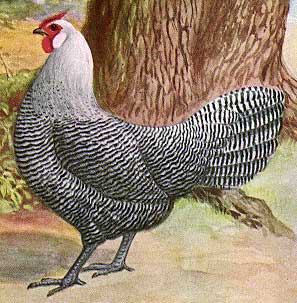 U of OK |
| Male Mature Weight: 5 lbs |
| Female Mature Weight: 4 lbs |
| Comb Type: Rose |
| Egg Color: White
Egg Size: 'Small' Rate of Lay: ~4/week |
| Type: Meat - Laying - Dual-purpose - Other |
| Setting: No |
| Disposition/Temperament: Active, often jumpy around humans, intolerant of confinement |
| Climate Hardiness: All Climates, Winter-hardy [1], [2] |
| ALBC Priority: Watch |
| Show Class: Continental |
Ideal Poultry Breeding Farms, Inc:
Silver Penciled Hamburgs are one of the very rare varieties of the Hamburg breed, which originated in Holland. They are classified as an ornamental, non-setting, white skinned, good producers of white-shelled eggs. They have a very distinctive head with a medium size bright red rose comb, which terminates in the rear with a moderately long, pointed spike that inclines upward very slightly. Ideal is one of only a few hatcheries to breed this rare variety.
Standard weights at maturity are males-5 lbs. and hens-4 lbs.
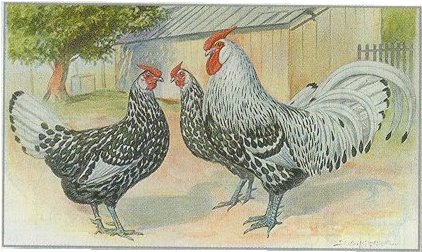
| Male Mature Weight: 5 lbs |
| Female Mature Weight: 4 lbs |
| Comb Type: Rose |
| Egg Color: White
Egg Size: 'Small' Rate of Lay: ~4/week |
| Type: Meat - Laying - Dual-purpose - Other |
| Setting: No |
| Disposition/Temperament: Active, often jumpy around humans, intolerant of confinement |
| Climate Hardiness: All Climates, Winter-hardy [1], [2] |
| ALBC Priority: Watch |
| Show Class: Continental |
These are one of the snappiest, most alert breeds on the poultry list. Of rather small size, with light but sweeping, graceful outlines, they are elegant and beautiful. They have a kind of bright cheerfulness about them when foraging over open range and they love this kind of situation. Their origin goes back beyond the memory of man in both England and Holland and they were such prolific layers of white eggs that a common name for them was "the Dutch Everyday Layer." Although egg size is medium they are small eaters and cost less to keep than most breeds. The lustrous greenish black spangles on silvery white plumage give them a perky polkadot look. With neat rose combs, white ear lobes, leaden blue shanks and toes, these are excellent small birds for both beauty and utility. Baby chicks are a silver gray with parallel dark and light stripes on the back.
Customer comments:
My Hamburg rooster is really a beautiful bird. The kids love to pick him up and hold him and he just lets
them. Thank you McMurray for sending me a great mystery bird.
- - -
We own an absolutely beautiful Silver Spangled Hamburg rooster we call Spangle. He is definetly the most
nervous chicken in the flock, though we manage to catch him, he is very gentle. He is just gorgeous! This
variety would be very nice for show. It would also be great for fly tyers, to. I'm thinking about ordering
some more of these great chickens for 4-H this year. I can't praise their beauty enough!
- - -
Our Silver Spangled Hamburgs are growing like crazy! They are very alert birds and are as happy as can be
on free range! They are becoming beautiful birds, who eat less than our others! Almost full grown, they are
a bit more nervous than the others, but they will come and climb up on my leg and roost there for a while!
I love them to death! -Laura M in Eastford, CT
This breed is a Dutch breed and not of German origin. The spangled variety was evolved in England and admitted into the American Standard of Perfection in 1874.Our Silver Spangled Hamburg's are a combination of beauty and utility. These birds with symmetrical body, graceful carriage and attractive color have made them a very popular exhibition variety. Notable features: large rose comb and large round white ear lobes.
Hen----------4 lbs
Rooster------5 lbs
Pullet-------- 3 1/2 lbs
Cockerel----4 lbs
Ideal Poultry Breeding Farms, Inc:
Silver Spangled Hamburgs are the best-known variety of Hamburgs. They are a very old domesticated breed that originated in Holland. They are classified as a white skinned, ornamental, non-sitting, good layer of medium size white-shelled eggs. They are efficient, prolific producers of eggs and were known in England as the "Dutch Everyday Layer". Because of the symmetrical body, graceful carriage and attractive color pattern, Silver Spangled Hamburgs are one of the most popular exhibition birds.
Standard weights at maturity are males-5 lbs. and hens-4 lbs
Silver Spangled Hamburgs are a very old domesticated breed originating from Holland, and are the best-known variety of Hamburg. One of the most popular exhibition birds, they are also prolific and very efficient layers. They are identified in England as the “Dutch Everyday Layer”. Silver Spangled Hamburgs are an attractive and energetic bird that will do well foraging in large open areas.
Comb: Rose.
Standard weight at maturity: Hens 4 lbs, males 5 lbs.
Egg color: White
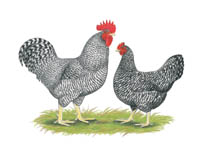
| Male Mature Weight: 8 lbs |
| Female Mature Weight: 6 lbs |
| Comb Type: Single |
| Egg Color: White
Egg Size: "Medium" Rate of Lay: "High", ~3/week |
| Type: Meat - Laying - Dual-purpose - Other |
| Setting: Seldom |
| Disposition/Temperament: Friendly, calm, quiet, bears confinement well |
| Climate Hardiness: All Climates, Winter-hardy [1], [2] |
| ALBC Priority: Critical |
| Show Class: American |
Ideal Poultry Breeding Farms, Inc:
Barred Hollands were developed to get a large bird that laid white eggs. They are one of only a few breeds, which do not have white ear lobes that lay white-shelled eggs. Males and females both have barred plumage, but the females are darker than the males as a result of the action of the barred (B) gene that is sex linked. They have clean yellow shanks and toes with yellow skin.
Standard weights at maturity are males-8 lbs. and hens-6 lbs.
Wikipedia: [NAH]
Hollands are a fairly rare breed of large chickens that are dual purpose and originate from America.
The breed started with birds imported from Holland being crossed with White Leghorns, Rhode Island Reds, New Hampshires, and Lamonas, which created the White Hollands. Another cross that included White Leghorns, Barred Plymouth Rocks, Australorps and Brown Leghorns produced the barred variety of Hollands. Both were accepted by the American Poultry Association in 1949.
General Information:
* Class: American
* Varieties: White and Barred
* Purpose: Dual (egg and meat)
* Egg Size / Color: Medium / White
* Skin Color: Yellow
* Standard Weights: Cock - 8½lbs; Hen - 6½lbs; Cockerel - 7½lbs; Pullet - 5½lbs
Backyard Chickens.com: [NAH]
"Barred Hollands can be sexed by their color from day one & in my book that is a good thing. Notice the male is lighter in the adolecent picture. I find these birds to be calm & gentle, a pleasure to have in my flock. In general they are quiet, but when you go near them they talk to you." - Wish4Mee"
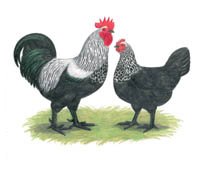
| Male Mature Weight: 6 lbs |
| Female Mature Weight: 5 lbs |
| Comb Type: Single |
| Egg Color: Brown
Egg Size: Unknown Rate of Lay: 'A good amount' |
| Type: Meat - Laying - Dual-purpose - Other |
| Setting: Yes |
| Disposition/Temperament: Unknown |
| ALBC Priority: Study |
| Show Class: Not recognized |
Ideal Poultry Breeding Farms, Inc:
Iowa Blues, which are extremely rare, were developed in Iowa. They were named Iowa Blues because Iowa did not have a breed of chickens named after it. They are a dual-purpose, yellow skinned breed that produces brown-shelled eggs and are large enough to also be used for production of fowl meat. They have the birchen plumage pattern, which is primarily black with white.
Standard weights at maturity are males-6 lbs. and hens-5 lbs.
Wikipedia: [NAH]
The Iowa Blue is a breed of chicken that originated near Decorah, Iowa in the early 20th century. Despite its name, the breed is not actually blue according to poultry standards. It is an exceedingly rare fowl, and is not recognized for showing by the American Poultry Association. They are a dual-purpose breed laying brown eggs and known to be good foragers.
The Iowa Blue's exact origin is unknown, but is the subject of a folksy legend that is said to have involved the mating of a White Leghorn hen and a Pheasant. This is especially unlikely considering that Leghorns are light-weight birds with white earlobes, yellow skin, and which lay white eggs. Iowa Blues are have never been recognized officially by the American Poultry Association, American Bantam Association, or any other breed standard. In to the 1960s, several hatcheries around Iowa sold the breed, but after these hatcheries either closed or stopped selling them, the Iowa Blue nearly disappeared. Dedicated breed enthusiasts have preserved the breed in to the 21st century, though their numbers remain small. It is listed as "Study" by the American Livestock Breeds Conservancy, entailing that is of conservation interest but lacks the documentation to be firmly categorized.
Iowa Blues are a dual-purpose chicken. With males weighing 7.5 pounds (3.2 kilos) and hens 6 pounds (2.75 kilos), they can produce a fair amount of meat. Hens lay a good amount of brown eggs, and will go broody. They are also known to be good foragers, and will do well in free range conditions.
The breed has red earlobes, and a single comb. They appear in a single color variety, which is not actually the blue color defined by poultry breed standards. It has a silvery white head, and the body plumage is dark brown or black with white lacing. The back is also white in roosters, and the overall color is technically referred to as "penciling". When mated with other breeds, especially White Plymouth Rocks or New Hampshires, Iowa Blues will produce sex linked hybrid offspring.
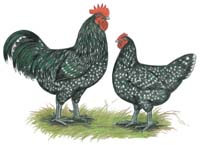
| Male Mature Weight: 9.5 lbs |
| Female Mature Weight: 7.5 lbs |
| Comb Type: Single |
| Egg Color: Brown
Egg Size: 'Large' Rate of Lay: ~2/week |
| Type: Meat - Laying - Dual-purpose - Other |
| Setting: Yes |
| Disposition/Temperament: Docile, bears confinement well |
| Climate Hardiness: not winter-hardy [2] |
| ALBC Priority: Critical |
| Show Class: American |
Ideal Poultry Breeding Farms, Inc:
Mottled Javas came to the United States from the Far East and are named after the Island of Java. They were a very popular dual-purpose brown egg breed during the 19th Century. Currently they are kept primarily for exhibition and for their uniqueness. Mottled Java chicks are some of the most beautiful of all chicks with a distinct mottled color pattern. They have black backs with most of the remainder of their soft fluffy down being light cream.
Standard weights at maturity are males-9 1/2 lbs. and hens-7 1/2 lbs.
Wikipedia: [NAH]
The Java is a breed of chicken originating in the United States. Despite the breed's name, which comes from the island of Java in Indonesia, it was developed in the U.S. from chickens of unknown Asian extraction. It is one of the oldest American chickens, forming the basis for many other breeds, but is critically endangered today.
Javas are large birds with a sturdy appearance. They are hardy, and are well-suited for both meat and egg production, especially by small-scale farms, homesteads, and backyard keepers.
Javas are heavy chickens, with roosters weighing around 9.5 pounds (4.3 kilos) and hens 6.5 to 7.5 pounds (2.9 to 3.4 kilos). They have a very long, broad back and a deep breast, which makes for a solid, rectangular build. They have small earlobes and medium size combs and wattles, all of which are red in color. Javas have single combs, but they have a shape which suggests the influence of a pea-combed breed in their development.
Javas appear in three color variations today: Black, Mottled, and White. The Black has black shanks and beaks, though some yellow may appear in the legs. The plumage is a uniform black hue that has a dark green sheen in the light. The Mottled and White have mostly yellow skin, with horn colored beaks. The plumage of the Mottled is a black base with white markings on the tips of feathers, which imparts a spotted appearance.
Javas are valued for their dual-purpose characteristics. Though they are slow-growing compared to the broilers used by the commercial chicken industry today, they produce a good carcass. Hens lay a respectable amount of large, brown eggs and will go broody. Javas are particularly known as good foragers, needing less supplementary feed than many breeds when allowed to free range. Like many large breeds, they are known to be docile in temperament, and hardy in inclement weather. In general, Javas are particularly suitable for keepers of smaller flocks who require a good dual-purpose chicken.
After the Dominique, the Java is the oldest breed of chicken created in the U.S... It was first mentioned in print in 1835, but it is thought to have been present well before this time. Javas were especially notable as meat production birds throughout the 19th century, with their popularity peaking in the latter half of that century.
The Java is a key foundation breed for the American class of chickens, having contributed significantly to major modern fowl such as the Jersey Giant, Rhode Island Red and Plymouth Rock. They are also likely to be the source of the yellow skin in contemporary Dominiques, which once had white skin...
Javas had nearly vanished by the end of the 20th century, having been pushed to the fringes of the poultry world by the intense focus on one or two breeds by commercial growers, and the introduction of innumerable new and exotic breeds to poultry fancy. Beginning in the 1990s, breeders and conservation organizations began to make a more concerted effort to save the Java. In particular, the Garfield Farm Museum in Illinois has played a pivotal role in the preservation of Javas in the 21st century. Beginning with Mottled and Black Javas, sports from the Garfield flock have revived the White variety. The Garfield Farm was also been supported by the Museum of Science and Industry in Chicago, which hatched Java chicks as part of their exhibit on genetics.
The American Livestock Breeds Conservancy continues to list Javas as Critical on its watchlist, meaning fewer than 500 breeding birds from five or fewer primary breeding flocks are known (this does not take in to account the population of non-breeding flocks)...
Feathersite: Article about Java history and status
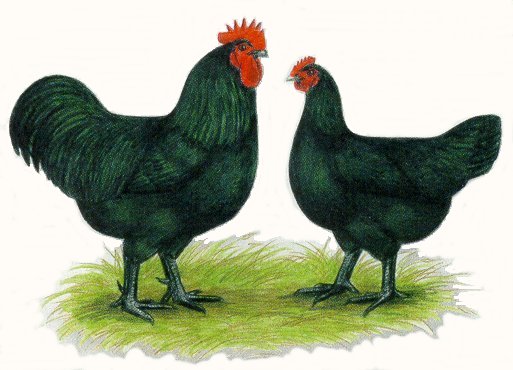
| Male Mature Weight: 13 lbs |
| Female Mature Weight: 10 lbs |
| Comb Type: Single |
| Egg Color: Brown
Egg Size: 24-25 Ounces/dozen Rate of Lay: "Good", ~3/week |
| Type: Meat - Laying - Dual-purpose - Other |
| Setting: "Seldom" |
| Disposition/Temperament: Docile, bears confinement well |
| Climate Hardiness: Cold, Winter-hardy [1], [2] |
| ALBC Priority: Watch |
| Show Class: American |
This is the original Jersey Giant developed in New Jersey in the late 19th century by crossing several of the large, dark Asiatic breeds. It is a super heavy bird even a little larger than the whites. Its black plumage has a beautiful green sheen, the eyes are dark brown, shanks and toes are black except for yellow skin showing on the bottoms of the feet. With the straight red comb and tremendous size it makes an unusually handsome variety for exhibition. Hens are good layers of brown eggs and especially persistent through cold weather. Baby chicks are mostly black but do show creamy patches on the underbody, wing tips, and around the face. The white persists in the plumage until final molt of chick feathers takes place.
Customer comments:
Dear McMurray Hatchery I love these chickens! My dad ordered 30 Black Giants for me about a year ago. When
I got them, they were all healthy and peeping merrily. As they grew, I enjoyed having them even more.
Now I'm selling their eggs, which are very large and delicious. The roosters I have are enormous too! I have
even started hatching my own. All of my egg customers love their eggs. These are birds for meat or eggs.
I had such a great time with my Black Giants that my dad and I have ordered a total of 160 more chickens,
including some White Giants, from you for this summer. Thanks McMurray for your excellent service!!
- - -
I was given the Black Giants as a gift. They are good pets. I have had them since 2004. Nice big eggs.
Was originated in the State of New Jersey during the 1880's. A good heavy breed however, slower to grow than some breeds before surpassing them in weight and size. When grown the black feathers take on a green sheen within the black color. Admitted to the American Standard of Perfection in 1922 and both varieties noted for willow colored or nearly black legs and toes.
Hen -------10 lbs
Rooster----13 lbs
Pullet-------9 lbs
Cockerel---11 lbs
Ideal Poultry Breeding Farms, Inc:
A very large docile breed that grows relatively slowly and is not a good choice for the production of broiler meat.
Jersey Black Giants, which are very attractive, are the largest of the dual-purpose breeds. Although they may have some white feathers from the time of hatching until they molt their juvenile plumage, they are solid black when mature, but they do not have as much green sheen as Black Australorps. They grow very slowly and are a poor choice for the production of broiler meat; however, the hens may be expected to weigh 9 pounds and are a good source of fowl meat, and brown shelled eggs.
Standard weights at maturity are males-13 lbs. and hens-10 lbs.
Jersey Black Giants were developed in the late 1800’s to meet the demand for a large meat bird. They were developed from crosses of Langshans, Orpingtons, and Javas, resulting in the largest breed of chicken developed in America. They grow a large frame first before filling out with enough meat to harvest at about 6 months old. The hens are good egg layers, even through cold weather.
Comb: Single.
Standard weight at maturity: Hens 10 lbs, males 13 lbs.
Egg color: Brown
See also: Backyard Chickens.com: Jersey Giant [NAH]
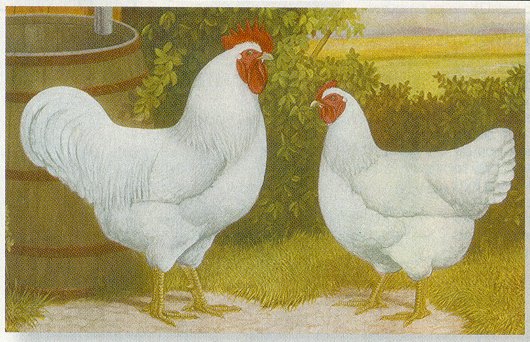
| Male Mature Weight: 13 lbs |
| Female Mature Weight: 10 lbs |
| Comb Type: Single |
| Egg Color: Brown
Egg Size: 24-25 Ounces/dozen Rate of Lay: "Good", ~3/week |
| Type: Meat - Laying - Dual-purpose - Other |
| Setting: "Seldom" |
| Disposition/Temperament: Docile, bears confinement well |
| Climate Hardiness: Cold, Winter-hardy [1], [2] |
| ALBC Priority: Watch |
| Show Class: American |
This very heavy white variety of the Jersey Giant breed was developed from white sports of the Black Giants, and is a comparative newcomer to the ranks of purebred standard chickens. As the name implies, it is primarily a meat bird of extra large frame. A little slower to mature than Rocks, Reds, and other more common heavy breeds, it will eventually surpass them in size and weight. Yellow skin color and white plumage make an easy fowl to dress. Distinctive features in addition to size are the dark willow color of shanks and toes, and the very dark brown eye. Mature hens are very large and good layers of brown eggs. Baby chicks are a real smoky gray varying from almost black to quite light. The adult birds have a tendency to show some dark or gray ticking on an occasional feather, and both the chick and adult color are the result of the fairly recent development of this variety from the Black Giants.
Customer comments:
Dear,Murray Mcmurray Hatchery Last year I purchased 25 of your White Giant hens and I am very pleased with them.
They are a pleasing site to look at,they also lay enough eggs to feed the family and even relatives!
My grandmother always likes to see a dozen or more big beautiful brown eggs brought in everyday. Ive had
chicks for as long as I can remember,I am now 14 and I plan on having them for the rest of my life.
Jersey White Giant is a very heavy bird. Like the Black Giant they are a little slower to mature than some other heavy breeds, but eventually surpass them in size and weight. The baby chicks are smoky gray but feather out white. The hens lay brown eggs.
Hen -------10 lbs
Rooster----13 lbs
Pullet-------8 lbs
Cockerel---11 lbs
Ideal Poultry Breeding Farms, Inc:
Jersey White Giants, are not as well known as Black Giants. Both varieties of Jersey Giants, which lay brown eggs, originated in New Jersey during the 1880's by crossing Black Javas, Dark Brahmas and Black Langshans. They are very large and present an imposing sight with their solid white plumage contrasting with their dark willow shanks. Although the chicks appear to be smoky or black, the adults will be completely white.
Standard weights at maturity are males-12 lbs. and hens-9 lbs
See also: Backyard Chickens.com: Jersey Giant [NAH]
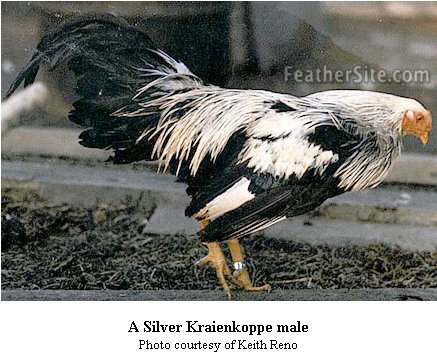
This breed was developed in Holland and Germany in the mid- nineteenth century. Among the breeds in its ancestory are Leghorns and Malays.
The birds have an upright stance, long back, strong head and are very fully feathered in the hackle and saddle. The walnut comb and wattles are quite small.
Wikipedia: [NAH]
The Kraienköppe (singular: Kraienkopp), also called the Twentse, is a breed of chicken originating on the border region between Germany and the Netherlands. The latter of the two names is the Dutch language version, while the former is German. Kraienköppe appear in two color varieties: Black-breasted Red and Silver. Males weigh 2.75 kilos (6 pounds), and females weigh 1.8 kilos (4 pounds). They have yellow skin and a small walnut-type comb.
The Kraienköppe breed was developed from crosses of Leghorns and Malays. It is rare today, and is best known as a layer and a show bird. Hens lay a fair number of off-white eggs, and will go broody. Kraienkoppes are active fowl with excellent foraging abilities.
The black breasted red and silver Kraienköppe upon being brought to America has enjoyed widespread acclimation on American farms and ranches due to the thriftiness and hardiness of this breed.
...Along with the eye-catching feathers, they have a walnut comb, yellow shanks and red ears. They are productive layers of small, off-white eggs. They are docile but flighty at times, much like the Leghorn. Unlike the Leghorn, they will set well and make attentive mothers. Aggressive foragers, their smaller combs make them winter hardy, while their petite size means they also handle summer heat well.
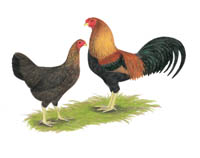
| Male Mature Weight: 6.5 lbs |
| Female Mature Weight: 5.5 lbs |
| Comb Type: Pea or "Walnut" |
| Egg Color: Tinted
Egg Size: 'Small' Rate of Lay: 'A fair number' |
| Type: Meat - Laying - Dual-purpose - Other |
| Setting: Yes |
| Disposition/Temperament: Active |
| Climate Hardiness: All climates, Winter-hardy [5] |
Ideal Poultry Breeding Farms, Inc:
Kraienkoppes, which are an extremely rare tinted egg breed, originated in Holland and Germany in the mid-Nineteenth Century. They have a powerful expression with an upright, elegant stance, long back and strong head, that has a small walnut comb. Their alert fiery eyes are set somewhat under overhanging brows. Black Breasted Red Kraienkoppes have the same plumage pattern as Black Breasted Red Old English Bantams.
Standard weights at maturity are males-6 1/2 lbs. and hens-5 1/2 lbs.
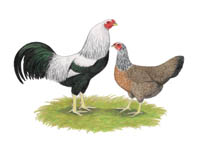
| Male Mature Weight: 5.5 lbs |
| Female Mature Weight: 4.5 lbs |
| Comb Type: Pea or "Walnut" |
| Egg Color: Tinted
Egg Size: [Unknown] Rate of Lay: 'A fair number' |
| Type: Meat - Laying - Dual-purpose - Other |
| Setting: Yes |
| Disposition/Temperament: Active |
| Climate Hardiness: All climates, Winter-hardy [5] |
Ideal Poultry Breeding Farms, Inc:
Silver Kraienkoppes, which are extremely rare, are kept in the United States primarily for the preservation of this unique breed, which lays tinted eggs. Silver Kraienkoppes have the same plumage pattern as Silver Duckwing Old English Bantams. They have a powerful expression with an upright, elegant stance, long back and strong head that has a small walnut comb. Their fiery eyes are set somewhat under overhanging brows.
Standard weights at maturity are males-5 1/2 lbs. and hens-4 1/2 lbs.
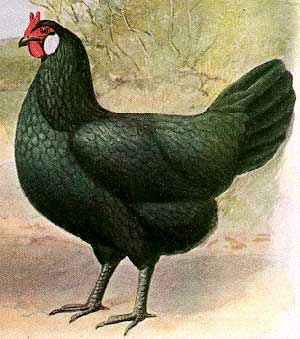 Backyard Chickens.com |
 Wikipedia |
| Male Mature Weight: 7-8 lbs |
| Female Mature Weight: 6.5-7.5 lbs |
| Comb Type: V |
| Egg Color: White
Egg Size: "Large" Rate of Lay: Up to 180/year |
| Type: Meat - Laying - Dual-purpose - Other |
| Setting: "Seldom" |
| Disposition/Temperament: Wild, restless, shy, bears confinement well |
| Climate Hardiness: Heat, not winter-hardy [1], [2] |
| ALBC Priority: Watch |
| Show Class: Continental |
Ideal Poultry Breeding Farms, Inc:
La Fleche, which originated in France, is a white skinned breed that lays white eggs. Their identifying feature is the relatively large V-shaped comb, which has resulted in the nickname "Devil Breed". The nostrils are wide and cavernous. They have close fitting, lustrous greenish surface plumage and dull black undercolor. The shanks are long and are dark slate in color. They are a dual-purpose breed that is used for both meat and eggs.
Standard weights at maturity are males-7 to 8 lbs. and females-6 1/2 to 7 1/2 lbs.
[See also Feathersite's comments on the Polish breeds]
Wikipedia: [NAH]
...They are usually used as ornamental birds, but still are appreciated in high-level restaurants in France for its fine meat.
Backyard Chickens.com: [NAH]
La Fleche... are a rare breed with only a few birds scattered around the countries. They have been mentioned in books from the 1400s onwards. They are sometimes used as ornamental birds, but can be used for egg production, as they can lay up to 180 per year and can be used for meat as the cocks may weight 8-10lbs. They are good foragers in open areas and are slow maturing...
"They bear confinement well and and shy and untamed... Thanks to Oklahoma University" - eggsrcool
Lakenvelders or Lakenfelders are a breed of chicken developed in the 1830’s in Germany despite their Dutch name. Characteristics of the breed are black head, collar, and tail, white body, white skin and slate colored legs. The Lakenvelder is a flighty breed that is a good forager if allowed to free range. While it does well on range, it also bears confinement well. It has a small 4-5 pound body and is a good layer of small to medium a white or cream eggs, but is a non-setter.
The Lakenvelder originated in the Levant from Egyptian Fayoumi and Persian progenitors. It was developed as its own breed for centuries in Palestine where it was known as the Tel Megiddo (Hebrew) or Tell al-Mutesellim (Arabic) fowl. Roman Jewish immigrants brought this ancient breed to the Westfalen area of Germany during the Roman era around 1 A.d.. Westphalian Jews refined and conserved this breed for centuries before it was widely known to non-Jewish Europeans. The Lakenvelder's eggs were used primarily in baking.
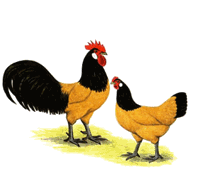
| Male Mature Weight: 5 lbs |
| Female Mature Weight: 4 lbs |
| Comb Type: Single |
| Egg Color: White
Egg Size: 'Small to medium' Rate of Lay: 'Good', ~ 3/week |
| Type: Meat - Laying - Dual-purpose - Other |
| Setting: No |
| Disposition/Temperament: Active and quick, bears confinement well |
| Climate Hardiness: All Climates, not winter-hardy [1], [2] |
| ALBC Priority: Threatened |
| Show Class: Not recognized |
Ideal Poultry Breeding Farms, Inc:
Golden Lakenvelders are a little-known variety of Lakenvelders. The recessive gold (s) gene to produce Golden Lakenvelders has replaced the dominant silver (S) gene of Silver Lakenvelders. The American Standard of Perfection does not recognize them, although, they reproduce as a pure breed. They are active, good hustlers, relatively small and efficient white egg producers.
Standard weights at maturity are males-5 lbs. and hens-4 lbs.
[See Silver Lakenvelder below for more background.]
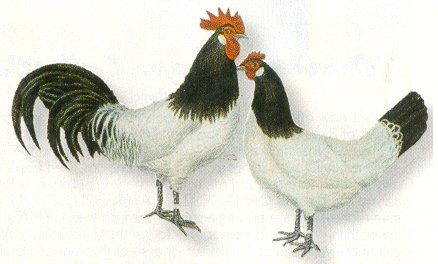
| Male Mature Weight: 5 lbs |
| Female Mature Weight: 4 lbs |
| Comb Type: Single |
| Egg Color: White
Egg Size: 'Small to medium' Rate of Lay: 'Good', ~3/week |
| Type: Meat - Laying - Dual-purpose - Other |
| Setting: No |
| Disposition/Temperament: Active and quick, bears confinement well |
| Climate Hardiness: All Climates, not winter-hardy [1], [2] |
| ALBC Priority: Threatened |
| Show Class: Continental |
These are one of the most beautiful in appearance of any of our rare varieties with their striking black and white markings and slate colored legs. We are told that the word “Lakenvelder” when translated from the Dutch means “a shadow on a sheet”, a particularly descriptive name. They were bred extensively in Germany and Holland as long ago as the early 1800’s, but were not recognized here until the 1930’s. They are quite small when mature, 3 to 4 Ibs., and very quick and active, foraging widely if allowed to run. The skin is white and the breast unusually plump and round, almost like wild game birds. Hens lay white eggs and are non-setters. Baby chicks are mostly creamy white with a half collar of black on the neck and sprinkling of black on the head and back.
Customer comments:
My Lakenvelder rooster is by far the best rooster I have ever owned. He keeps order in my flock, protects
my hens and is very gentle with them also. I have seen him catch grasshoppers and worms and proudly bring
them to 'his' girls. We have several other roosters of differant breeds in the flock but he keeps order, if
someone starts something, it is ended quickly just by his presance. If you want a good rooster to keep your
girls happy and safe this is the breed for you.
- - -
I received my order of Lakenvelder hens today. I have dealt with many hatcheries before but McMurray is by
far the best of all of them. I added my quik chik mix to their water, and these birds are all over the place.
The liveliest and most energetic chicks by far.
This breed dates back to the 1830's in Germany. This breed was first exhibited in England in 1902 and was admitted to the American Standard of Perfection in 1939. These are one of the most beautiful in appearance of any of our rare varieties with their striking black and white markings and slate colored legs. Very quick and active, foraging widely if allowed to run. The hens lay white eggs and are non-setters. The name is referred to as "a shadow under a sheet."
Hen---------4 lbs
Rooster-----5 lbs
Pullet-------3 1./2 lbs
Cockerel---4 lbs
Ideal Poultry Breeding Farms, Inc:
Silver Lakenvelders are the best-known variety of Lakenvelders which are an old established breed of German origin. The name "Lakenvelder" is referred to as meaning "white spread over a black field." Others refer to the name as meaning "a shadow on a sheet." The combination of graceful carriage together with the striking sharp contrast of black and white plumage attracts attention wherever they are found. They are active, good hustlers, relatively small and efficient white egg producers.
Standard weights at maturity are males-5 lbs. and hens-4 lbs.
Of German origin, this breed was brought to the United States in the 1900’s. The Lakenvelder is an efficient egg producer of medium white eggs, but is now considered a rare variety that is used primarily for exhibition. The combination of their graceful carriage and striking contrasts of black and white plumage make them an extremely attractive breed. Good foragers and cold weather breed.
Comb: Single.
Standard weight at maturity: Hens 4 lbs, Males 5 lbs.
Egg color: White (sometimes tinted)
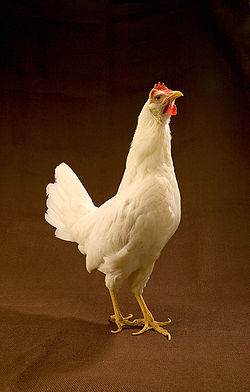 Wikipedia |
The Leghorn is a breed of chicken with origins in Tuscany, central Italy. The first birds imported to North America in 1853 were called Italians. By 1865 the breed was named after the Italian city of Livorno, on the western edge of Tuscany, which in English is also known as Leghorn.
White Leghorns are among the most popular commercial strains of layer chickens worldwide. Pure bred Leghorn varieties are less common. Both the American Poultry Association (APA) and the American Bantam Association (ABA) recognize a number of Leghorn varieties including white, red, black tailed red, light brown, dark brown, black, blue, buff, Columbian, buff Columbian, barred, exchequer and silver. Most have single combs but there are several color varieties that have rose combs.
Leghorns are excellent layers of white eggs (around 280 per year) with a superior feed-to-egg conversion ratio. Leghorns rarely exhibit broodiness and are thus well suited for uninterrupted egg laying. The Leghorn is a light breed that matures quickly to only 3 or 4 lbs and is not considered a viable meat producer. Leghorns are active and efficient foragers. They typically avoid human contact and tend to be nervous and flighty.
Due to their prolific egg-laying, they are preferred by laboratories for embryonic and avian biological research as well as being the number one breed used for large-scale commercial egg production in the United States.
Leghorns are noisy birds, and somewhat smaller than other breeds. However, they are larger in size than the bantam.
Backyard Chickens.com: [NAH]
"I love Leghorns! They are great layers, beautiful birds, and if raised right very friendly. Leghorns are usually very flighty and scared, but when I raised mine from day old chicks they were/are friendly and love to be held. They lay nice tasty, white eggs almost every day, they get along well with other breeds of chickens and they are very funny and full of character." - Settler'sDreamFarm
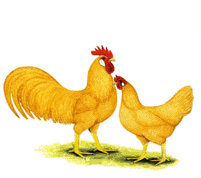
| Male Mature Weight: 6 lb |
| Female Mature Weight: 4.5 lb |
| Comb Type: Single |
| Egg Color: White
Egg Size: "Large" Rate of Lay: "Prolific" (~280/year) |
| Type: Meat - Laying - Dual-purpose - Other |
| Setting: No |
| Disposition/Temperament: Active, bears confinement well |
| Climate Hardiness: All Climates, not winter-hardy [1], [2] |
| ALBC Priority: Recovering |
| Show Class: Mediterranean |
Ideal Poultry Breeding Farms, Inc:
Buff Leghorns are a rare variety of Leghorns, which are known for prolific, efficient production of white eggs. Leghorns, which are very active, are one of the most stylish of all breeds and are classified as non-sitters. Leghorns came originally from Italy, but many of the varieties were developed in England, Denmark and America. The rare Buff variety, which will become more popular when they become more readily available, is a beautiful even shade of rich golden buff.
Standard weights at maturity are males-6 lbs. and hens-4 1/2 lbs
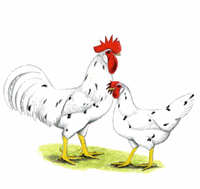
| Male Mature Weight: 4.5 |
| Female Mature Weight: 4.5 |
| Comb Type: Single |
| Egg Color: White
Egg Size: 25-26 Ounces/dozen Rate of Lay: "Excellent" |
| Type: Meat - Laying - Dual-purpose - Other |
| Setting: No |
| Disposition/Temperament: [Unknown] |
The California White is a cross between our best White Leghorn hen with a California Grey Rooster.
They grow fast and lay lots of big white eggs.
[Note they are based on a different cross than Ideal's California Whites.]
Hen -------5 1/2 lbs
Rooster----7 lbs
Pullet------5 lbs
Cockerel---6 lbs
Ideal Poultry Breeding Farms, Inc:
Excellent exterior egg quality and length of lay.
California Whites are a breed cross of Production Blacks and White Leghorns. They have superior hybrid vigor, which results in excellent livability. They are excellent layers of smooth textured white eggs and are known as efficient producers for an extended period of time.
The mature weight of this cross is 4.5 pounds, which is heavier than most commercial white egg layers.
Because the Ideal 236 is such an outstanding cross, Ideal reserves the right to substitute Ideal 236 chicks for California Whites.
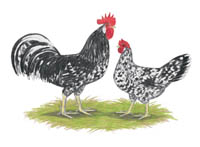
| Male Mature Weight: 5.5 lbs |
| Female Mature Weight: 4.5 lbs |
| Comb Type: Single |
| Egg Color: White
Egg Size: "Large" Rate of Lay: 'High', ~3/week |
| Type: Meat - Laying - Dual-purpose - Other |
| Setting: No |
| Disposition/Temperament: [active], bears confinement well |
| Climate Hardiness: All Climates, not winter-hardy [1], [2] |
| ALBC Priority: Recovering |
| Show Class: Mediterranean |
Developed within a Leghorn flock by Mr. Robert Miller of Scotland between 1905 and 1907 and introduced in 1907 under the name Exchequer. As the name suggests by the black and white chequering in color. Notes: Considered a rare breed here in the United States, matures early and high white egg production.
Hen--------5 lbs
Rooster----6 lbs
Pullet------4 lbs
Cockerel--5 lbs
Ideal Poultry Breeding Farms, Inc:
Exchequer Leghorns are extremely rare and are kept primarily because of their unique plumage pattern. Both the males and females have plumage with black and white evenly distributed which is the result of the recessive pied (pi) gene. Leghorns are known for their efficient production of white-shelled eggs, but this variety should not be expected to lay at the same rate as White Leghorns which have been selected for many years.
Standard weights at maturity are males-5 1/2 lbs. and hens-4 1/2 lbs.
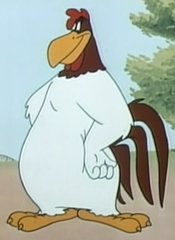 Wikipedia |
| Male Mature Weight: ~40 lbs |
| Comb Type: Single |
| Egg Color: N/A |
| Type: Meat - Laying - Dual-purpose - Very, very Other |
| Setting: And Jawboning- as much as possible |
| Disposition/Temperament: Bombastic, mischievous |
| Climate Hardiness: Must be Heat 'cause he makes it hot for himself |
| ALBC Priority: One of a Kind |
| Show Class: Conceal Under Bushel Basket Whenever Possible |
Wikipedia: (NAH) (thank goodness)
Foghorn Leghorn is a large, anthropomorphized adult rooster with a strong Kentucky accent, a "good ol' boy" speaking style, and a penchant for mischief...
Foghorn often engages in contests of one-upmanship with his nemesis, George P. Dog...
Foghorn is often the initial aggressor out of self-amusement and subsequently on the 'losing' end of gags. Most common among them was Leghorn's taking up a plank of wood, while ambling along humming "Camptown Races" (the only intelligible words being "Doo-DAH! Doo-DAH!"), coming to the sleeping Dawg with his front half inside his doghouse, picking up his tail and rapidly whacking (almost always with eight strokes) his exposed rear end. Occasionally, Foghorn sings the song, but replaces "Camptown ladies sing this song..." with "Lump-teen-dozen and a-doo-dah day...". He does not sing any other part of the song, reverting to humming after the Doo-DAH's...
...Some of Foghorn's characteristic catch-phrases were drawn from the character of Senator Claghorn, a blustering Southern politician who was a regular character on the Fred Allen radio show.
Claim: "Fog Horn Leghorn; the cartoon character is a White Leghorn breed."
- Cackle Hatchery
[But observe the color of his hackle and tail feathers]
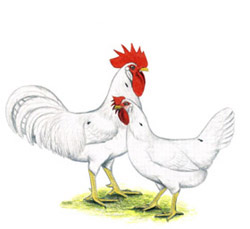
| Male Mature Weight: 4.5 |
| Female Mature Weight: 4.5 |
| Comb Type: Single |
| Egg Color: White
Egg Size: 26-27 Ounces/dozen Rate of Lay: "Excellent" |
| Type: Meat - Laying - Dual-purpose - Other |
| Setting: [Unknown] |
| Disposition/Temperament: [Unknown] |
Ideal Poultry Breeding Farms, Inc:
Ideal's best layer-- Recommended for commercial laying operations-- Excellent exterior egg quality and length of lay.
Ideal 236 is a breed cross layer developed by Ideal Poultry in the 1960's and is the most productive, efficient layer sold by Ideal. They are known for their production of large, smooth-shelled, white eggs. This breed cross has excellent hybrid vigor, and the specific combination of breeds has produced a bird with excellent livability and the ability to lay for a long period of time without molting.
The mature weight of Ideal 236 hens is 4.5 lbs. which is heavier than most commercial layers.
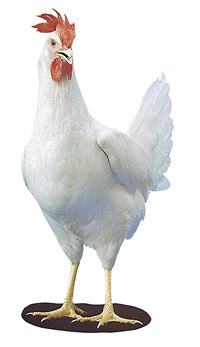
| Male Mature Weight: 6 lbs |
| Female Mature Weight: 4.5 lbs |
| Comb Type: Single |
| Egg Color: White
Egg Size: "Large" Rate of Lay: High- probably ~280+/year |
| Type: Meat - Laying- one of best - Dual-purpose - Other |
| Setting: No |
| Disposition/Temperament: Reserved, graceful, polite |
| Climate Hardiness: All Climates, not winter-hardy [1], [2] |
| Show Class: Production |
Over 45 years of scientific breeding research have gone into the development of this layer through a blending of special strains of White Leghorns. These pullets weigh about 4 lbs. at maturity, start laying at 4 1/2 to 5 months, and will continue 10 to 12 weeks longer than most good layers. Livability and resistance to disease are very high, and the feed to egg conversion ratio is excellent, holding down the cost of egg production. When our local farmers ask us to recommend the pullet that will lay the most eggs of top grade and size, of uniform shape, good shell, and highest interior quality, and do it on the least feed and in smallest amount of space, we suggest the Pearl.
Customer comments:
These chickens were the best egg laying chickens I've ever had. They're not the most social but are
very graceful and polite chickens.
- - -
THE SERVICE AND SHIPPING TIME OF MY CHICKS WAS GREAT, KEEP UP THE GOOD WORK AND THANK YOU FOR MAKING
THIS SO EASY!
- - -
Last year my husband and I ordered 50 of the Pearl White Leghorn pullets, and 3 roosters. They were
healthy upon arrival, and kept getting better. They were the most beautiful birds. They looked like
a flock of white geese out in the yard. They started laying at approximately 17 weeks of age. You
can't beat them for egg production. Thanks McMurrays for always sending quality birds!
- - -
Well North Carolina, has just recieved a shipment of the healthiest and most perky Pearl White Leghorns
in the state. I just recieved these chicks Sunday and they were all alive and chearping. Have had not
one problem with these chicks. They are beautiful! The kids love em! I HIGHLY will and am, recommending
McMurray Hatchery to my friends and anyone else looking to raise these chicks as pets or business use.
I am looking forward to the next shippment towards the end of May. MCMurray Hatchery is the place to go
for all your needs! EXCELLENT business conducted!! GREAT JOB to everyone involved with my order!
THANK YOU!
- - -
I wanted to thank you Mcmurray Hatchery for the best chicks I have ever had in my life and the arrrival
time was excellent. Your staff on the phone were so wonderful to help me out everytime I had a
question. Thank you for the best chickens and I can't wait to order another set of White Leghorns
again. If anyone asks me where they can purchase chickens I'll say Murray Mcmurray Hatchery because
their the best.
- - -
Dear McMurray Hatchery, About 6 months ago I ordered some Pearl-White Leghorn pullets. They are the
cleanest and the friendliest chickens I have ever owned. Their egg production is outstanding. They
have not missed a single day since they started laying about two months ago. Believe it or not, one
of them is sitting on a clutch of her own eggs that she layed. I can't wait to see the chicks when they
hatch. I know she will be a good mother. Thanks, From Dustin in MS
- - -
Thank you. The first time I sent for my chicks and I'm glad I used your hatchery. I was afraid with the
really bad weather this year that the chicks wouldn't make their shipment here. Not only did they come
healthy, but with the information you gave to continue their growth, I have been surprised how their
improvement has surpassed all other chicks in the past years. Thank you again.
- - -
Hi... Eight months ago I purchased ten different breeds and all are doing very well, laying regularly
and we love them all. But I have to tell you that the Pearl White Leghorn wins the show. Stunningly
bright white they stand out in the flock, but they don't win the beauty contest, my Golden Campine
takes that prize, instead, the Leghorns win their prize for their incredible egg laying record. My
thirteen year old daughter charts the laying pattern of all of our hens every day. Since the hens
started laying about three months ago, each Leghorn has laid an egg a day for fifteen to sixteen days
straight and then they rest for a day... then they start the cycle over. Incredibly, their white eggs
are always extra large to jumbo in size...and for a treat they lay double yolks every now and then.
My three Leghorns are calm, non aggressive and never make a sound except after laying an egg. Thanks to
you I may have discovered the "Perfect" chicken. Thanks for all of your help and advice to a first time
city chicken lover.Ray NicholSeattle, WA
- - -
Hi..I live out in the country and i have had laying hens for about 3 years now. I got some White
leghorns this spring and at first i hated them but as they grew i also grew to love them. They are so
regal and graceful. My two leghorns are the prettiest birds of my flock and boy can they LAY!! I get
an egg a day off of them! I thought i would hate them but now i love them!
- - -
In 3rd or 4th grade we ordered some Pearl White Leghorns. I have taken them to fair every year in 4-h
and they always get Best of Breed, Best of Show, Best egg production trio. That is a lot of awards
for just 3 chickens. Now I am in 8th grade, and they still are laying great. They are hardy in the
winter, and they are as sweet as can be. Thanks for having great quality.
- - -
We have purchased the Pearl White Leghorns for the past two years. They arrive healthy and grow
very fast. They are a delightful chicken. We have been selling their eggs, and our customers are
delighted with their very large white double yolk eggs. They lay quickly (4 months) and have continued
laying right through the winter months.
- - -
I am so happy with the Pearl White Leghorns I ordered from you last year. They truly are great layers.
Large beautiful eggs consistently. My customers love the eggs, and the birds are fun to watch. I will
continue to order from you!!
- - -
We recived our Pearl White Leghorns 16 weeks and 1 day ago, and today I'm please to say we got our 1st
egg. I'm so happy they are so beautiful and white. Very nice birds.
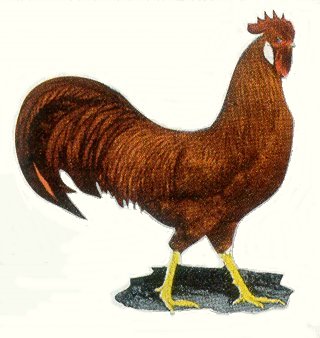
| Male Mature Weight: 6 lbs |
| Female Mature Weight: 4.5 lbs |
| Comb Type: Single |
| Egg Color: White
Egg Size: "Large" Rate of Lay: , ~3/week |
| Type: Meat - Laying - Dual-purpose - Other |
| Setting: No |
| Disposition/Temperament: Active, bears confinement well |
| Climate Hardiness: All Climates, not winter-hardy [1], [2] |
| ALBC Priority: Recovering or rarer |
| Show Class: Mediterranean |
This variety is rare and unusual. Imagine a rich, brilliant red plumage color combined with a graceful carriage, sweeping tail, white ear lobes, and yellow shanks and toes. This is another fine variety for showing. The hens lay a tinted white egg and are practically non-setters. Chicks are a reddish brown and many have darker specks and markings on the back. Try some of these handsome birds for an interesting and beautiful addition to your flock.
Customer comments:
These Leghorns are the best anyone could have hoped for! They have all the qualities that I ever
could have hoped for: gentle, hardy, good egg layers! Thank you, Murray McMurray!
- - -
I have gotten some real show winners, and the Red Leghorns are some of the most beauitful birds. They
are among my favorite since childhood.
- - -
I have been extremely impressed with the degree of quality these leghorns were. They were shipped
promptly, and were all alive and very healthy and vital when received. They held true to the standard
of the breed and have grown better then expected. I recommend this breed and hatchery to everyone.
Ideal Poultry Breeding Farms, Inc:
Red Leghorns, which are extremely rare, are a solid red, white egg layer. Their economic performance traits do not compare with those of White Leghorns that have been more highly selected. As this breed becomes more readily available, more emphasis will be placed on rate of lay and egg size which will help them gain in popularity. They are an attractive variety with long flowing tails, angular bodies and beautiful style.
Standard weights at maturity are males-6 lbs. and hens-4 1/2 lbs.
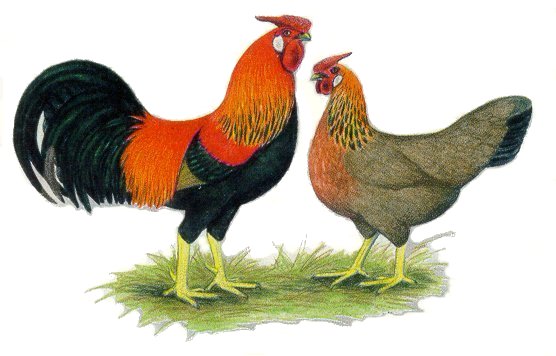
| Male Mature Weight: 6 lbs |
| Female Mature Weight: 4.5 lbs |
| Comb Type: Rose |
| Egg Color: White
Egg Size: "Large" Rate of Lay: , ~3/week |
| Type: Meat - Laying - Dual-purpose - Other |
| Setting: No |
| Disposition/Temperament: Active, bears confinement well |
| Climate Hardiness: All Climates, may be winter-hardy [1], [2] |
| ALBC Priority: Recovering |
| Show Class: Mediterranean |
These have exactly the same plumage color as the S.C. variety, but instead of the straight blade single combs they have rose combs, which are low, solid, thick, and covered with small rounded points. An advantage of the rose comb in cold climates is that it is less likely to suffer frostbite. The dark color and quick actions of both R.C. and S.C. varieties make for a good range bird where there is danger of predators. They are real hustlers, range far, and look out for themselves very well. Baby chicks are just like the S.C.'s except the tiny, flat rose combs show the difference.
Customer comments:
I ordered a few Brown Leghorns last year and they are the best layers I've seen in my whole flock.
Thanks for the great birds.
- - -
I bought these chickens a while back, and they are the best layers we have. Thank you.
Ideal Poultry Breeding Farms, Inc:
Rose Comb Brown Leghorns, which lay white eggs, are a very rare variety of Leghorns, and are bred primarily for exhibition. Males have black tails, orange-red heads, lustrous deep orange back, and saddle feathers. The female's head is lustrous deep orange, and the front of the neck and breast are a rich salmon color. The remainder of the body is a combination of black and brown shades. They are very active foragers and hustle for their feed. Their unique multicolored plumage pattern provides a good natural protection against predators. The body shape of Leghorns, characterized by the angular body and long flowing tail, is one of the most graceful of all breeds.
Standard weights at maturity are males-6 lbs. and hens-4 1/2 lbs.
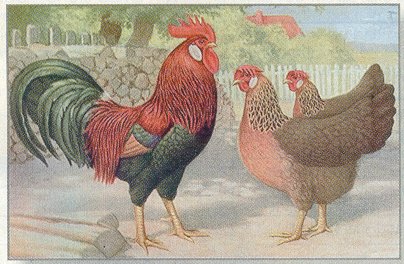
| Male Mature Weight: 6 lbs |
| Female Mature Weight: 4.5 lbs |
| Comb Type: Single |
| Egg Color: White
Egg Size: 24-25 Ounces/dozen Rate of Lay: "Very Good" |
| Type: Meat - Laying - Dual-purpose - Other |
| Setting: No |
| Disposition/Temperament: Energetic, friendly, can be flighty, bears confinement well |
| Climate Hardiness: All Climates, not winter-hardy [1], [2] |
| ALBC Priority: Recovering |
| Show Class: Mediterranean |
These are generally recognized as the most colorful of the Leghorn family and like all Leghorns lay white eggs, are nonsetters, have large combs and white ear lobes, and yellow skin, shanks and feet. Our Brown Leghorns have been improved over the years by the introduction of the world famous Danish strain. The male is very handsome with orange hackle and saddle and black stripes in center of each feather. The female is a medium brown with delicate penciling; wings are a darker brown and breast is salmon colored. The chicks are striped like little chipmunks, and are so lively when just a few hours old that we can hardly take the lid off the box without having them jump over the sides.
Customer comments:
These Leghorns have been a great addition to our flock. If your looking for a white egg layer these
chickens are a good choice. They have a good feed to egg converion and their eggs are very uniform in
shape. They have alot of energy. Scott Montgomery, Sperryville, VA
- - -
Our 4-H always orders our birds from you as a group. My friend, Colleen, ordered two Single Comb Brown
Leghorns and showed them at the fair. Her Leghorn pullet won Grand champion. We are all very pleased
with your birds and so many people have joined the poultry group that we have to make two orders to
get all the birds. Jacob from Pennsylvania
- - -
These leghorns are by far the most consistent layers of nice white eggs of all my hens. They are sleek
and beautiful, and like to hang around while I'm doing chores. I recommend!
- - -
This is the 2nd year ordering from McMurray I have some outstanding White Leghorns from last year
(best layers). This year it's the New Hamshire Reds and Brown Rose comb Leghorns. You can't go wrong
with McMurray Stock.
- - -
These chickens are my favorite out of our flock. They are very friendly but can be a little flighty
and are always full of energy. Great by for anyone who wants a great looking bird and lots of eggs.
Admitted to the American Standard of Perfection in 1874 and originations from Italy, Denmark, and England. This breed is very athletic, hardy, non-sitters and lay very nice large white eggs. Pullets weigh approx. 4 lbs and cockerels 5 lbs.
Hen -------4 1/2 lbs
Rooster----6 lbs
Pullet------4 lbs
Cockerel---5 lbs
Ideal Poultry Breeding Farms, Inc:
Very colorful, hardy white egg breed that will hustle and has color protection against varmints.
Single Comb Brown Leghorns, which lay white eggs, are the second best known variety of Leghorns. They originated in Italy, and are the most colorful of all breeds. Males have black tails, orange-red heads, lustrous deep orange back, and saddle feathers. The female's head is lustrous deep orange, and the front of the neck and breast are a rich salmon color. The remainder of the body is a combination of black and brown shades.
Standard weights at maturity are males-6 lbs. and hens-4 1/2 lbs.
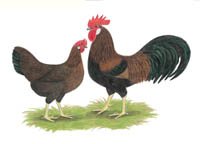
|
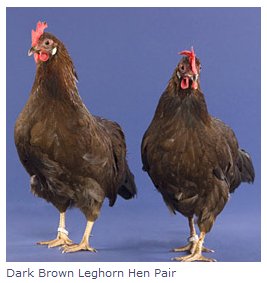 My Pet Chicken |
| Male Mature Weight: 6 lbs |
| Female Mature Weight: 4.5 lbs |
| Comb Type: Single |
| Egg Color: White
Egg Size: "Large" Rate of Lay: , ~3/week |
| Type: Meat - Laying - Dual-purpose - Other |
| Setting: No |
| Disposition/Temperament: Active, bears confinement well |
| Climate Hardiness: All Climates, not winter-hardy [1], [2] |
| ALBC Priority: Recovering |
| Show Class: Mediterranean |
Ideal Poultry Breeding Farms, Inc:
Single Comb Dark Brown Leghorns present a magnificent picture with their beautiful, flowing, dark red plumage, bright red combs and enamel white ear lobes. They are kept primarily for exhibition and for their unique beauty. Leghorns, which originated in Italy prior to 1815, are probably the best known of all breeds of chickens. They are characterized by great activity, hardiness and proficiency in the economic production of white-shelled eggs.
Standard weights at maturity are males-6 lbs. and hens-4 1/2 lbs.
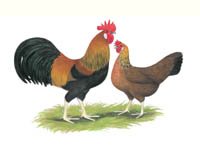
|
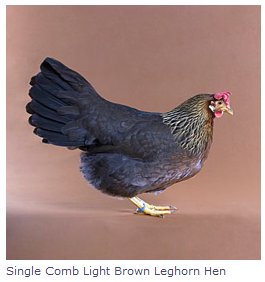 My Pet Chicken |
| Male Mature Weight: 6 lbs |
| Female Mature Weight: 4.5 lbs |
| Comb Type: Single |
| Egg Color: White
Egg Size: "Large" Rate of Lay: , ~3/week |
| Type: Meat - Laying - Dual-purpose - Other |
| Setting: No |
| Disposition/Temperament: Active, bears confinement well |
| Climate Hardiness: All Climates, not winter-hardy [1], [2] |
| ALBC Priority: Recovering |
| Show Class: Mediterranean |
Ideal Poultry Breeding Farms, Inc:
Single Comb Light Brown Leghorns are a sight to behold with their flowing multicolored plumage. Many times the characteristics of this variety are those used in paintings or advertisements displaying chickens. They are characterized by great activity, hardiness and proficiency in the economic production of white-shelled eggs. The females are non-sitters and rarely go broody.
Standard weights at maturity are males-6 lbs. and hens-4 1/2 lbs.
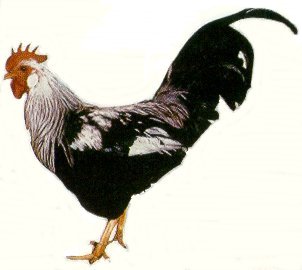
| Male Mature Weight: 6 lbs |
| Female Mature Weight: 4 lbs |
| Comb Type: Single |
| Egg Color: White
Egg Size: "Large" Rate of Lay: , ~3/week |
| Type: Meat - Laying - Dual-purpose - Other |
| Setting: No |
| Disposition/Temperament: Quick and Alert, bears confinement well |
| Climate Hardiness: All Climates, not winter-hardy [1], [2] |
| ALBC Priority: Recovering |
| Show Class: Mediterranean |
This rare and beautiful variety has especially handsome plumage. The males are a combination of silvery white and lustrous greenish black. The females are quite different with silvery gray neck, back and wings, and beautiful salmon shading in the breast. They are good layers of white eggs and very vigorous, quick, and alert. Our strain is very carefully selected for correct color and type, which makes them outstanding exhibition birds. If you are looking for something a little different, with good chance of winning in the poultry shows, try some Silver Leghorns. They are most unusual and attractive. Baby chicks are striped like Brown Leghorns, but stripes are a lighter brown and base color more of a grayish cast.
Customer comments:
I ordered 2 Silver Leghorn Males and the Brown Egg Layer Special. They are the prettiest little birds you'll
ever see. Although they were smaller than the other chicks they wern't intimidated. They are great. Thanks
for your help McMurray Hatchery.
- - -
I have 3 Silver Leghorn Cockerels and a Golden Campine Cockerel. They are a gorgeous bird with their lustrous
silver and white. I also have 26 mixed breeds of pullets and their getting along fine. ... Thanks Trey
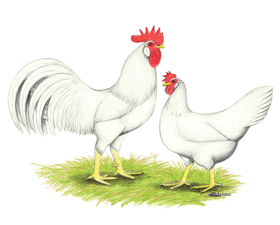
| Male Mature Weight: 4.5 |
| Female Mature Weight: 4.5 |
| Comb Type: Single |
| Egg Color: White
Egg Size: 25-26 Ounces/dozen Rate of Lay: "Excellent", ~4/week |
| Type: Meat - Laying - Dual-purpose - Other |
| Setting: No |
| Disposition/Temperament: Active, bears confinement well |
| Climate Hardiness: All Climates, not winter-hardy [1], [2] |
| ALBC Priority: Recovering |
| Show Class: Mediterranean |
Admitted to the American Standard of Perfection in 1874 and originations from Italy, Denmark, and England. This breed is very athletic, hardy, non-sitters and lay very nice large white eggs. The White Leghorn is a prolific layer of white eggs. They produce more eggs on less feed than most chickens.
Hen -------4 1/2 lbs
Rooster----6 lbs
Pullet------4 lbs
Cockerel---5 lbs
Ideal Poultry Breeding Farms, Inc:
Excellent layer-- Ideal 236 may bey subsituted if 'White Only' is not specified.
Single Comb White Leghorns are the most popular of all Leghorns and the best known of all white egg varieties. Crosses involving this variety are the basis for most commercial white egg layer crosses. Ideal recommends the Ideal 236 for individuals wishing to purchase birds for efficient production of white eggs. Ideal reserves the right to substitute the Ideal 236 unless White Only White Leghorns are ordered.
The mature weight of this cross is 4.5 lbs. which is heavier than most commercial white egg layers.
White Only White Leghorns:Single Comb White Only White Leghorns variety must be specified if the chicks are to be used for reproduction of Single Comb White Leghorns; otherwise, some black spot chicks may be included. Of the purebreds, Single Comb White Leghorns lay the largest white eggs, lay at the highest rate and are the most efficient. Crosses involving this variety are the basis for most commercial white egg layers. A Single Comb White Leghorn cross is used as the female parent for the production of Ideal 236 chicks, which we recommend as Ideal's best, most efficient white egg producer.
White Leghorns are one of the most popular commercial breeds of chicken in the world and the most common breed used for commercial egg production in the United States. This is due to the excellent feed to egg conversion ratio. The White Leghorn is a high yielding egg producer at around 300 eggs per year. Typically leghorns have single combs and can be recognized in several color varieties.
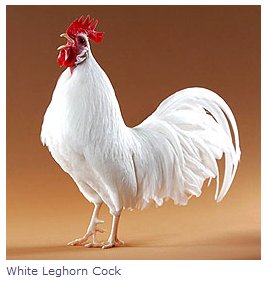 My Pet Chicken |
My Pet Chicken: [NAH]
Remember Foghorn Leghorn the cartoon? Yep, this bird is one and the same. (Seasoned pros know that Leghorn is pronounced "Leggern".) The White is separate from the rest because they lay large, white eggs practically every day! Other varieties aren't nearly so prolific. Whites are said to be nervous, but ours have been the sweetest, most tame of all our chickens! So give one a try and find out for yourself. (In winter, use petroleum jelly on the comb to prevent frostbite.)
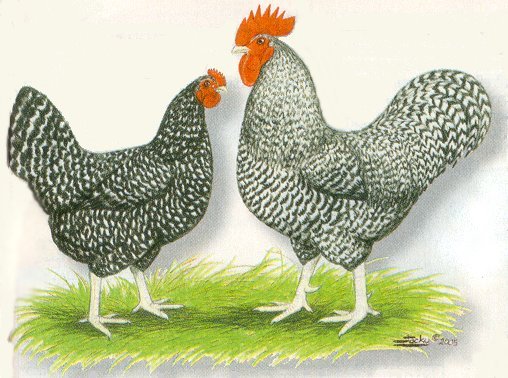
| Male Mature Weight: 7-8 lbs |
| Female Mature Weight: 6 lbs |
| Comb Type: Single |
| Egg Color: Dark Brown
Egg Size: "Large" Rate of Lay: 150/year |
| Type: Meat - Laying - Dual-purpose - Other |
| Setting: "Average" |
| Disposition/Temperament: Friendly, gentle |
| Climate Hardiness: Cool but not frost-hardy [1], [2] |
This breed was developed in France in the mid 1800's in the town for which it bears its name, Marans. They had made their way to England in the early 1900's and quickly became very popular for their very dark (chocolate) brown eggs - a trait they are still known for today. These beautiful birds were first exhibited in 1929 in Paris by the Poultry Breeders Society of France and since then have gradually made themselves popular in various countries around the world. We carry the CUCKOO variety of Maran which resembles the Barred Rock in color by displaying feathers which are all crossed throughout with irregular dark and light slate colored bars. Maran's lay the darkest eggs of any breed we carry and are a nice dual purpose bird for both eggs and meat.
Customer comments:
Cuckoo Marans are very gentle and interesting chickens. I highly recommend them!
- - -
Me and my mom love ordering from ya'll and I included a few Marans in the last order. I was expecting the
eggs to be a chocolate color, which they were not. The eggs are large and sometimes speckled with brown,
but not the dark chocolate that I was hoping for. The Marans are very gentle, large beautiful chickens,
though and we are very pleased with them and the Buff Orpintons.
- - -
Wish I had ordered more Cuckoo Marans...the hens are the friendliest of the 9 breeds I've raised, and were
consistent layers of large brown eggs even in the cold weather.
- - -
I received a male and a female Cuckoo Maran. The male is very beautiful and the female was our first hen
to lay an egg out of all our 50 chickens.
The Marans was developed in France in the town of Marans during the mid 1800's. It is a dual purpose bird and is know for it's deep chocolate brown eggs. They are a fast growing bird and a very rare breed here in the United States.
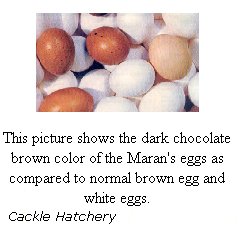 Hen-----------10 lbs
Hen-----------10 lbs
Rooster-------13 lbs
Pullet--------- 6 lbs
Cockerel----- 7 lbs
Ideal Poultry Breeding Farms, Inc:
Cuckoo Marans are uniquely bred for the production of extremely dark brown eggs. No breed produces eggs that are darker than those produced by Marans. All feathers of Cuckoo Marans are crossed throughout with irregular dark and light slate bars. They appear to look much like Barred Plymouth Rocks but the bars are not nearly as perfect and the difference between the black and white bars is not as distinct. Because of these differences, the variety is known as cuckoo rather than barred.
Standard weights at maturity are male-7 to 8 lbs. and hen-6 lbs.
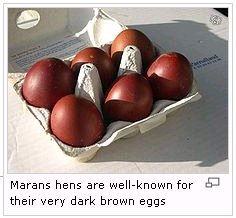 Wikipedia |
Cuckoo Marans were developed in Marans, France during the mid 1800’s. Although they are considered a very rare breed, they are extremely popular in the United States because of the beautiful dark brown eggs they lay. Cuckoo Marans look very similar to the Barred Plymouth Rock, with the exception of some subtle differences in the feather pattern.
Comb: Single.
Standard weight at maturity: Hens 6 lbs, males 7 ½ lbs.
Egg color: Dark Brown
Wikipedia: [NAH]
The Marans is a breed of chicken originating in France. It is a medium breed compared to others, popular for poultry shows and is a dual purpose fowl known both for its extremely dark eggs as well as for its very fine meat qualities.
There are 9 recognized colors in the French Standard: Cuckoo, Golden Cuckoo, Black, Birchen, Black Copper, Wheaton, Black-tailed Buff, White and Columbian; other colours not officially recognized (such as Blue Copper) also exist. Black Copper (black with copper feathers on the neck) and Cuckoo (barred feathers, giving a black and white speckled appearance) are the most common of these...
All have red or orange eyes and white feet. They are in the medium weight class, generally rather smaller than the more common Rhode Island Red.
The original Marans have feathered legs but this has been bred out by many UK breeders...
Marans are generally quiet and docile; but they are quite active, taking well to free ranging in rough terrain and are also tough and disease-resistant. They were originally bred in the marshy areas of France and can cope with damper conditions.
Marans lay around 150 dark brown eggs each year. Marans are an historically dual-purpose bird, prized not only for their dark eggs but for their table qualities as well.
Backyard Chickens.com: [NAH]
...Marans (there is always an "s" on the end - even if you are speaking of an individual bird) were developed in France and are known for their famous chocolate brown egg. ...Egg color typically will be the darkest at the beginning of the laying cycle, and will then lighten up through the cycle. It is thought that dark egg color is passed down by the rooster...
The Minorca is a breed of chicken originating in Spain. They are classified in the Mediterranean class by the American Poultry Association. They lay white eggs. Color varieties include buff, black, white with the British recognizing a blue phase. Minorcas mature quickly and begin crowing sooner than other breeds. It is closely related to White-faced Black Spanish and Castilian Black. Minorcas tend to be very flighty...
The Minorca is the largest of the Mediterranean class of fowl in roosters weighing 9 pounds and hens 7½ pounds. They are utility fowl and were once in the class of widespread large flocks for laying and meat production like the Leghorn breed which is the smallest of this class.
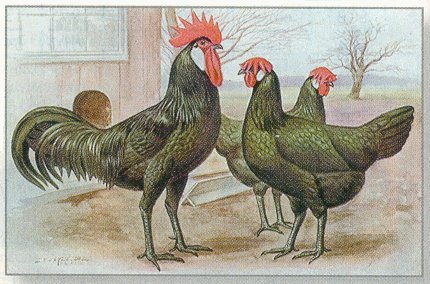
| Male Mature Weight: 9 lbs |
| Female Mature Weight: 7.5 lbs |
| Comb Type: Single |
| Egg Color: White
Egg Size: 24-25 Ounces/dozen Rate of Lay: "Very Good", up to 4/week |
| Type: Meat - Laying - Dual-purpose - Other |
| Setting: No |
| Disposition/Temperament: "very flighty", but tolerates confinement |
| Climate Hardiness: Heat, not winter-hardy [1], [2] |
| ALBC Priority: Watch |
| Show Class: Mediterranean |
This has always been one of our favorite varieties because it was about the first one raised by Dad. In 1917, the first time he made an exhibit at the Iowa State Fair, he won a blue ribbon on his prize Black Minorca cockerel, and it gave him a thrill he never got over. The Minorcas are the largest of the Mediterranean Class and the Blacks are perhaps the finest examples of their class. They lay large white eggs, are non-setters.
Customer comments:
These are some really beautiful birds! Not only attractive but lots of large white eggs.
I have been ordering chicks from you guys for over 15 yrs and can say I am one SATISFIED
customer. Trust me, McMurray is #1 in customer service and satisfaction!!! Jason Haynes
-Oxford, AL
Ideal Poultry Breeding Farms, Inc:
Beautiful pure black bird with white skin.
Black Minorcas, which have a stately carriage and are characterized by having long angular bodies with long tails, are the most popular variety of Minorcas. They are the largest of the Mediterranean breeds, but may appear to be heavier than they are. They may have some white plumage until they molt their juvenile feathers, but when mature will be solid black. They are active, alert, good hustlers, and are good layers of chalk white eggs. They are classified as non-sitters.
Standard weights at maturity are males-9 lbs. and hens-7 1/2 lbs.
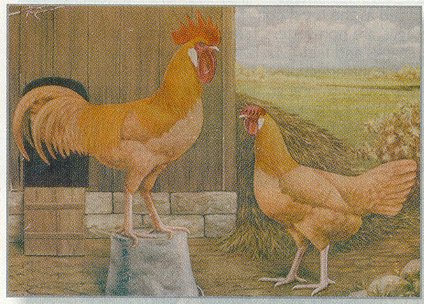
| Male Mature Weight: 9 lbs |
| Female Mature Weight: 7.5 lbs |
| Comb Type: Single |
| Egg Color: White
Egg Size: 24-25 Ounces/dozen Rate of Lay: "Very Good", up to 4/week |
| Type: Meat - Laying - Dual-purpose - Other |
| Setting: No |
| Disposition/Temperament: "very flighty", but tolerates confinement |
| Climate Hardiness: Heat, not winter-hardy [1], [2] |
| ALBC Priority: Watch |
| Show Class: Mediterranean |
Like all of the Minorcas these have long, strong bodies well set up on firm muscular legs. The large red combs are very typical and in the hens will fall to one side almost covering one eye. The hens lay good sized white eggs and are nonsetters. Plumage is a rich golden buff color and shanks and toes are a pinkish white.
Customer comments:
Dear Folks, I purchased 12 of these Golden beauties back in June of this year. As of 2 weeks ago
the eggs are really starting to pile in, chalk white and quite tasty. The hens are becoming quite
the attraction to the roosters and the roosters are strutting around very proud and announcing their
voice to the world. They have far surpassed my expectations for both a living science project for my
son and a nice little source of eggs for everyone to enjoy. Keep this breed alive and active.
Best Regards, David
Ideal Poultry Breeding Farms, Inc:
Beautiful bird with white skin. The shanks and toes are pinkish white.
Buff Minorcas are the second most popular variety of Minorcas, which originated on the Island of Minorca in the Mediterranean Sea off the coast of Spain. They are stately and characteristically have long angular bodies with long tails. They are very good layers of chalk white eggs. They are classified as non-sitters and are good hustlers, active and alert.
Minorcas are the largest of the Mediterranean breeds with adult hens weighing in excess of 4 1/2 lbs.
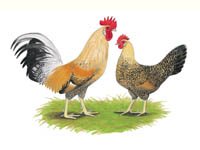
| Male Mature Weight: 4.5 lbs |
| Female Mature Weight: 4 lbs |
| Comb Type: Single |
| Egg Color: White
Egg Size: "Large" Rate of Lay: "Lots", enough to "wear the hen out" |
| Type: Meat - Laying - Dual-purpose - Other |
| Setting: No |
| Disposition/Temperament: Active |
| Climate Hardiness: [Probably Cold- bred in Norway!] |
Ideal Poultry Breeding Farms, Inc:
Norwegian Jaerhons originated in Norway with the support of the national government. As the breed developed, little attention was paid to external breed characteristics. As a result, and because a Standard description is yet to be specified, the true adult description is somewhat difficult to determine. They have the basic Leghorn body confirmation with barred plumage, which is infused with gold marking. They have yellow skin and lay white-shelled eggs.
Standard weights at maturity are males-4 1/2 lbs. and hens-4 lbs.
Wikipedia: [NAH]
The Norwegian Jærhøne or Jaerhon, is a breed of chicken from Norway. It was developed in the 1920s from native stock around the town of Stavanger on the southern Atlantic coast of Norway. The breed was first imported to North America in 1998 by Dr Bjorn Netland in Washington state. Jaerhons are small, hardy, and active birds that can fly well. Hens don't tend to go broody, and can wear themselves out by laying lots of large white eggs. The standard cock is 5 pounds, and the hen can weigh 3.5 pounds. There are two standard varieties: dark and light (brown-yellow and yellow-brown), and the color patterns are unique for this breed.
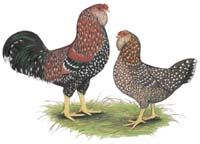
| Male Mature Weight: 7 lbs |
| Female Mature Weight: 5 lbs |
| Comb Type: Walnut |
| Egg Color: Brown or Light brown
Egg Size: "Medium" Rate of Lay: "Medium" |
| Type: Meat - Laying - Dual-purpose - Other |
| Setting: No |
| Disposition/Temperament: Calm |
| Climate Hardiness: All Climates - Extreme Cold [1] |
| ALBC Priority: Critical |
Ideal Poultry Breeding Farms, Inc:
Spangle Russian Orloffs, which have muffs and beards, have an upright carriage with a slightly sloping back. Their eyes are deeply set under well projected eyebrows, giving a gloomy, vindictive look. The very attractive and unique plumage of the male is multicolored varying from orange to black with some of the feathers tipped with white spangles. The female's plumage is light mahogany with some white spangles. Orloffs, which originated in Russia, are extremely rare brown egg layers.
Standard weights at maturity are males-7 lbs. and hens-5 lbs.
Wikipedia: [NAH]
The Orloff is a breed of chicken who is named after Alexey Grigoryevich Orlov, a Russian Count. Reflecting this moniker, it is sometimes called the Russian Orloff or simply Russian. For most of its history, the Orloff was considered to be a product of Russia and Orlov, but modern research has discovered that the breed first appeared in Persia, and was distributed across Europe and Asia by the 17th century. However, Count Orloff, who carried the honorific Chemensky (sometimes transliterated as Techemensky), was a key promoter of the breed in the 19th century, and the breed became known in the West following his efforts... In the 21st century, the Orloff remains a rare breed in the West. The American Livestock Breeds Conservancy lists the breed as critically endangered. The Orloff is a tall, well-feathered chicken with a somewhat game-like appearance. The head and neck are very thickly feathered. They appear in several recognized color varieties: Black, White, Spangled, Black-tailed Red, Mahogany, and Cuckoo. Their plumage, combined with their tiny walnut comb, small earlobes and minuscule wattles, makes the Orloff a very cold hardy breed. Males generally weigh 3.6 kilos (8 pounds), and hens weigh 3 kilos (6.5 pounds). Orloffs are primarily suited to meat production, but hens are reasonable layers of light brown eggs and do not usually go broody. In general temperament, they are known to be relatively calm birds.
See also: Backyard Chickens.com: Russian Orloff [NAH]
The Orpington is a breed of chicken named after Orpington, England, which was made famous in part by this breed. Belonging to the English class of chickens, it was bred to be an excellent layer with good meat quality. Their large size and soft appearance together with their rich color and gentle contours make them very attractive, and as such its popularity has grown as a show bird rather than a utility breed. They go broody very often, and make great mothers. Being rather heavy, they are unable to fly, so they work well as backyard birds. Due to their build they do well in very cold climates. The fluff of their feathers allows rain water to penetrate, so they must be kept out of the rain...
In the beginning of the twentieth Century Herman Kuhn of Germany developed a Bantam variety. The Bantam retains the large appearance, but in a smaller size... The Bantam retains the friendly personality of the Standard breed, and seldom or never flies, so it too makes for a good backyard breed...
Orpingtons lay about 200 medium to large light-brown eggs a year. They do not stop laying in the winter.
It was said to at one time lay as many as 340 eggs per year. This decline in production was due to breeders selecting for looks over utility.
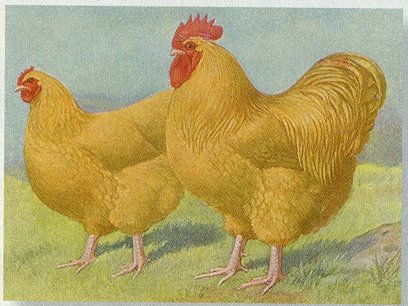
| Male Mature Weight: 10 lbs |
| Female Mature Weight: 8 lbs |
| Comb Type: Single |
| Egg Color: Brown
Egg Size: 25-26 Ounces/dozen Rate of Lay: "Good" ~200/year |
| Type: Meat - Laying - Dual-purpose - Other |
| Setting: Yes, very broody, excellent mothers, and will even adopt other species |
| Disposition/Temperament: Calm, friendly, curious, vivacious chicks; bears confinement well |
| Climate Hardiness: All Climates, Winter-hardy [1], [2] |
| ALBC Priority: Recovering |
| Show Class: English |
One time years ago at our Hamilton County Fair the poultry judge was asked to describe the correct plumage color for this variety. Taking out his gold watch he said, "That's the color for Buff Orpingtons." And pure gold they are, symbolic of great value and high quality. Introduced from England in the late 1800's, they became one of the most popular farm fowls in this country. These are large, stately birds of quiet disposition. Easy to dress for the table they are white skinned, plump, and juicy, a beautiful eating bird. Their heavy, full plumage make them excellent winter layers, shelling out brown eggs right through cold weather. They also make excellent setters and mothers. These "Golden Beauties" have been one of our most popular varieties for years and years with their glistening plumage and pinkish white skin. Baby chicks are a soft light buff color.
Customer Comments:
Buff Orpingtons are nice, large, impressive birds, good for eating but also very nice to look at!
- - -
I have several different breeds of chickens, and of all the of them, the Buff Orpingtons are my
Favorite! They are great layers, wonderful eating birds, and beautiful to look at! Not to mention
sweet and curios!
- - -
I have purchased numerous breeds of chickens from you and of all of the nearly twenty breeds I have ever
raised the Buff Orpingtons are by far the best. They are beautiful and gentle. I would recomend these
birds to anyone who wishes to raise chickens.
- - -
I ordered some Buff Orpingtons last spring they are huge and very gentle. People are amazed how tame
and beutiful they are when I have visitors. They are 4 months old now I can't wait until they start
laying eggs.
- - -
We were very impressed with our chicks from your hatchery, I want to recommend Buff Orphingtons as great
pets, much sweeter and nicer than cats!, wonderful childrens pets and companions..as they have very sweet
gentle temperament.
- - -
I am absolutely smitten with the Buff Orpingtons we got last June! They are social, gentle, prolific
layers, and breath-takingly beautiful to top it all off. We get an egg just about every day from each
hen, and sometimes a double-yolker! My hens are queens in our yard, and they know it.
- - -
Just got some chickens a couple days ago, and the Buff Orpingtons are great! They're the most curious and
friendliest out of the 5 different breeds we got!! Thanks!
- - -
I love these chicks! I have three different breeds of chicks, and the buff orpingtons are my favorite.
They're all very healthy and beautiful.
- - -
I love my Buff Orpingtons! They are the sweetest chicks I have. Thanks!
- - -
What a great bird! I had received 25 chicks a few weeks ago, 5 of which were Buffs. I truly wish I
would have gotten all 25 as Buffs. They are the nicest and most pleasurable bird I have ever been around.
They are growing at an incredible rate, with an attitude almost to please. I can see many more in my future...
I believe I have found the "perfect bird". Thanks so much for the recomendation. Regards, John J PA
- - -
I ordered 25 buff orpingtons in February of 2004. They are great layers even in cold weather. Very
friendly birds. I have since added other breeds to them and they got along very quickly and easily. I am
very pleased with them. Thanks so much McMurray.
- - -
I had one of these littles cuties in my order, wish I had gotten more. Already as a chick it is so much
more friendly than the others. I am looking forward to seeing what she is like when she is full grown...
- - -
We recieved our chicks this morning, all of them were just rearing at the bit to get out of the box. Out
of the 6 different breeds we got, the buffs were by far the most energetic, almost super-charged!...
- - -
We bought this bird and was very satisfied.They are very good layers even through the winter. They are mild
tempered and are very beautiful! THANKS!
- - -
We ordered many different types of chicks back in April. They all arrived happy and healthy. Out of all of
them, I think my favorite is the Buff Orpington. "Aunt Bea" is by far the sweetest and most friendly of all
of the chicks. She's very pretty too! I can't wait to see the eggs she will lay! Thanks for the wonderful chicks!
- - -
Out of the 28 chickens we got in May, the Buff Orpington pullet that we ordered is the favorite of our
children. She is so calm and friendly- will jump up on you if given a chance and sit there and preen herself,
happy as can be. The kids honestly fight over who gets to hold her. I wish I had ordered more than one- next
time around...
- - -
I bought 25 chicks last spring, 22 of which were Buff Orpingtons and they are wonderful birds. We got a lot
of good meat out of them. I kept a rooster and some hens and I am very pleased with their egg laying. I am
getting an egg a day from each hen. They are very docile and sweet. I just love the rooster, he is a real
doll! This was my first year of raising chickens and I was very pleased with what I got...
- - -
These Buff Orpingtons are incredible setters! We even had one hatch a goose egg and raised the gosling too!
- - -
When my family first decided to get a home flock of chickens, our primary concern was that they did not
bother the neighbors. McMurray Buff Orpingtons have proven to be quiet, docile, and non-fliers. They have done
well for my kids in 4-H as well. I recommend them for anyone wanting hardy brown egg layers that won't
bother even the closest neighbors.
- - -
I have 11 buff Orphingtons and they are my favorite breed of all! They are so friendly! They always follow me
around the coop I will always have this breed!
Originated in England, and recognized as a distinct breed in 1901. These "Golden Beauties" are large, stately birds of quiet disposition. Easy to dress for the table they are white skinned, plump, and juicy, a beautiful eating bird. They are a good brown egg layer and also excellent setters and mothers.
Hen -------8 lbs
Rooster----10 lbs
Pullet------7 lbs
Cockerel--8 1/2 lbs
Ideal Poultry Breeding Farms, Inc:
These large, quiet-dispositioned, loosely feathered birds have been a back-yard flock favorite for many years.
Buff Orpingtons, which have rich golden buff plumage are a popular brown egg dual-purpose variety and are sometimes called "Big Buffs". Because they are loosely feathered, they appear to be much heavier than their true weights. The feathers are broad and smooth fitting on the deep body of this breed. They have a quiet disposition, make excellent mothers and are one of the most broody of all standard breeds. They have white skin, which is an appearance disadvantage when fowl meat is produced.
Standard weights at maturity are males-10 lbs. and hens-8 lbs.
Buff orpingtons have a beautiful golden plumage that is thick and full, making this already heavy breed appear much larger than they actually are. Their size and plumage allow them to be consistently good egg layers even in the winter months. Many people raise these birds because of their calm disposition that makes them easy to handle and less agrressive around children.
Comb: Single
Standard weight at maturity: Hens 8 lbs. Males: 10 lbs.
Egg color: Brown
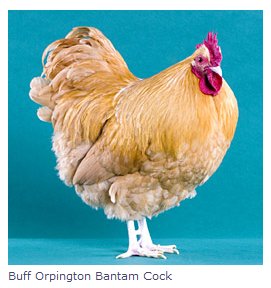 My Pet Chicken |
| Male Mature Weight: 36 oz |
| Female Mature Weight: 34 oz |
| Comb Type: Single |
| Egg Color: Brown
Egg Size: [Small] Rate of Lay: [~200/year] |
| Type: Meat - Laying - Dual-purpose - Other |
| Setting: Yes |
| Disposition/Temperament: Friendly, bears confinement well |
| Climate Hardiness: All Climates, Winter-hardy [1], [2] |
A miniature size of the Buff Orpington Standard chicken and admitted to the American Poultry Standard of Perfection in 1960. This poultry variety of the Orpington breed makes for a good backyard chicken and egg production.
Hen .................36 oz.
Rooster ..........40 oz.
Pullet ..............32 oz.
Cockerels ......36 oz.
Ideal Poultry Breeding Farms, Inc:
Buff Orpington Bantams originated in England and Germany and are relatively common in the United States. All of the plumage is an even shade of intense, golden buff, free from shaftiness, mealiness, cloudiness or mottled appearance. The female's head, neck, hackle, back, saddle, sickle and wing bow plumage is richly glossed. They have a tendency to go broody, and therefore make excellent setters.
Standard weights at maturity are male-36 oz, and hen-34 oz.
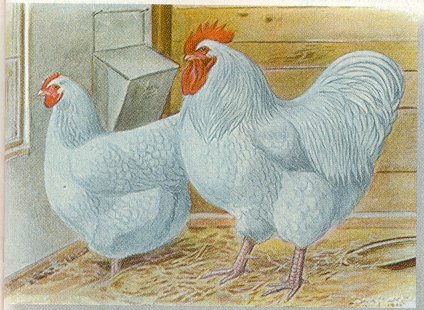
| Male Mature Weight: 10 lbs |
| Female Mature Weight: 8 lbs |
| Comb Type: Single |
| Egg Color: Brown
Egg Size: "medium to large" Rate of Lay: ~200/year |
| Type: Meat - Laying - Dual-purpose - Other |
| Setting: These hens will set. |
| Disposition/Temperament: Friendly, bears confinement well |
| Climate Hardiness: All Climates, Winter-hardy [1], [2] |
| ALBC Priority: Recovering |
| Show Class: English |
These are large, quiet, and gentle, a beautiful, pure white variety. They are large framed birds with pinkish white skin and very easy to dress; good winter brown egg layers and also will set. For those of you who like the characteristics of the Orpingtons but want a white chicken these are the answer.
Customer Comments:
I ordered some of these White Orpington chicks last spring, and they are absolutely gorgeous!! They are very large healthy birds. With a wonderful temperment. Ours come right up, and eat out of your hand. If you like huge white chickens, that lay large brown eggs. You should try some of these!
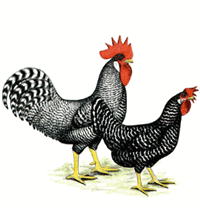
| Male Mature Weight: 4.5 |
| Female Mature Weight: 4.5 |
| Comb Type: Single |
| Egg Color: White
Egg Size: 26-27 Ounces/dozen Rate of Lay: "Excellent" |
| Type: Meat - Laying - Dual-purpose - Other |
| Setting: [Unknown] |
| Disposition/Temperament: [Unknown] |
Ideal Poultry Breeding Farms, Inc:
Colored bird producing excellent-quality large white eggs.
Production Blacks were developed by Ideal Poultry in the early 1960's. They are a combination of several breeds but are basically a black, silver barred plumage bird, which has a plumage color pattern similar to Barred Plymouth Rocks. This breed is the most efficient white egg producer of the breeds and varieties that are not primarily white. They breed true; however, they have not been recognized as a pure breed by the American Standard of Perfection.
Their mature weight is 4 1/2 lbs.
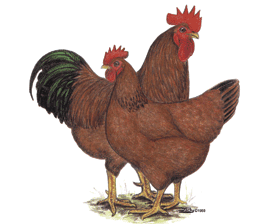
| Male Mature Weight: 5 lbs |
| Female Mature Weight: 5 lbs |
| Comb Type: Single |
| Egg Color: Brown
Egg Size: 26-27 Ounces/dozen Rate of Lay: "Excellent" |
| Type: Meat - Laying - Dual-purpose - Other |
| Setting: "Average" |
| Disposition/Temperament: Can be aggressive; not recommended for children |
| Climate Hardiness: Heat [1] |
The Production is very similar to a Rhode Island Red only lighter in color. The plumage color can vary from a red-dark red to a light red. They are a vigorous, hearty chicken that lays lots of brown eggs.
Hen -------7 lbs
Rooster----9 lbs
Pullet------6 lbs
Cockerel---8 lbs
"Cherry Egger" (Separate breed, from Cackle Hatchery):
Cherry Eggers lay big brown eggs and are a good winter layer. A production bred breed produced for egg production and health.
Hen -------6 1/2 lbs
Rooster----8 1/2 lbs
Pullet------5 1/2 lbs
Cockerel--7 1/2 lbs
Ideal Poultry Breeding Farms, Inc:
Ideal's highest producing, most efficient brown-egg layer that was originally developed from Rhode Island Red x New Hampshire crosses.
Production Reds are a brown egg layer that was developed for efficient production of large brown eggs. Crosses utilizing Rhode Island Reds and New Hampshire Reds were used in the development of this breed, which is Ideal's most efficient producer of large brown eggs. Since they have brittle feathers and because their body size is relatively small for the size eggs that they produce, they are more susceptible to cannibalism and are not recommended for high-density wire laying facilities.
Production Reds were made from a cross utilizing Rhode Island Reds and New Hampshire Reds. The are considered one of the most efficient producers of large brown eggs. They look very similar to the Rhode Island Reds, but are generally lighter in color. An excellent choice for farms. However they can be aggressive, so they are not recomended for children.
Comb:Single
Standard weight at maturity:Hens 5 1/2.
Egg color:Brown
Backyard Chickens.com: [NAH]
"Developed by cross breeding a Rhode Island Red and a New hampshire Red. They were also at one time bred with white leghorn in them. They are a dual purpose breed and mostly used for their excellent egg production, 300+. In the 1950s the Production Reds just about put the purebred Rhode Island Red into extinction.
"Their feathers can be brittle and don't do well in extremly cold temps. They can be aggressive but mine are very sweet. Some say they do not do well in cage confinement.I have mine in a run with other hens and they do very well. They lay a brown egg starting around 4-6 months. If you want alot of eggs, production reds are the chicken for you! I am not sure how broody they get since mine are young. The RIR seldom goes broody and the NR is an excellent mother so I would guess you have a 50/50 chance on getting a good mother, lol. Some hatcheries also call them red star's. Production reds can be used to make red and black sex links. Almost every RIR bought at a feed store is usually a production red or red sex link. I learned this by finally purchasing a RIR from a breeder. Their colors are very different. Hens weigh 5.5lbs and males 6.5lbs" - Sillystunt
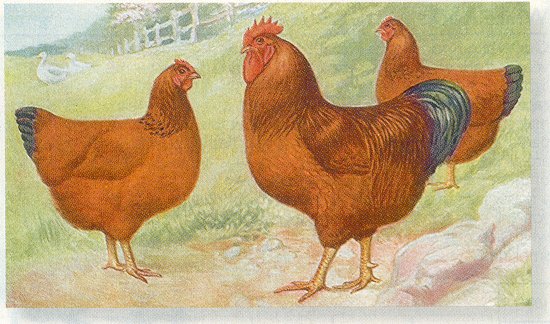
| Male Mature Weight: 8.5 lbs |
| Female Mature Weight: 6.5 lbs |
| Comb Type: Single |
| Egg Color: Brown
Egg Size: 25-26 Ounces/dozen Rate of Lay: "Very Good", ~3/week |
| Type: Meat - Laying - Dual-purpose - Other |
| Setting: Yes |
| Disposition/Temperament: Friendly to humans, may be competitive and aggressive to other chickens Bears confinement well |
| Climate Hardiness: All Climates, Winter-hardy [1], [2] |
| ALBC Priority: Watch |
| Show Class: American |
This breed originated in the state of New Hampshire at the hands of poultry farmers who started with R.I. Reds and by means of generation after generation of selective breeding intensified the characteristics of early maturity, rapid full feathering, and production of large brown eggs. We used to improve our flocks with males from a New Hampshire breeder who described his birds as being especially endowed with "spizzerinktum"; and they were unusually handsome and vigorous. The mature birds are a rich chestnut red, of a somewhat lighter and more even shade than the R.I. Reds and the baby chicks are also a lighter red.
Customer Comments:
The New Hampshires that I ordered are fantastic! They are the biggest birds in the coop
and are laying like I can't believe. They showed great also. Thanks!
- - -
The New Hampshires I ordered are an excellent Bird. They are laying eggs like no other
chicken I have ever had. If you want a good egg layer and a friendly people person
chicken choose the New Hampshire. Thanks, Bob
Developed in 1915 from a strain of Rhode Island Red brought into New Hampshire state. Recognized as a distinct breed in 1935.
Our New Hampshire Red originated from the "Newcomer" strain which was an egg laying strain and has been improved upon yearly on our own breeding farm. If you wish for a bird that matures early, lays good, and is of heavy weight, then Hampshire is what you're looking for.
Hen -------6 1/2 lbs
Rooster----8 1/2 lbs
Pullet-------5 1/2 lbs
Cockerel---7 1/2 lbs
Ideal Poultry Breeding Farms, Inc:
A very popular dual-purpose breed that grows fast, feathers quickly and produces large brown eggs.
New Hampshire Reds were developed in the state of New Hampshire through a gradual process of selection, which began around 1915 with Rhode Island Reds as the foundation stock. At one time this breed was the leading breed used for the production of brown eggs and broiler meat. They are one of the fastest growing dual-purpose breeds and they feather very rapidly. Of the dual-purpose breeds, New Hampshires are one of the preferred breeds for the production of meat.
Standard weights at maturity are males-8 lbs. and hens-6 1/2 lbs.
New Hampshire Reds were actually developed in the state of New Hampshire around the year 1915 using Rhode Island Reds as the foundation stock. They were once the leading breed used for the production of brown eggs and meat. Considered one of the fastest growing of the dual purpose breeds, they are a favorite in that category of the production of meat.
Comb: Single
Weight at maturity: Hens: 6 1/2 lbs, Males: 8 lbs.
Egg Color: Brown
Wikipedia: [NAH]
...They possess a deep, broad body, grow feathers very rapidly, are prone to go broody and make good mothers. Most pin feathers are a reddish buff in color and, therefore, do not detract from the carcass appearance very much. The color is a medium to light red and often fades in the sunshine. The comb is single and medium to large in size; in the females it often lops over a bit. These good, medium-sized meat chickens have fair egg-laying ability. Some strains lay eggs of a dark brown shell color. New Hampshires are competitive and aggressive...
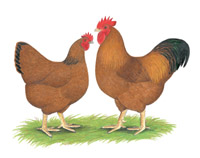
| Male Mature Weight: 34 oz |
| Female Mature Weight: 30 oz |
| Comb Type: Single |
| Egg Color: Brown
Egg Size: [Small] Rate of Lay: "good" |
| Type: Meat - Laying - Dual-purpose - Other |
| Setting: Yes |
| Disposition/Temperament: [Friendly to humans, may be aggressive to other chickens] |
| Climate Hardiness: All Climates, |
| Show Class: Single Comb Clean Legged Bantams |
Ideal Poultry Breeding Farms, Inc:
New Hampshire Bantams originated in the United States and are a relatively common breed. Their bodies are much shorter and more compact than Rhode Island Red Bantams. The plumage color of both the male and female is primarily chestnut red with black tails. The male's hackle and saddle plumage is lustrous, golden bay while the head, back, wing shoulders and wing bows are brilliant, reddish bay, which gives the male a darker plumage color than the female.
Standard weights at maturity are male-34 oz, and hen-30 oz.
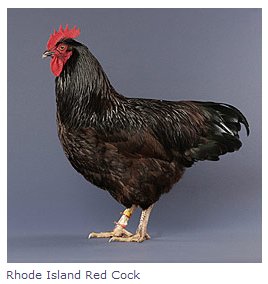 Picture credit: My Pet Chicken |
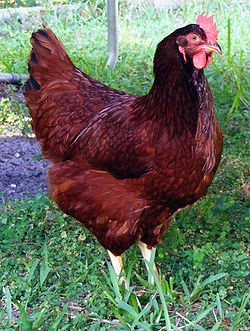 Hen. Wikipedia |
| Male Mature Weight: 8.5 lbs |
| Female Mature Weight: 6.5 lbs |
| Comb Type: Single |
| Egg Color: Brown
Egg Size: 25-26 Ounces/dozen Rate of Lay: 250-300/year |
| Type: Meat - Laying - Dual-purpose - Other |
| Setting: "Seldom" |
| Disposition/Temperament: Gentle, sociable to humans, can be aggressive, bears confinement well |
| Climate Hardiness: All Climates, Winter-hardy [1], [2] |
| ALBC Priority: Recovering |
| Show Class: Production |
This is one of the most famous and all time popular breeds of truly American chickens. Developed in the early part of this century (20th) in the state of the same name, they have maintained their reputation as a dual purpose fowl through the years. Outstanding for production qualities, they have led the contests for brown egg layers time after time. No other heavy breed lays more or better eggs than the Rhode Island Reds. Our "production" strain is keeping up the fine reputation of this old favorite. Baby chicks are a rusty red color and the mature birds are a variety of mahogany red.
Customer comments:
Your Rhode Island Reds are the most dependable layers of brown eggs I've owned. My daughter showed
a pair of pullets last year in the production class at our 4-H fair, and she entered their eggs in
the brown egg class. She took first place in each category. Your RIR are hard to beat for brown egg layers
in a home flock.
- - -
These RIR are not only healthy and beautiful, but are the friendliest I've ever owned. One hen is
allowed to range free during the day and loves to be picked up and adored. She accompanies us to the
mailbox and on walks!
- - -
I have one male Rhode Island Red that I decided to keep as a pet. He has the most wonderful
personality. He talks and chatters, is very gentle, and LOVES to be held and carried around the
barnyard. A great pet!
- - -
I've had Rhode Island Reds for years and decided to purchase some from Murray McMurray. First, not a
single loss during shipment, chicks were bright and energetic right from the start. They all feathered
nice, have great dispositions/temperment and will soon be allowed to range with my older birds...
- - -
I bought 5 of your RIR, and 5 of your Barred Rock. They are wonderful and beautiful birds. This is my
first year raising chickens, and so far it has been a success. I am proud of these chickens. And
they have a great personality. They are very curious. One of the hens, loves to be touched. When you
put your foot in the pen she comes right over to say hi. I love these birds, they are truly great.
- - -
Wow, Thank you for the chicks that you sent me. They are by far the most healthy chicks I've ever had.
I tried to let the Rhode Island Reds out of the box and they just jumped out. What I like most of all
is that they follow me where ever I go. Thank you Mcmurray Hatchery.
- - -
WE ORDERED 25 RHODE ISLAND REDS LAST FALL FOR THE FIRST TIME. BEST BROWN EGG LAYERS WE HAVE EVER SEEN.
WE HIGHLY RECOMMEND THIS BREED AND HIGHLY RECOMMEND MCMURRAY HATCHERY. THANKS.
- - -
I just recieved my Rhode Island Reds and they are wonderfull. I already had some and decided to get more
because they are very friendly. The chicks were in great shape when I recieved them...
- - -
We received our Rhode Island Reds last June. As a first time "chicken farmer" I was worried about doing
something wrong but they were great. Not one bird had a problem. We have 18 hens and they lay an average
of 14-18 eggs a day. They love attention and are very gentle. They meet me at the gate and swarm around
my feet while I am with them and will follow me anywhere I go.
- - -
I received some Rhode Island Reds over a year ago and they are some of the hardiest breed of chickens I
ever seen. They didn't go in the coop and survived the winter...WOW
- - -
This was my first attempt at raising chickens and I didn’t lose a single one. I am amazed at the health
of the birds. All the birds are still in perfect health after 8 months and laying like crazy now. Thanks
- - -
I have had RIR for 4 years now and they are still running and looking like they were a year old! They are
still VERY healthy and happy. I LOVE RIR!
- - -
I just received my RIR for the first time and they are great! They lay big, brown eggs every day and they
are very hardy. Thanks again.
- - -
RIR are awesome chickens. I received 20 last year and they are all still laying. The best part about them
is that they are more pets then farm chickens. They are just so sweet. Thanks
- - -
These are the best birds ever! I ordered 25 last year and they are all still alive! They lay great eggs
and always greet me when I go out to collect the eggs.
- - -
I ordered Rhode Island Reds last year and I am so glad that I did. They just started laying eggs a couple
of months ago and now we are getting 10 a day...
- - -
These chickens are amazing. I got 25 of them last year. They started laying at 5 months and they are
laying like crazy! These chickens are egg laying machines. Your service is great. They came happy and
energetic. I am looking forward to doing more business with you. Kosta New Hampshire
- - -
Recently I decided to start raising chickens in my back yard. After a lot of research, I settled on your
Rhode Island Reds. I purchased them on 11/17/2009 and used your website and catalog to learn how to care
for them. I followed your website strictly and was so excited to see that after only 4 1/2 months they
started laying eggs. I will alway get my chickens from you. Thanks for your wonderful direction...
- - -
You can't beat Rhode Island Reds for year-round egg production in a homestead setting. We sell our eggs,
and I used to buy sex-linked crosses to get the largest number of eggs, but I soon switched to Rhode
Island Redss and have stuck with them for years. They're calm, friendly, winter hardy, and excellent layers.
- - -
I've tried several other hatcheries' Rhode Island Reds, but, hands down, McMurray's strain is the BEST
steady and prolific layers I've gotten for brown eggs. When the hens get past their prime, they make the
best chicken soup and dumplings around. I most strongly recommend McMurry for any poultry needs...
Originated in Rhode Island and recognized as a distinct breed in 1904. The Single Comb Rhode Island Red is our most popular breed for egg production. They are also known to be a good winter layer.
Hen -------7 1/2 lbs
Rooster----9 1/2 lbs
Pullet------5-6 lbs
Cockerel---7-8 lbs
Ideal Poultry Breeding Farms, Inc:
A well-known "old breed" that is a popular dual-purpose producer of brown eggs.
Rhode Island Reds are an old time, well-known American breed, which was developed in the state of Rhode Island. A distinct characteristic of this breed is their horizontal, oblong body, which is deep, broad and long, sometimes described as "brick shaped". They are an excellent dual-purpose bird that efficiently produces large brown eggs. From the time they are chicks until maturity they may have white on the wing tips, but when they are fully matured they should not have any white feathers.
Standard weights at maturity are males-8 1/2 lbs. and hens-6 1/2 lbs.
Rhode Island Reds were developed in the state of Rhode Island and are on of the most recognized and popular of the American breeds for years. They are one of the most prolific egg layers, producing approximately 250 eggs annually, while still heavy enough to be considered an excellent dual purpose breed. They make an excellent choice for both cold and warm weather climates.
Comb: Single
Standard weight at maturity: Hens 6 1/2 lbs, males 8 1/2 lbs.
Egg color: Brown
Wikipedia (NAH)
They are a utility bird, raised for meat and eggs, and also as show birds. They are a popular choice for backyard flocks because of their egg laying abilities and hardiness...
Developed in Massachusetts and Rhode Island, early flocks often had both single and rose combed individuals because of the influence of Malay blood. It was from the Malay that the Rhode Island Red got its deep color, strong constitution, and relatively hard feathers...
Rhode Island Reds are tough birds, resistant to illness, good at foraging and free ranging, and typically docile, quiet, and friendly. Although they are widely known as good layers through cold periods, if the coop temperature drops below freezing (0 °C (32 °F)), their output drops considerably, and the tips of their combs become very susceptible to frostbite.
Although usually friendly, Rhode Island Red roosters, and sometimes hens, can be quite aggressive towards young children and adults. Most roosters will also attack strangers (humans or animals) if they feel nervous or have never seen the intruder. They are usually friendlier with familiar people, such as those responsible for feeding. Both hens and roosters are known to be aggressive with other chickens, especially in confinement. Rhode Island Red roosters have been known to kill intruding foxes or dogs.
Even though they can have an aggressive nature, if raised properly and lovingly, they can be quite loving...
Rhode Island Reds are excellent egg layers... they can end up producing up to 250 to 300 large, light to dark brown eggs per year. When free ranged, their first year eggs can be too large to fit comfortably in a standard or medium egg carton. Nice hens can lay up to 6-7 eggs per week depending on their care and treatment. Rhode Island Red hens lay much more eggs than an average hen if provided plenty of quality poultry feed.
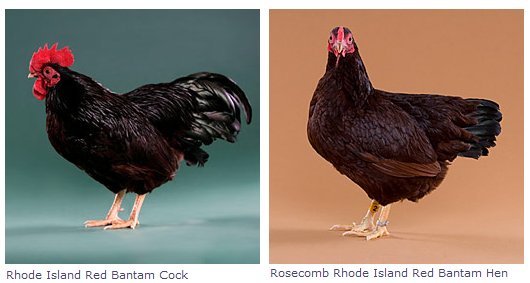 My Pet Chicken |
| Male Mature Weight: 34 oz (2 lb 1 oz) |
| Female Mature Weight: 30 oz |
| Comb Type: Single |
| Egg Color: Brown
Egg Size: [Small] Rate of Lay: [250-300/year] |
| Type: Meat - Laying - Dual-purpose - Other |
| Setting: Good brood hens and mothers |
| Disposition/Temperament: Mellow with kids, [bears confinement well] |
| Climate Hardiness: [All Climates, Winter-hardy] [1], [2] |
| Show Class: Single Comb Clean Legged Bantams |
Our Red is of the show variety. Most large size Reds have had production blood introduced to increase egg production but it detracts from their type. Our Rhode Island bantams are a deep mahogany color and have the old fashioned single comb red appearance. They are good layers of brown eggs and the eggs will hatch well.
Customer comments:
I want to thank you so much. We received 26 Rhode Island Reds from your farm 2 weeks ago. They are happy,
energetic and tons of fun to watch every day as they grow. They are all good eaters and I would of never thought
such a large group would survive the transit and ALL are beautiful and healthy! I recommend you to all my friends!
- - -
I received 25 Rhode Island Red Bantams January of 2004. They truly are proving to be "show quality". They
are pulling double duty as brood hens, remarkably dedicated mothers. Form, color and temperment all Grade "A".
A beautiful way to decorate our country landscape! Thanks again, for excellent, trouble free stock! My kids
walk around with them on their shoulders like parrots :)
A miniature size of the Single Comb Rhode Island Red Standard chicken. Admitted to the American poultry Standard of perfection in 1940 and makes a great backyard chicken for enjoyment and eggs.
Hen ................30 oz.
Rooster ..........34 oz.
Pullet ..............26 oz.
Cockerels ......30 oz.
Ideal Poultry Breeding Farms, Inc:
Single Comb Rhode Island Red Bantams are known for their beautiful, lustrous, rich, dark mahogany red color with a black tail. They have a very distinctive horizontal, oblong body shape that is deep, broad and long, sometimes described as being "brick shaped". From the time the chicks hatch until maturity, they may have white on the wing tips that will leave when they mature.
Standard weights at maturity are male-36 oz, and hen-34 oz.
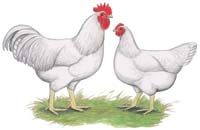
| Male Mature Weight: 8.5 lbs |
| Female Mature Weight: 6.5 lbs |
| Comb Type: Single |
| Egg Color: White
Egg Size: 25-26 Ounces/dozen Rate of Lay: "Very Good" |
| Type: Meat - Laying - Dual-purpose - Other |
| Setting: "Average" |
| Disposition/Temperament: Varies widely by individual and upbringing |
| Climate Hardiness: All Climates, rose-comb are Winter-hardy [1], [3] |
| ALBC Priority: Watch |
| Show Class: Production |
Ideal Poultry Breeding Farms, Inc:
They are related to the more popular Rhode Island Reds and are recognized by their long backs and brick shaped bodies.
Rhode Island Whites are a rare variety, which are related to Rhode Island Reds, that are a well-known old American variety. They have the same distinct body characteristics as Rhode Island Reds; with horizontal, oblong bodies, which are deep, broad and long, and are sometimes described as "brick shape". They are efficient producers of large brown eggs. Rhode Island Red males mated with Rhode Island White females produce Gold Sex Link chicks, which can be sexed when they hatch.
Standard weights at maturity are males-8 1/2 lbs. and hens-6 1/2 lbs
Wikipedia: [NAH]
...Moderately popular up until the 1960's, it is now a relatively rare fowl. It is listed on the American Livestock Breeds Conservancy as a breed to watch, with less than 3,000 birds known to have existed circa 2003...
Rhode Island Whites are a dual-purpose fowl suitable for both meat and egg production. Males weigh 8.5 pounds (3.9 kilos) and hens weigh 6.5 pounds (3 kilos). They have a single variety, with pure white plumage, red wattles and earlobes, and a medium size rose comb.
Backyard Chickens.com: [NAH]
While the names and place of origin are the same, the Rhode Island White is actually a distinctly different breed from the Rhode Island Red. The Rhode Island White was developed in 1888 by Mr. J. Alonzo Jocoy of Peacedale, Rhode Island. He developed the breed by crossing White Wyandottes with Partridge Cochins and Rose Comb White Leghorns. In 1903, Mr. Jocoy made the breed known to the public and offered individuals for sale. The breed continued to be developed and improved so that it more closely resembled the Rhode Island Red’s brick-like body shape. Fairly popular up until the 1960's it is now considered a uncommon-moderately rare breed. The breed was admitted into the APA in 1922. The standard only accepts rose comb Rhode Island White. The crossing of a Rhode Island Red and a Rhode Island White will result in Red Sex-Link offspring, meaning offspring that can be sexed by down color alone at hatch. Males are white, females are red.
Rhode Island White- The Rhode Island White is only available as Rose Combed. The beak for the Rhode Island White is yellow. Legs and skin are yellow. Eyes are Green or Hazely. Large Fowl weights: Roosters weigh 8.5 pounds, hens weigh 6.5 pounds. Bantam weights: 34 ounces for a cock and 30 ounces for a hen at eighteen months of age.
The temperament of individual birds will vary greatly depending on sex, and method of raising.
|
Picture credit: Wikipedia |
| Male Mature Weight: 7.5 lbs |
| Female Mature Weight: 6 lbs |
| Comb Type: Rose |
| Egg Color: White to Tinted
Egg Size: "Large" Rate of Lay: "a good amount" of eggs, ~3/week |
| Type: Meat - Laying - Dual-purpose - Other |
| Setting: No |
| Disposition/Temperament: Active, but tolerates confinement |
| Climate Hardiness: All Climates, Winter-hardy [1], [2] |
| ALBC Priority: Critical |
| Show Class: English |
This Old English Breed with reddish brown feathers tipped with black spangles has a large rose comb covered with prominent points. They are white skinned & lay tinted eggs. Chicks are a light reddish tan with black speckles and some stripes.
Customer comments:
These have got to be the most active and playful out of our entire group. They arrived this morning
in perfect health and are quickly becomming the family favorite.
Ideal Poultry Breeding Farms, Inc:
Redcaps, which are very rare, originated in Derbyshire, England and have been bred to have very large rose combs, which is their most identifying characteristic. Their plumage pattern is similar to the golden spangled pattern. They have white skin and are one of only a few breeds that have red ear lobes and produce white-shelled eggs. Their body carriage is relatively low, and they have a compact body appearance.
Standard weights at maturity are males-6 lbs. and hens-5 lbs.
Wikipedia: (NAH)
The Derbyshire Redcap is a breed of chicken originating in the English county of Derbyshire. The name "Redcap" derives from the breed's unusually large Rose-type comb. British breed standards dictate a length of more than 7 centimeters (3 inches) of length for a Redcap comb. It is covered in small, fleshy points, and has a distinct spike pointing backwards called a "leader". Combs, wattles and earlobes are all ideally bright red...
Derbyshire Redcaps are a hardy, active breed of chicken that does well in free range conditions. They are well suited for dual-purpose farm flocks, being used for both meat and egg production in addition to their ornamental qualities. Hens do not usually go broody, and lay a good amount of large, white colored eggs.
Derbyshire Redcaps were common on British farms until the middle of the 20th century, particularly around the southern Pennines. They have never been preferred by intensive farms or commercial operations, and have always been primarily a barnyard fowl. In the 21st century, they are a very rare chicken, with the largest numbers still residing in their home country...
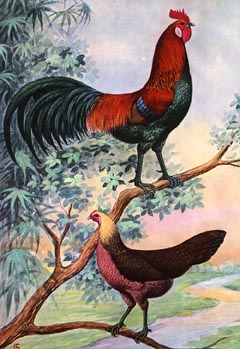
| Male Mature Weight: 4 lbs |
| Female Mature Weight: 3 lbs |
| Comb Type: Single |
| Egg Color: Tinted
Egg Size: ### Ounces/dozen Rate of Lay: ### |
| Type: Meat - Laying - Dual-purpose - Other |
| Setting: Yes |
| Disposition/Temperament: Wild |
Jungle birds are the "original bird" from which all varieties and strains of domesticated chickens arrived based on comments and observations made by Darwin. This type of chicken/fowl is smaller than most common sizes of chickens yet a little bigger than the modern day bantams that are being bred. These birds have one of your best chances of free ranging fowl and avoiding predators.
Hen--------- 3 lbs
Rooster------4 1/2 lbs
Pullet-------- 2 1/2 lbs
Cockerel-----4 lbs
Ideal Poultry Breeding Farms, Inc:
Indian Red Jungle Fowl (Gallus bankivus), which lay tinted eggs, originated in India, and is one of four main species of Jungle Fowl. It is claimed that all the present varieties of chickens descended from Jungle Fowl, which is the name applied to wild fowl. Indian Red Jungle Fowl have been bred in their purity, in captivity and are well known in many sections of the world. They look much like Brown Leghorns, except they are noticeably smaller, have willow green shanks, many body feathers, and have shafting where the shaft is lighter than the web.
Standard weights at maturity are males-4 lbs. and hens-3 lbs.
See also Wikipedia entry.
Wikipedia: [NAH]
The Plymouth Rock, often called simply Rocks or Barred Rocks (after their most popular color), is a chicken breed that originated in the United States. The Plymouth Rock is a dual-purpose, cold-hardy bird and therefore makes a great breed for the small farm or backyard flock owner. These chickens are often called Plymouth Rocks, but this title correctly belongs to the entire breed, not just the Barred variety. There are seven varieties of Plymouth Rock chickens: barred, blue, buff, Columbian, partridge, silver-penciled and white.
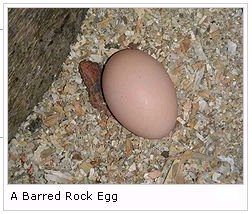 Wikipedia |
Plymouth Rocks are large, long-lived chickens... Generally, Plymouth Rocks are not aggressive, and tame quite easily. They are docile and may show broodiness. The hens usually make good mothers. However, some males and females are big and active enough to be quite a problem if they become aggressive.
Plymouth Rocks lay a large egg that varies in color from light to medium brown with a touch of pink. The birds continue laying all through the winter with decreased production. On average, each hen will lay around 200 eggs per year...
Choice among families who choose to raise chickens at home as pets. The birds are well-adaptable to confinement or free range, are docile, friendly, and easily handled.
Backyard Chickens.com: [NAH]
"...It has been a great bird due to hardiness, egg laying, broodiness, and meat production. The first production meat chicken happened to be the Barred Rock. But now The White Rock is typically the female used to create Cornish X meat chickens.
"I have found that this breed is friendlier than other breeds, mine always come running and they imprinted as chicks. My partridge Rock will even let me pick her up; very docile. More active then breeds such as Leghorns, EE, and RIR. They are a hardy breed that can withstand quite a bit. I have also noticed that they also grow bigger, faster than most breeds do. Also great layers of large brown eggs and will sometimes become broody and be great mothers." - ticks
My Pet Chicken: [NAH]
Barred Plymouth Rocks or "Barred Rocks", as they're called, are one of the most popular dual-purpose chickens on small farms today. Their heritage is unclear with reports of different crosses, but what is clear is that they're very friendly, great layers of large brown eggs and able to withstand cold weather quite nicely. Though they tolerate confinement, they're most happy when they get to range freely. All varieties of Plymouth Rock aside from the Barred and White varieties are relatively rare.
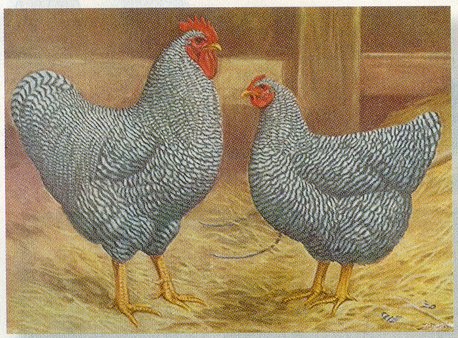
| Male Mature Weight: 9.5 lbs |
| Female Mature Weight: 7.5 lbs |
| Comb Type: Single |
| Egg Color: Brown
Egg Size: 26-27 Ounces/dozen Rate of Lay: "Excellent", ~4/week |
| Type: Meat - Laying - Dual-purpose - Other |
| Setting: Yes |
| Disposition/Temperament: Calm, smart, plucky, good with kids, bears confinement |
| Climate Hardiness: All Climates, Winter-hardy [1], [2] |
| ALBC Priority: Recovering |
| Show Class: American |
The Barred Rock is one of the all time popular favorites in this country. Developed in New England in the early 1800's by crossing Dominiques and Black Javas, it has spread to every part of the U.S. and is an ideal American chicken. Prolific layers of brown eggs, the hens are not discouraged by cold weather. Their solid plumpness and yellow skin make a beautiful heavy roasting fowl. Our strain has the narrow, clean barring so desirable in appearance. Their bodies are long, broad, and deep with bred-in strength and vitality. These chickens are often called Plymouth Rocks, but this title correctly belongs to the entire breed, not just the Barred variety. Whatever you call them, you can't beat them for steady, reliable chickens. Baby chicks are dark gray to black with some white patches on head and body.
Customer comments:
I am 12 years old, and I wanted to have a pet. I chose chickens, because i enjoyed playing with
them. I bought my first chicks last june. They were all very healthy and exteremly adorable! I had
ten of them and I raised them in my room. Now they are big and strong. They live in my backyard,
though I don't know if my neighbors like that. They all have names, Paprica, Perfect, and Sunny are
three of the names. I just wanted to thank you for bringing me some of the best freinds I have ever
had.-Amber
- - -
I had wanted a chicken since I saw my grandma's Rhode Island Reds. Now, at 14, I finnaly convinced my
mom to let me get some chickens, and I chose Barred Rocks. I could not have made a better choice.
I raised them in my room. My chickens are now hearty, beautiful, and lay wonderful brown eggs. I feel
so proud that I raised these beautiful birds from chick to adult on my own.
- - -
5 years ago, we ordered Barred Plymouth Rock pullets-our first chicks ever-to show in 4H, and have
had this breed ever since. Our McMurray pullets have been in the purple every summer since! Our judges
comment every year on how nice they are, and our parents love that they lay so well! ... We will be
graduating from high school (and therefore 4H) soon, but our folks say they will keep a flock of
McMurray Barred Rocks around for their beauty, good company, and of course, their eggs!
- - -
WOW! WOW! WOW! My family and I ordered 10 Barred Rocks along with some Buff Minorcas and SC Brown
Leghorns last October. All arrived safe and sound, and full of vigor, but the reason I am writing
is to tell you that my Rocks are not only the most Standard perfect birds I've ever seen, the pullets
started to lay steady at 17 weeks! They are the most friendly birds and all 4 of my kids adore them.
Thank you for the wonderful poultry and service. But most of all, the memories I'll keep of the kids
volunteering to care for them and the 1/2 inch of dust that has built up on the video games!! Thanks
again, Tim Hogan.
- - -
This city boy ordered chickens for the first time last July. I couldn't be more pleased with my little
flock of Barred Rocks. They are friendly and hilarious. The hens started laying in December and haven't
let up. The cockerels dressed out nicely at a good weight.The remaining rooster has a very high opinion
of himself and investigates any mystery thoroughly. I have to comment on your customer service. The
lady who took my order was so helpful. She brought up issues I hadn't considred and didn't quit until
she was sure I was ready to recieve my chicks. Fantastic! You rarely encounter service like that any
more. Thanks again. Murray McMurray has my business from now on.
- - -
I purchased Barred Rocks from McMurray Hatchery in Feb. 2002. They are some of the finest birds I
have ever seen. At first I was unsure about raising birds from a hatchery. But my concerns were short
lived. I am overwhelmed with the production of eggs that started at four months of age. I am equally
impressed with the quality of egg these fine birds produce. I have one rooster named General. He is
the largest, and finest of the four roosters I ordered with 20 hens, and he is of show quality I am
sure....
Recognized by the American Standard of Perfection as a distinct breed in 1874 and known by the kind of chickens that "Grandma" used to raise. A part of the Plymouth Rock family and an excellent winter/summer brown egg layer. The Barred Rock is a great back yard poultry for production and kid friendly.
Hen -------7 1/2 lbs
Rooster----9 1/2 lbs
Pullet------6 lbs
Cockerel--8 lbs
Ideal Poultry Breeding Farms, Inc:
One of America's oldest breeds-- an excellent dual-purpose breed.
Barred Plymouth Rocks are one of America's oldest and most popular breeds. All of their plumage is black and white barred which is the result of the barred (B) gene. Because males are the homozygous sex, they have two barred alleles (BB) and are therefore lighter in color than the females, which are the heterogametic sex and have only one barred allele(B_). They are an excellent dual purpose breed, known for their efficient production of large brown eggs.
Standard weights at maturity are males-9 1/2 lbs. and hens-6 lbs
Barred Plymouth Rocks, also referred to as Plymouth Rocks or Barred Rocks, are one of America's oldest and most popular breeds of chicken. The Barred Rock is a cross between a Dominique and a Black Java or Cochin. They are a great dual purpose breed, but are considered extremely docile and very hardy, making them an excellent choice for both the novice chicken raiser and experts alike.
Comb: Single
Standard weight at maturity: Hens 6 lbs, males 9 1/2 lbs.
Egg color: Brown
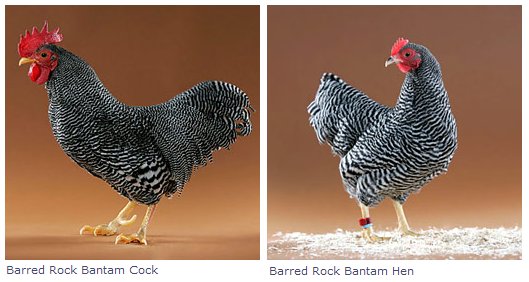
My Pet Chicken |
| Male Mature Weight: 36 oz |
| Female Mature Weight: 34 oz |
| Comb Type: Single |
| Egg Color: Brown
Egg Size: [Small] Rate of Lay: [~200/year] |
| Type: Meat - Laying - Dual-purpose - Other |
| Setting: Yes |
| Disposition/Temperament: Docile, Smart, friendly, bears confinement |
| Climate Hardiness: All Climates, Winter-hardy [1], [2] |
| Show Class: Single Comb Clean Legged Bantams |
Miniature sized chickens of the Barred Rock Standard breed and are of recent origin making extreme progress in the hands of poultry breeders. A great backyard chicken and a great show bird.
Hen .................32 oz.
Rooster ..........36 oz.
Pullet ..............28 oz.
Cockerels ......32 oz.
Ideal Poultry Breeding Farms, Inc:
Barred Plymouth Rock Bantams are a beautiful black and white barred bantam. The sex linked dominant barred (B) gene is responsible for the barring. In birds, the heterogametic sex is the female; the genotype of a barred female is B- while the homozygous barred male's genotype is BB. Since the barred males have a double dose of barring, they are lighter in color than the barred females.
Standard weights at maturity are male-36 oz, and hen-34 oz.
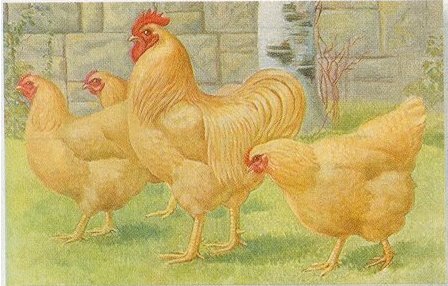
| Male Mature Weight: 9.5 lbs |
| Female Mature Weight: 7.5 lbs |
| Comb Type: Single |
| Egg Color: Brown
Egg Size: 25-26 Ounces/dozen Rate of Lay: "Good", ~4/week |
| Type: Meat - Laying - Dual-purpose - Other |
| Setting: Good, in late spring too |
| Disposition/Temperament: Docile, smart and friendly, bear confinement well |
| Climate Hardiness: All Climates, Winter-hardy [1], [2] |
| ALBC Priority: Recovering |
| Show Class: American |
Our Buff Rocks are truly a gorgeous color, being pure golden buff from feather base to tip. The intense yellow of legs and beaks, the bright red of comb and wattles along with the golden plumage make these a real delight to the eye. Our strain has the same deep, well set bodies as the other Rocks, possibly a little smaller in size. They are fine winter layers of brown eggs; also good setters in late spring. Baby chicks are a soft buff color right from the start.
Customer comments:
I LOVE my Buffs!! Being a first time chicken keeper I am finding the recomendation McMurray gave me for a heavy
breed, brown egg laying bird with cold/high altitude hardiness is working perfectly. I have 16 hens (most of
which are laying daily or every other day now) and two roosters.. 6 other roosters went into the frying pan this
past fall (and were YUMMY!). Hens started laying smallish eggs at 6 months but now (apx 8 months) the eggs are
good sized and pretty shades of brown. I already have neighbors calling me to see if I have extras to sell (cool,
this will pay for their weekly feed). This is SO Easy!!! Thanks for your help McMurray
- - -
Thank you McMurry Hatchery! My chicks arrived about five weeks ago. I moved the chicks to the greenhouse where the
chicken coop is located at about 3 weeks, and now their feathers have now grown in nicely. My Weimaraner and I
spend quite a bit of time in the greenhouse interacting with the chicks
Ideal Poultry Breeding Farms, Inc:
A medium sized, quiet dispositioned bird with yellow skin. A good substitute for Buff Orpingtons because they lay better.
Buff Plymouth Rocks are a relatively rare variety, which is not very well known. They are very attractive with solid rich golden-buff plumage. The male has a more brilliant luster than the female. Their appearance is very similar to Buff Orpingtons except their feathering is not nearly as loose. They have yellow skin rather than white and their bodies are longer. Most Buff Rocks are used for the production of brown eggs but they are also useful for production of fowl meat.
Standard weights at maturity are males-9 1/2 lbs. and hens-7 1/2 lbs.
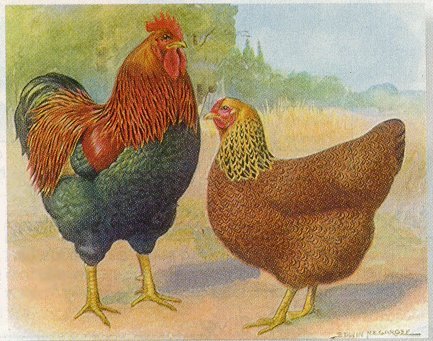
| Male Mature Weight: 9.5 lbs |
| Female Mature Weight: 7.5 lbs |
| Comb Type: Single |
| Egg Color: Brown
Egg Size: 25-26 Ounces/dozen Rate of Lay: "Good", ~4/week |
| Type: Meat - Laying - Dual-purpose - Other |
| Setting: One of the best |
| Disposition/Temperament: Friendly, quiet, bear confinement well |
| Climate Hardiness: All Climates, Winter-hardy [1], [2] |
| ALBC Priority: Recovering |
| Show Class: American |
This is one of the best varieties for the exhibitor as it is quite rare and makes an outstanding show bird. The highly colored male has black hackle and saddle feathers with an edging of rich brilliant red, a lustrous greenish black breast and body touched with reddish bay on the wings. The females are completely different with their brown plumage and distinct pencilings of black following the outline of each feather. These are fairly good sized birds though not quite as large as their cousins, the Barred and White Rocks. The yellow skin and plump body make a nice eating fowl, and the hens lay brown eggs, and are considered one of the best setters and broody hens. The baby chicks are a rick dark brown resembling the color of an expensive fur coat.
Customer comments:
I ordered 25 of the Partridge Rocks. When they got here they were all in great shape! They almost jumped right
out of the box! ... Thanks benny lawrence
- - -
Dear McMurray Hatchery, I ordered a few of these wonderful birds in a larger order last year. Boy do they stand
out! They add a special color contrast among white, buff, and black birds. I waited until they were mature and
took some to the fair this year. My rooster and hen got two blue ribbons and the rooster got Best of Show! Thanks
a lot, Abby Montana 4-Her
- - -
I order 13 of these beauties last spring and couldn't be happier. They are a wonderful breed, they lay beautiful
eggs and are especially fond of shoelaces. They all have their own personality and are very fun to watch interact.
Thanks McMurry for such beautiful ladies.
- - -
I bought white rocks, barred rocks, buff rocks and partridge rocks from McMurray Hatchery in June of 09. They
have done extremely well, are beautiful birds with heavy coats of shiny feathers. They are the only chickens
in our area who are laying this winter. I have 12 hens and get between 5 and 9 eggs a day. They are also cute
and friendly. Very tame. They come when called and even when they aren't called, the come running when they
see me. I really love my hens!
Recognized as a distinct breed in 1909 and admitted to the American Standard of Perfection. The hens are large and lay brown eggs. The Partridge is just one of the varieties of the Plymouth Rock family and noted for a good dual purpose chicken.
Hen -------7 lbs
Rooster----8 lbs
Pullet------5 lbs
Cockerel--6 lbs
Ideal Poultry Breeding Farms, Inc:
A medium sized bird with a quiet disposition. Males and females have different plumage patterns which are beautiful and unique.
Partridge Plymouth Rocks are a beautiful, rare variety of Plymouth Rocks, which is the most popular dual-purpose breeds. The partridge plumage pattern is very striking and is one of the most beautiful of all plumage patterns with the male pattern being completely different from that of the females. They have the same general performance characteristics as Barred Plymouth Rocks but not as much emphasis has been placed on improving egg production and egg size of the brown eggs which they produce.
Standard weights at maturity are males-9 1/2 lbs. and hens-7 1/2 lbs.
Partridge Plymouth Rocks are a very rare variety of the Plymouth Rock family. The males possess one of the most beautiful plumage patterns, which makes them an excellent exhibition bird. Although they have most of the common characteristics of the Barred and White Rocks, they are slightly smaller. Considered a popular and efficient dual purpose breed. They also make excellent setters.
Comb: Single.
Standard weight at maturity: Hens 7 ½ lbs, males 9 ½ lbs.
Egg color: Brown
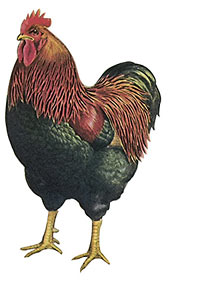
| Male Mature Weight: 36 oz (2 lb 4 oz) |
| Female Mature Weight: 32 oz |
| Comb Type: Single |
| Egg Color: Brown
Egg Size: [Small] Rate of Lay: [~200/year] |
| Type: Meat - Laying - Dual-purpose - Other |
| Setting: Yes |
| Disposition/Temperament: Docile and friendly, bear confinement well |
| Climate Hardiness: All Climates, Winter-hardy [1], [2] |
| Show Class: Single Comb Clean Legged Bantams |
In the Opinion of many, these are the showiest of all the Rocks. They exhibit the eye catching partridge color patterns, are good layers of brown eggs, and one of our nicest bantams.
Customer comments:
The Partridge Rock bantams are a pure joy to have as ranging bantams. At 7 months of age, the cockerels
have such subtle color variation throughout their plumage. Though they don't exhibit the adult reds and yellows
yet, the blues, green sheen and even purple hues on the wings are a source of great visual joy! I hand feed them,
just to have them in close for detailed observation. Thank you for such excellent stock! Sincerely, Fred
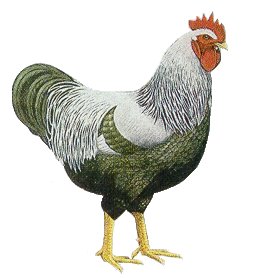
| Male Mature Weight: 9.5 lbs |
| Female Mature Weight: 7.5 lbs |
| Comb Type: Single |
| Egg Color: Brown
Egg Size: "Large" Rate of Lay: ~200/year |
| Type: Meat - Laying - Dual-purpose - Other |
| Setting: Yes |
| Disposition/Temperament: Docile and friendly, bears confinement |
| Climate Hardiness: All Climates, Winter-hardy [1], [2] |
| ALBC Priority: Recovering |
| Show Class: American |
These rare and beautiful birds are highly prized for exhibition purposes and for their valuable plumage which is ideal for fly tying. The male with silvery neck and back and black breast contrasts sharply with the female which is covered with distinct silvery gray and black penciling. Rocks have single combs.
Customer comments:
My Silver Penciled Rocks hatched on St. Patrick's Day and arrived alive and well the fallowing Monday..
Almost 7 months later ALL are still well the hens now laying and the roosters absolutely magificent.....I
have my catalog about worn out trying to choose for next year.. Thank You ...
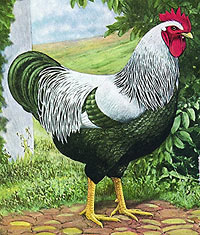
| Male Mature Weight: 36 oz (2 lb 4 oz) |
| Female Mature Weight: 32 |
| Comb Type: single |
| Egg Color: Brown
Egg Size: [Small] Rate of Lay: [~200/year] |
| Type: Meat - Laying - Dual-purpose - Other |
| Setting: Yes |
| Disposition/Temperament: Docile and friendly, bears confinement |
| Climate Hardiness: All Climates, Winter-hardy [1], [2] |
| Show Class: Single Comb Clean Legged Bantams |
The silvery neck and back of the male along with its black breast contrasts sharply with the female which is colored with a very distinct silvery gray which is penciled in black. These bantams lay brown eggs and the eggs hatch well.
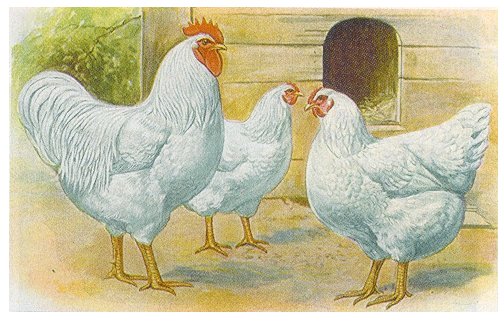
| Male Mature Weight: 9.5 lbs |
| Female Mature Weight: 7.5 lbs |
| Comb Type: Single |
| Egg Color: Brown
Egg Size: 25-26 Ounces/dozen Rate of Lay: "Very Good", ~4/week |
| Type: Meat - Laying - Dual-purpose - Other |
| Setting: Yes |
| Disposition/Temperament: Calm, curious, bears confinement |
| Climate Hardiness: All Climates, Winter-hardy [1], [2] |
| ALBC Priority: Recovering |
| Show Class: American |
Our White Rock pullets are outstanding for egg production the entire year, and are especially desirable through the cold winter months when lighter breeds slack off. They lay a brown egg of fine quality and size. The rapid growth, white, easy-to- dress feathers, and golden yellow skin of the cockerels of our strain make them equally desirable. Raise some for the frying pan or roaster. They are compact and well fleshed at almost any age. They are all big birds, hens reaching 6 to 7 lbs. and cocks 8 to 9 lbs. A flock of these pure white birds ranging busily over a grassy field is one of the prettiest sights you will ever see. Baby chicks are a creamy white and may show a touch of gray smokiness.
Customer comments:
I ordered White Rocks 4/07. I have enjoyed these chickens very much. No one believes you can
get attached to chickens. They are great egg layers and super sweet. The rooster - Henry, is
such a good boy. He is so beautiful... White Rocks are a great choice.
- - -
... The White Rocks and Easter Eggers are already the most tame and curious of the flock (also
have Speckled Sussex and Anconas). In our first flock, these two breeds were our favorite for
the combination of their beauty, calm dispositions, and egg production... Dansville, MI
- - -
... We are very pleased with our chicks. It is very easy to catch them in the evening and they
will follow you to their cages. Can't wait for them to start laying...
The White Rock recognized as a distinct breed and admitted to the American Standard of Perfection in 1888. The White Rock is a good dual purpose chicken and a member of the Plymouth Rock family. They lay brown eggs and the cockerels make very good fryers.
Hen -------7 1/2 lbs
Rooster----9 1/2 lbs
Pullet------6 lbs
Cockerel--8 lbs
Ideal Poultry Breeding Farms, Inc:
A medium-sized, quiet dispositioned, white plumaged, dual-purpose bird that is suitable for both meat and egg production.
White Plymouth Rocks, which lay brown eggs, are the second most popular variety of Plymouth Rocks and are identical to Barred Plymouth Rocks except for their color. They are one of the basic breeds used in the production of broiler meat crosses primarily because they have yellow skin, feather rapidly and grow fast. For producers who are dissatisfied with Cornish Rocks because they have leg weakness problems, grow too fast and their meat is too fat, White Rocks are a good alternative.
Standard weights at maturity are males-9 1/2 lbs. and hens-7 1/2 lbs.
White Plymouth Rocks are identical to the Barred Plymouth Rocks, except for their color, and rank second in popularity among the Plymouth Rock variety. Their yellow skin and rapid growth make them a standard breed used in the production of broiler meat crosses. White Plymouth Rocks are leaner and less prone to leg problems than Cornish Rocks, so they make a great alternative meat bird.
Comb: Single
Standard weight at maturity:Hens 7 1/2 lbs, males 9 1/2 lbs.
Egg color: Brown
[Although these birds are ornamental, they're just... neat. They might serve well as children's pets. They are all bantams. - ed.]
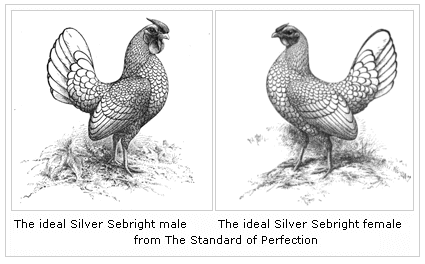 Wikipedia |
Wikipedia: [NAH]
[Extract somewhat edited for flow. Click link for greater detail - ed.]
The Sebright is a breed of chicken named after its developer, Sir John Saunders Sebright. Created in the 19th century through a selective breeding program designed to produce an ornamental breed, the Sebright is a true bantam, meaning it is a miniature bird with no corresponding large fowl to which it is related.
With the breed that carries his name, John Sebright intentionally set out to create a very small bantam chicken with laced plumage similar to the laced variety of Polish chickens... Today, the breed is one of the ten most popular bantam chickens, according to the American Bantam Association.
In addition to breeding chickens, cattle and other animals, Sir John wrote several influential pamphlets on animal keeping and breeding: The Art of Improving the Breeds of Domestic Animals (1809), Observations On Hawking (1826), and Observations upon the Instinct of Animals (1836).
Charles Darwin read Sir John's 1809 pamphlet, and was impressed with a passage that elaborated on how "the weak and the unhealthy do not live to propagate their infirmities". These writings... aided Darwin in the inception of Darwin's theory of natural selection...
...Sebrights are neither prolific egg layers, nor outstanding meat birds. They can be difficult to raise, especially for the beginner. Hens rarely go broody and chicks usually have high mortality rates. Adults are generally hardy birds, but are especially susceptible to Marek's disease. In temperament, Sebrights are friendly, but very active birds. Males are not known to be aggressive, but Sebrights in general are, like most small chickens, somewhat skittish birds. Due to their small size and relatively large wings, they are one of a minority of chicken breeds that retains a strong flying ability. Thus, most keepers keep Sebrights in confinement rather than allowing them to free range.
...As a largely ornamental chicken, they lay tiny, white eggs and are not kept for meat production.
My Pet Chicken: [NAH]
Well, aren't these little guys sweet! ... Sebrights are popular amongst poultry enthusiasts for their sweet nature and beautiful plumage.
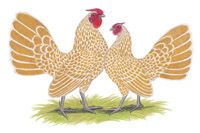
| Male Mature Weight: 22 oz |
| Female Mature Weight: 20 oz |
| Comb Type: Rose |
| Egg Color: White
Egg Size: "tiny" Rate of Lay: "Low" |
| Type: Meat - Laying - Dual-purpose - Other- Ornamental |
| Setting: Rarely |
| Disposition/Temperament: Friendly but can be skittish, and they fly well. Tolerate confinement |
| Climate Hardiness: All Climates, not winter-hardy [1], [2] |
| ALBC Priority: Watch |
| Show Class: Rose Comb Clean Legged Bantams |
Ideal Poultry Breeding Farms, Inc:
Although other breeders have produced Buff Sebright Bantams, Ideal Poultry has developed its own strain of this extremely rare variety. In 2001, Golden Sebright Bantams were crossed for several generations to Golden Sebright Bantams following selection for Sebright Bantam characteristics and buff laced plumage. Males and females have similar plumage patterns. Each feather, throughout the entire surface, is rich golden buff, laced with creamy white.
Standard weights at maturity are male-22 oz, and hen-20 oz.
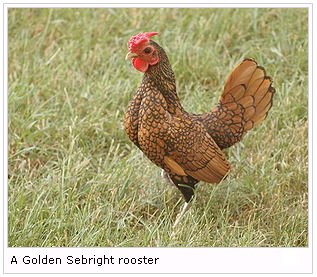 Wikipedia |
| Male Mature Weight: 22 oz |
| Female Mature Weight: 20 oz |
| Comb Type: Rose |
| Egg Color: White
Egg Size: "tiny" Rate of Lay: "Low" |
| Type: Meat - Laying - Dual-purpose - Other- Ornamental |
| Setting: Some, usually rarely |
| Disposition/Temperament: Friendly, but can be skittish, and they fly well. Tolerate confinement |
| Climate Hardiness: All Climates, not winter-hardy [1], [2] |
| ALBC Priority: Watch |
| Show Class: Rose Comb Clean Legged Bantams |
The sebrights, which originated in the early 1800's, have the unique distinction of being the only chicken that is "hen feathered." This means that the male, unlike other chickens, has no pointed sex feathers in the hackle, saddle, or tail. The sebrights are very small and are much in demand. The Goldens are golden bay and the Silvers are silver-white with both varieties having each feather laced in black.
Customer comments:
The golden sebright i bought from you was great she is SOOOOOOOOOOOOOOOOo beautiful
- - -
I was interested in these birds for their showy coloring, so I purchased two chicks. Now they are fully mature,
and I am delighted with the results. The hen is superb, having taken home several ribbons from local shows,
and the cock is very sociable and surprisingly unaggressive towards people. They both are friendly and
willingly eat out of my hand and allow themselves to be picked up. I am going to purchase several more
of these birds in hopes of creating my own small pure lined flock. The hen has even began sitting on her
eggs.
Originated in England in 1810 after 30 years of development by Sir John Sebright. This poultry breed is noted for lack of sickle feathers on the males (both rooster and hen have hen feathers). Also noted for the first specialty club organized (Sebright Bantam Club) in 1815. Admitted into the American Poultry Standard of Perfection in 1874.
Hen ................20 oz.
Rooster ..........22 oz.
Pullet ..............18 oz.
Cockerels ......20 oz.
Ideal Poultry Breeding Farms, Inc:
Golden Sebright Bantams have an alert, stylish, well-balanced appearance. The tails are full and well expanded while the large wings are hung low. Sebrights are the only breed that has males which are hen-feathered, which is the result of the action of the autosomal dominant sex-limited hen-feathered gene (Hf). The males do not have pointed hackle, saddle or tail sex feathers. All of the surface plumage is golden bay laced with a narrow edging of lustrous black.
Standard weights at maturity are male-22 oz, and hen-20 oz.
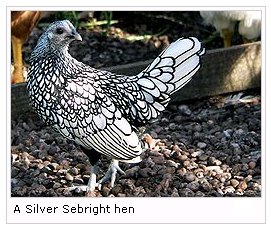 Wikipedia |
| Male Mature Weight: 22 oz |
| Female Mature Weight: 20 oz |
| Comb Type: Rose |
| Egg Color: White
Egg Size: "tiny" Rate of Lay: "Low" |
| Type: Meat - Laying - Dual-purpose - Other- Ornamental |
| Setting: Rarely |
| Disposition/Temperament: Friendly, but can be skittish, and they fly well. Tolerate confinement |
| Climate Hardiness: All Climates, not winter-hardy [1], [2] |
| ALBC Priority: Watch |
| Show Class: Rose Comb Clean Legged Bantams |
The sebrights, which originated in the early 1800's, have the unique distinction of being the only chicken that is "hen feathered." This means that the male, unlike other chickens, has no pointed sex feathers in the hackle, saddle, or tail. The sebrights are very small and are much in demand. The Goldens are golden bay and the Silvers are silver-white with both varieties having each feather laced in black.
Customer comments:
I have two Silver Seabrights and they are the best ones I have. The hen has excellent eggs and the rooster
is very friendly.
- - -
I have a silver sebright rooster and he is very gentle. He is my favorite of the flock, and he gets along
well around other roosters. Keep up the good work, Murray McMurray!
- - -
I purchased Silver Sebrights from McMurray. They started laying this week and have been amazing. I am
getting 4 eggs a day out of 5 hens. I was very shocked because the information I have read has said that
they are not good egg layers. Mine have started out wonderfully. I recommend these chickens to people
that fancy bantams.
Originated in England in 1810 after 30 years of development by Sir John Sebright. This poultry breed is noted for lack of sickle feathers on the males (both rooster and hen have hen feathers). Also noted for the first specialty club organized (Sebright Bantam Club) in 1815. Admitted into the American Poultry Standard of Perfection in 1874.
Hen ................20 oz.
Rooster ..........22 oz.
Pullet ..............18 oz.
Cockerels ......20 oz.
Ideal Poultry Breeding Farms, Inc:
Silver Sebright Bantams have an alert, stylish, well-balanced appearance. The tails are full and well expanded while the large wings are hung low. Sebrights are the only breed that has males which are hen-feathered, which is the result of the action of the autosomal dominant sex-limited hen-feathered gene (Hf). The males do not have pointed hackle, saddle or tail sex feathers. All of the surface plumage is silvery white laced with a narrow edging of lustrous black.
Standard weights at maturity are male-22 oz, and hen-20 oz.
Sex-links are cross-bred chickens whose color at hatching is differentiated by sex, thus making chick sexing an easier process. Sex-links come in many varieties, few of which are a true breed. As hybrids of laying or dual-purpose breeds infused with extra vigor via heterosis, sex-links can be extremely good egg-layers which often produce 300 eggs a year or more depending on the quality of care and feed.
Two common varieties are the Black sex-link (also called Black Stars) and the Red sex-link (also called Red Stars). Blacks are a cross between a Rhode Island Red or New Hampshire rooster and a Barred Rock hen. The Black Rock is another name for a black sex-link. Red sex-links are a cross between a Rhode Island Red or New Hampshire rooster and a White Rock, Silver Laced Wyandotte, Rhode Island White or Delaware hen. One example of a red linked breed is the Red Shaver. In Europe, the Cream Legbar (an actual true-breeding pure breed) and ISA Brown sex-links also exist.
Sex-links are a good choice for ensuring you receive only female hens for sure. Generally sex-links are considered to be a friendly breed if raised properly (like all chickens of course)
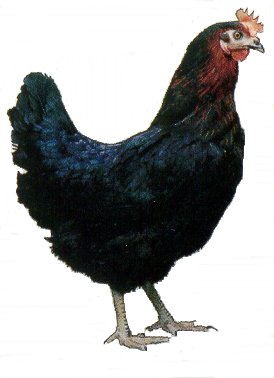
| Male Mature Weight: 8 lbs |
| Female Mature Weight: 6 lbs |
| Comb Type: Single |
| Egg Color: Brown
Egg Size: 26-27 Ounces/dozen Rate of Lay: "Excellent" |
| Type: Meat - Laying - Dual-purpose - Other |
| Setting: No |
| Disposition/Temperament: Friendly, docile, bear confinement well |
| Climate Hardiness: All Climates, Winter-hardy [1], [2] |
| Show Class: All Other Production |
["Black Stars"] We have finally found the sex link BROWN EGG LAYER that meets our strict specifications; easy to raise, lays large brown eggs, and has a good feed conversion ratio. A "sex-link" chicken is one, which at time of hatch, can be sexed by its color. BLACK STAR: A wonderful brown egg layer that will weigh a little over 5 lbs. The females are black with gold hackle and breast feathers and are egg laying machines. The males are black with white barring. (They will not retain the same characteristics in future generations.) Our customers have requested this bird and now we have it. Put a few Black Stars on your order, we’re sure you’ll be pleased.
Customer Comments:
As I write this my birds have been growing fast. They are about 11 weeks old, the Black Stars (as well
as the Red Stars)are hardy birds, good natured, and calm, they are good foragers and friendly. An attractive,
excellant pick for utility as a backyard chicken.
- - -
Bought 50 Red and Black Stars from your special last year. These are without a doubt the best layers I have
ever had. They are also the best chickens I have ever raised. They are easy-going and gentle.
- - -
I have two Black Stars, and they are the best. They started laying eggs on August 4,2003 and now we get one
egg from each every day. I am sure you will like these birds, not only are they good egg layers but they
are very friendly!
- - -
We ordered a few Black Stars to top off our order of chicks. Boy were we surprised when they started to
mature into really pretty hens. My son decided to take a trio to fair for the production class and won 3rd
place with his 12 week old chicks! They are the nicest layers we have, big clean brown eggs. We love them
and have ordered more this year. Thanks! Cheryl in MI.
- - -
We ordered our Black Stars at the end of March and were waiting to see how they would make the trip from the
hatchery to the Smoky Mountains. When they came, we promptly opened the box to check for casualties. There
were none, and to our delight, you sent extras along with our bonus Polish Crested who became Billy Ray.
The Black Stars are a delight. They have grown so quickly and absolutely no problems. They are extremely
friendly and do not frighten easily. We have taken delight in watching them grown and can't wait until the
eggs start coming. McMurray's is wonderful to do business with.
- - -
We ordered 25 Black Stars this year and they have been laying since they were 5 months old. We are now
getting aound 18-24 eggs a day and at 7 months old that is great. We really enjoy them as they are very friendly
and love to get extra treats!! Any one that likes big brown eggs and good layers need Black Stars! Thanks!!
- - -
Mcmurray hatchery has done a great job with all our birds! The black stars are great birds, our 2 though are
the curious, always getting into trouble, yet they come when called and they are the bossiest. My red stars on
the other hand love to stand on my shoulder and are the sweetest things. My black stars were curious, yet
never aggressive to humans. I suggest this breed 100 percent.
- - -
I have to say that I am very pleased with my shipment of 25 chicks. They arived right on time and are in great
condition, I will be ordering more soon.
- - -
I ordered 25 Black star chicks last May and was very very pleased when they arrived. None were ill, dead or
even damaged. They grew very well and were good natured all the way. They started laying at about 6 months
and I had more eggs than my son could carry. They are very friendly and most of them like human touch.
Production is off right now not sure why but I am not worried they will be back just as strong as before.
Anyway kudos to all the staff at McMurrays for a job well done and I will be ordering more.
- - -
Hello! I just wanted to take the time to comment on the Black Star. I have one who is now two years old
named Beamer. I grew up with chickens as pets, but she is truly unique! She follows me everywhere, comes when
I call her and even sits on my lap. I would recommend this breed to anyone interested in raising a great pet.
She's also a terrific egg-layer, which is a plus! Katie Glassmoyer Greenville, SC
- - -
Your Red and Black Stars are the best choices I could have made. They have proven to be every bit the
"egg machines" you say. Folks who buy the eggs are more than satisfied with size and taste. One neighbor
purchased some "store" eggs when I was away on vacation and said "they tasted lousy." "I could use a couple
dozen of those good eggs." Nuff said!! Ms. Sandy Clark Chester, NH
- - -
I have both the black star and red star. They are truly the best egg layers I have ever seen, and we have
raised chickens for more than 35 years.
["Black Sex Links"]: The Sex Link Hybrid is the result of crossing two purebred standard breeds. The Rhode Island Red rooster and the Barred Rock hen. The baby Chicks are color sexed- males faded barred with light colored neck feathers , pullets are black with red mixed in their neck hackle feathers. This hybrid makes for very vigorous chicks, rugged brown egg laying hens and good cockerel fryers.
Hen -------6 - 7 lbs
Rooster----8 - 9 lbs
Pullet------6 lbs
Cockerel--8 lbs
Ideal Poultry Breeding Farms, Inc:
["Black Sex Links"]: An outstanding color-sexing breed, cross of Rhode Island Reds x Barred Plymouth Rock that has been bred for high, efficient egg production and excellent livability.
Black Sex Links are a breed cross using Rhode Island Red males and Barred Plymouth Rock females. The male chicks have a white spot on the top of their heads and can be separated from the solid black female chicks when they hatch. This cross, which is used in commercial layer operations, is an efficient producer of large brown eggs. They have excellent livability, and hens from this cross weigh about 5 1/2 lbs. and can be salvaged for fowl meat when their use for laying is over.
Mature males will weigh approximately 9 lbs.
Black sex links are a cross breed derived from a male Rhode Island Red and a female Barred Plymouth Rock. They are easily sexed at hatching because the males are barred (black and white) and females are solid black, making them a favorite among most commrcial breeders. They are an excellent egg layer, as this breed has a potential to produce over 250 eggs annually.
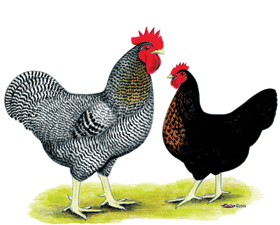 Comb: Single
Comb: Single
Standard weight at maturity: Hens 5 1/2, males 8 1/2 lbs.
Egg color: Brown
My Pet Chicken: [NAH]
Stars are "sex link" chickens, meaning they're bred specifically so that males and females are different colors when they hatch. Females are egg-laying machines that continue to lay well in the heat and cold, when many others slow down. The males are said to be good "fryers". Stars ... are just one of many hybrid sex-link crosses available on the market today.
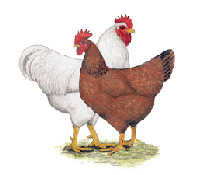
| Male Mature Weight: 8 lbs |
| Female Mature Weight: 5.5 lbs |
| Comb Type: Single |
| Egg Color: Brown
Egg Size: 26-27 Ounces/dozen Rate of Lay: "Excellent" |
| Type: Meat - Laying, some meat - Dual-purpose - Other |
| Setting: [Unknown] |
| Disposition/Temperament: [Unknown] |
| Show Class: All Other Production |
Ideal Poultry Breeding Farms, Inc:
An outstanding color-sexing breed cross of Rhode Island Reds x White Plymouth Rocks that has been bred for high, efficient egg production and excellent livability.
Brown Sex Links are a breed cross using Rhode Island Red males and silver factor White Rock females. The chicks can be separated by sex at the time of hatching since the females are primarily red and the males are primarily white. Commercial producers of brown eggs sometimes use this cross, which has excellent livability and efficiently produces large brown eggs. Hens from this cross weigh about 5 1/2 lbs. and can be salvaged for fowl meat when their use for laying is over.
Mature males will weigh approximately 8 lbs.
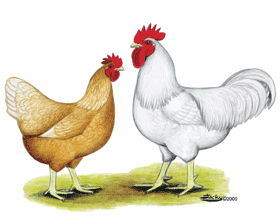
| Male Mature Weight: 8 lbs |
| Female Mature Weight: 5.5 lbs |
| Comb Type: Single |
| Egg Color: Brown
Egg Size: 26-27 Ounces/dozen Rate of Lay: "Excellent" |
| Type: Meat - Laying, some meat - Dual-purpose - Other |
| Setting: [Unknown] |
| Disposition/Temperament: [Unknown] |
| Show Class: All Other Production |
Ideal Poultry Breeding Farms, Inc:
An outstanding color-sexing breed cross of Rhode Island Reds x Rhode Island Whites that has been bred for high, efficient egg production and excellent livability.
Gold Sex Links are a breed cross using Rhode Island Red males and Rhode Island White females. The female chicks are streaked with red or gold and can be separated from the solid white male chicks at one day old. This cross, which is one of the most popular used in commercial layer operations, is an efficient producer of large brown eggs. This outstanding cross has excellent livability, and mature hens, which weigh 5 1/2 lbs. can be salvaged for fowl meat when their use for laying is over.
Mature males will weigh approximately 8 lbs.
Gold Sex Links are developed by crossing Rhode Island Red males and Rhode Island White females. The female chicks are striped with red or gold while the males are solid white, which makes this breed easy to sex. Gold Sex Links are used in many commercial layer operations because they are an extremely hardy breed, and are very efficient producers of large eggs.
Comb: Single.
Standard weight at maturity: Hens 5 1/2 lbs, males 8 lbs.
Egg Color: Brown.
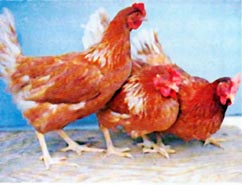
| Male Mature Weight: 7-8 lbs |
| Female Mature Weight: 5-6 lbs |
| Comb Type: Single |
| Egg Color: Brown
Rate of Lay: high |
| Type: Meat - Laying - Dual-purpose - Other |
[May be the same as the Gold Sex Link; also resembles the
Hubbard ISA Brown as you can see.]
The Golden Comets are one of three Modern Day Brown egg laying strains from hybrid breeding that produce fast
body development and fast egg production. These strains will start to lay eggs at a younger age than most
standard breeds and produce big brown eggs. They are also color sexable as chicks, cockerels are white,
and the pullets are more brownish red in color. You are sure to be pleased with any one of the three we offer.
Hen -----5 - 6 lbs
Rooster--7 - 8 lbs
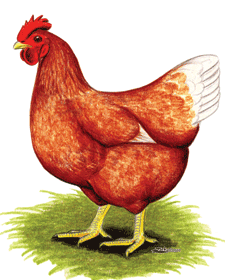
| Male Mature Weight: 5 ½ lbs |
| Female Mature Weight: 5 ½ lbs |
| Comb Type: Single |
| Egg Color: Brown
Egg Size: 'Large' to 'Extra-large' Rate of Lay: 300/year (first year of laying) |
| Type: Meat - Laying - Dual-purpose - Other |
| Setting: [Unknown] |
| Disposition/Temperament: Friendly, can be "pecky" when older |
The Hubbard Isa Browns hold about 60% of the world's brown egg market. All other brown egg laying breeds are judged and compared to these. They offer you exceptional egg output, resulting in low feed conversion. Bred for large egg size, the in-built adaptability allows them to produce a large and extra large egg size from 62 to 65 grams. Isa Browns have a current livability of 97.3% and hen housed average production to 76 weeks is 321 eggs.
Standard weight at maturity: Hens 5 ½ lbs.
Egg color: Brown
Wikipedia: [NAH]
The ISA Brown is a hybrid type of Sex Link chicken, which is the result of crossing Rhode Island Reds and Rhode Island Whites. The ISA Brown is a hybrid, not a true breed. It is known for its high egg production of approximately 300 eggs per hen in the first year of laying.
ISA stands for Institut de Sélection Animale, the company which developed the breed in 1978 for egg production as a battery hen. In 1997, the ISA Group merged with Merck & Co., forming Hubbard ISA, so the breed is sometimes called Hubbard Isa Brown...
The cross is a friendly pet, very confident and not afraid to go first but when it gets older it becomes a little bit pecky...
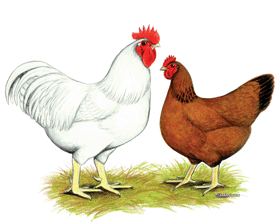
| Male Mature Weight: 8 lbs |
| Female Mature Weight: 6 lbs |
| Comb Type: Single |
| Egg Color: Brown
Egg Size: 26-27 Ounces/dozen Rate of Lay: "Excellent" |
| Type: Meat - Laying - Dual-purpose - Other |
| Setting: No |
| Disposition/Temperament: Friendly, docile, bear confinement well |
| Climate Hardiness: All Climates, Winter-hardy [1], [2] |
| Show Class: All Other Production |
["Red Star"] We have finally found the sex link BROWN EGG LAYER that meets our strict specifications; easy to raise, lays large brown eggs, and has a good feed conversion ratio. A "sex-link" chicken is one, which at time of hatch, can be sexed by its color. RED STAR: These hens will mature with feathers that are reddish brown with flecks of white throughout. The males are all white with nice yellow skin. (They will not retain the same characteristics in future generations.) At approximately 22 weeks these hens will start to lay and lay they will. We're sure this hardy bird will become a favorite of yours as it lays eggs right through hot or cold weather. No wonder it's called the Red Star.
Customer Comments:
I have several types of egg layers, but the Red Star are the best I have ever seen.We had a cold and
snowy winter,but these birds laid great all winter. When someone ask me what I recommend for brown
eggs,it's Red Star. Thanks McMurray for the great chickens!
- - -
I have several different breeds of chickens, but after ordering my Red Stars last year I am thinning my
flock to just Red Stars. They are the gentliest chickens I have ever seen. Everyone that buys my eggs
request eggs from them, they are by far the biggest and the best. Thank you so much for these wonderful birds.
- - -
This is my first season with my Red Stars and I am so impressed that by next year my whole flock will
be Red Stars. Its very hot here in Texas and those girls of mine keep laying. I am looking into maybe
ordering the Black Stars now. I know I wont be disappointed. Thank you for introducing me to the Stars.
- - -
I love my Red Stars from the first day I got them. They are so friendly and lay very good brown eggs.
- - -
I have a flock of Red Star and they are the best chickens. My Red Stars started to lay at 18 weeks
and lay they are. You were not kidding when you said they were "Great" egg layers.I look foward to
doing buisness with McMurray hatchery you guy's are simply the best.
- - -
We purchased Red Stars on my mom's recommendation 2 years ago. We live at 8900 ft. elevation in the
Colorado Mountains. Even in the winter, we still averaged 9-10 eggs a day with 13 chickens. Now if they
could only be hardy enough to survive a bear attack!! After rebuilding the pen and coop--We are ordering
Red Stars again.
- - -
I received my order of laying chicks right after Memorial Day this year and already at 17 weeks, my
3 Red Stars are laying eggs, everyday! I ordered 3 other breeds of egg layers, too, but I wish I would
have ordered more Red Stars. They are wonderful layers and are very quiet with nice dispositions.
A wonderful chicken, my next order will have many more Red Stars.
- - -
I received Red Star Roosters as a extra to keep my Dominiques warm in shipping . I love them they are
so friendly ,they come when they see me and will perch on my hand. Thanks for such a special surprise.
- - -
I wish I had ordered more than one Red Star!! She is by far the best layer in my flock, and even out
does my Pearl Whites. "Rachel" has been so successful that I am planning to order more Red Stars and
to try some Black Stars too. Thanks, Murray McMurray for my great brown egg layer.
- - -
I ordered 25 baby chicks- half red star and half black star. You guys were so friendly and helpful when
my order was delayed due to Memorial day and when I called like 3 times, the ladies I spoke to were so
sweet! The Red star chicks are so sweet and more calm than the black...
- - -
Hello, I just wanted to say how happy I am with the Red Star roosters you included in my order this spring
as "warmer chicks"! They grew very quickly on little feed, and are among the most independent and fearless
chickens we own. They are also the last ones to get caught by predators, yet are docile to work with.
In short, they were a very pleasant free surprise! Thank you
- - -
EXTRAORDINARY LAYERS; I wish I had ordered more red stars, they are my favorite dual purpose bird.
- - -
My wife and I ordered Red Star chicks last Spring and they are everything - and more- than you said.
Some began laying at 16 wks and all were by 20 wks old. We have other types of chickens and the Red Stars
are the gentlest and best layers we have -even in winter! ...
- - -
You really can't beat these Red Stars. Wonderful temperaments These hens lay all winter and follow us
everywhere. Soooo friendly,
- - -
Last year was our first time having chickens, when we got six red and 6 black stars and few male reds
thrown in. We loved their sweet and sometimes curious personality. They are very good layers and you'll
be amazed when you find that some of the eggs won't fit in the jumbo cartons. They also don't mind be held,
or making a few friends like my favorite one did. But they do like to scratch and play in mulch and could
eat a cow-:). All in all we made sure to get some this year, rather than more blacks. The only other downer
is that the males are aggressive...
- - -
Red Stars are one of the best tempermented hens I've ever had. They lay very well. Also, the most gentle
ones will "talk" to you. They are also very vigorous and cold hardy. We live in a very cold area (gets
down to -50F) here, they have done beautifully. I would recommend this sex-link breed to anyone. S.
Reiley, Theresa, NY
- - -
These are the best hens ever! They lay delicious eggs, they are super friendly & have the best
personalities & are so beautiful! We ordered two & they are so sweet, love being held and I couldn't imagine
life without them!!! You can't go wrong!
- - -
McMurray Hatchery has given us a very positive experience as first time chicken raisers. The Red Star chicks
we ordered arrived healthy and hungry. They are very sturdy birds. The hens are now grown up and are so
gentle, friendly and terrific layers. They all started laying at about 20-21 weeks old and we almost always
get one egg per hen each day. (And the temperatures this winter have been below freezing!) We love the
fresh eggs and we love our little flock of hens, they are wonderful!
- - -
A very hardy chick! excellent bird
- - -
First - I'm not un-biased - I wrote the McMurray website because our family loves to raise chickens. Red Stars are about
our favorites. We bought some last year and raised them up to be 6 months old and then sold every one. This year we bought
some to keep. They have become our grasshopper control in the orchard. Everytime I walk out there - they come up to me and
then walk with me through the orchard. They are very sweet in disposition - I've never seen an aggresive one - unless
you happen to be a grasshopper.
Joe Claborn, Ross, TX
- - -
I have ordered all my chickens from your hatchery and most recently tried the Red Star breed. They are
the nicest chickens YET! Friendly and easy going...they are great layers and would make great pets! The
breeding mix on these chickens really does them justice...someone had a great idea!
The Red Star Sex Links are one of three Modern Day Brown egg laying strains from hybrid breeding that produce fast body development and fast egg production. These strains will start to lay eggs at a younger age than most standard breeds and produce big brown eggs. They are also color sexable as chicks, cockerels are white, and the pullets are more brownish red in color. You are sure to be pleased with any one of the three we offer.
Hen ------5-6 lbs
Rooster --7-8 lbs
The Red Sex Link Hybrid is the result of crossing the pure Rhode Island Red rooster with a Delaware hen. The results are a color sexed chick and chick offspring of vigor and health. The cockerels are shades of light colors and the pullets are shades of reds. Excellent brown egg layers for the family to enjoy.
Hens--------6 - 7 lbs
Roosters----8 - 9 lbs
Pullets------6 lbs
Cockerels--8 lbs
Ideal Poultry Breeding Farms, Inc:
["Red Sex Links"]: An outstanding color-sexing cross of Rhode Island Reds x Delawares that has been bred for high, efficient egg production and excellent livability.
Red Sex Links are a breed cross using Rhode Island Red males and Delaware females. The females are primarily red while the males are primarily white; therefore, the sexes can be separated immediately following hatching. This layer is used in many commercial layer operations. They have excellent livability, and are very efficient producers of large brown eggs. Mature hens will weigh about 5 1/2 lbs. and can be salvaged for fowl meat when their use for laying is over.
Mature males will weigh approximately 8 lbs.
Red Sex Links are developed by crossing Rhode Island Red males and Delaware females. The female chicks are usually red, while the males are solid white, which makes this breed easy to sex. Red Sex Links are used in many commercial layer operations because they are an extremely hardy breed, and are very efficient producers of large eggs. Red Sex Links are considered a good dual purpose breed.
Comb: Single.
Standard weight at maturity: Hens 5 1/2 lbs.
Egg Color: Brown
My Pet Chicken: [NAH]
Stars are "sex link" chickens, meaning they're bred specifically so that males and females are different colors when they hatch. Females are egg-laying machines that continue to lay well in the heat and cold, when many others slow down. The males are said to be good "fryers". Stars ... are just one of many hybrid sex-link crosses available on the market today.
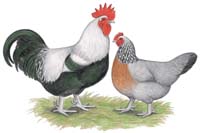 |
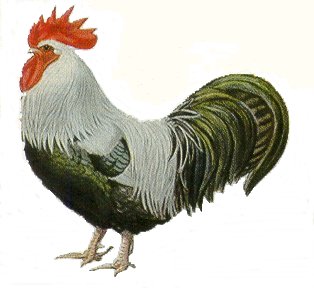 |
| Male Mature Weight: 9 lbs |
| Female Mature Weight: 7 lbs |
| Comb Type: Single |
| Egg Color: Tinted & White
Egg Size: "Large" Rate of Lay: "Medium" |
| Type: Meat - Laying - Dual-purpose - Other |
| Setting: Yes, sometimes militantly |
| Disposition/Temperament: Gentle, good mothers, bear confinement well |
| Climate Hardiness: All Climates, Winter-hardy [1], [2] |
| ALBC Priority: Threatened |
| Show Class: English |
This is a very old breed known even to the ancient Romans and introduced by them to Britain. Characteristics are the color combination of silvery white and black for males and white and ashy gray for females. Both sexes have a 5th toe, and a long body on short legs.
Customer comments:
I got some silver Grey Dorkings and they are the most wonderful birds! They have a very gentle
temperment and the females are great mommys to the babys! I would definitly recommend Silver Grey Dorkings!
Especially if they are looking for birds who are calm and want the hens to hatch out a few babys for them.
Justine Norquist, Sandy, OR
Ideal Poultry Breeding Farms, Inc:
Silver-Gray Dorkings are the best known variety of Dorkings, which is one of the most ancient of all domestic breeds of poultry. They are unique in that they are one of only a few breeds with five toes on each foot. They have very short thighs and shanks; therefore, they appear to be a squatty bird. Ideal is one of only a few hatcheries to breed this rare variety which lay tinted eggs.
Standard weights at maturity are males-9 lbs. and hens-7 lbs.
Wikipedia: [NAH]
...The Dorking has a rectangular body with very short, five-toed legs. Due to its relatively large comb it generally requires protection in cold weather. Dorkings are also well known for their versatility as a breed for both egg and meat production. It is one of the few breeds with red earlobes that produces a white-shelled egg. The skin colour beneath the feathers is white. The standard weight is 9 pounds for a cock, 8 pounds for a cockerel, 7 pounds for a hen, and 6 pounds for a pullet. Furthermore, the breed is very docile. The bird has five recognized varieties: White, Silver-grey, Red, Dark and Cuckoo.
They are noted for being exceptionally broody at times in entire flocks refusing to lay and preferring to set on eggs to incubate them.
U of OK: [NAH]
Use: A good, general purpose fowl for producing meat and eggs. It was developed for its especially fine quality meat. Origin: The Dorking is believed to have originated in Italy, having been introduced into Great Britain at an early date by the Romans. Much of its development took place in England where it gained much acclaim for its table qualities. The Dorking is one of our oldest breeds of chickens...
My Pet Chicken: [NAH]
Dorkings are a very special -- and very endangered -- breed. They're one of the oldest known breeds of chicken domesticated for human use (reportedly having been developed during the Roman empire), as evidenced by their 5 toes instead of the usual 4. They're also the only breed with a red earlobe to lay a white egg! Compared to other breeds of chicken, Dorkings also have unusually short legs. Dorkings are exceptionally sweet birds and they need the support of small backyard flock owners to ensure their continued existence.
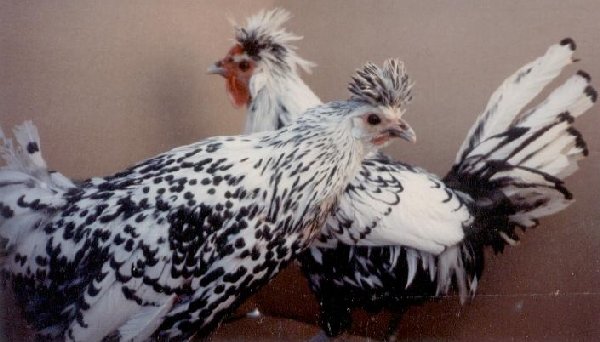
Cackle Hatchery Notice the resemblance to the Brabanter. |
| Male Mature Weight: 5.5 lbs |
| Female Mature Weight: 4 lbs |
| Comb Type: V or Horn, with crest |
| Egg Color: White
Egg Size: "Medium" Rate of Lay: ~3/week |
| Type: Meat - Laying - Dual-purpose - Other |
| Setting: "Seldom" |
| Disposition/Temperament: "Flighty", active, intolerant of confinement, like to roost in trees |
| Climate Hardiness: All Climates, Mountains, Winter-hardy [1], [2] |
The Silver Spangled Spitzhauben chicken also known as Appenzeller Spitzhauben, originated in Switzerland, and is their national bird. This chicken is very rare to the United States and not yet admitted to the American Standard of Perfection. Noted characteristics are cavernous nostrils, horn type comb and mid size head crest.
Hen---------4 lbs
Rooster-----5 lbs
Pullet-------4 lbs
Cockerel---5 lbs
Ideal Poultry Breeding Farms, Inc:
Silver Spangled Spitzhaubens, which are sometimes called Appenzeller Spitzhaubens, originated in Switzerland. Although they are efficient producers of white eggs, they are kept primarily for their unique appearance. They are listed in the British Poultry Standards but have not yet been admitted to the American Standard of Perfection. This very rare variety is uniquely characterized by having strong cavernous nostrils, a horn type comb and a medium sized pointed crest that is bent forward.
Standard weights at maturity are males-5 1/2 lbs. and hens-4 lbs.
Wikipedia: [NAH]
The Appenzeller is a breed of chicken originating in the Appenzell region of Switzerland. The Appenzeller comes in two varieties. The Spitzhauben, meaning "pointed hood", has a V-comb and feather crests in males and females. The Barthuhner ("bearded hen") has a rose comb and no crest. Both types appear in either black, golden spangled and silver spangled plumage.
Today the breed is largely an ornamental one kept for showing, but it lays also a respectable quantity of white eggs. It is a light chicken, with hens weighing an average of 3.5 lbs (1.6 kg) and roosters 4.5 lbs (2 kg). Behaviorally, it is a flighty breed that doesn't do well in confinement, can forage well, and will roost in trees if given the opportunity. In North America, it is very rare and is recognized officially by neither the American Poultry Association or other breed registries. The silver spangled Spitzhauben is the most common variety found abroad.
My Pet Chicken: [NAH]
The Appenzeller Spithauben is the national breed of Switzerland, noted for its very unusual forward-pointing crest and v-shaped comb. These birds are well-adapted to life in the mountains, are excellent climbers and love to roost in trees. They really don't do well in confinement, so don't keep them unless they can be allowed to roam freely throughout the day.
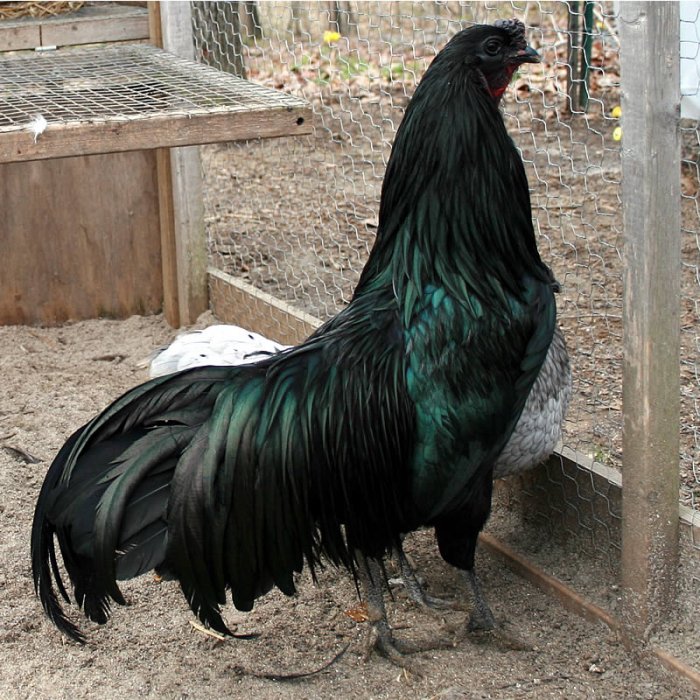 Backyard Chickens.com, see also narrative page |
| Male Mature Weight: 5 lbs |
| Female Mature Weight: 4 lbs |
| Comb Type: Pea |
| Egg Color: White
Egg Size: "medium-sized" Rate of Lay: 100-130/yr |
| Type: Meat - Laying - Dual-purpose - Other- Bug-hunters |
| Setting: Yes |
| Disposition/Temperament: Friendly, gentle with other chickens, intolerant of confinement, can be fierce |
| Climate Hardiness: All Climates - Heat, Winter-hardy [1], [2] |
| ALBC Priority: Critical |
| Show Class: All Other Standard |
This breed came from the island of Sumatra in far off southeast Asia. It is a graceful, longtailed fowl with lustrous greenish-black plumage throughout, small comb and wattles, very rare and beautiful.
[Based on the customer comments, these birds would be good in hot regions and rough areas]
Customer comments:
I LOVE these little hens. They are the friendliest chickens I've ever owned. At 3 weeks they fly up on my
arm everytime I go to the pen. They are also very vigorous and don't pick on my bantams and crested like
some of my larger breeds.
- - -
The 5 Sumatra chicks I recieved didn't even look like peeps. They are so colored that the children around
here thought they looked more like baby ducks and geese. These passively acting chicks are sure to be a
barn favorite for the kids to interact with. A wonderfull addition to our flock!
- - -
I ordered five of these little darlings about 9 months ago! They are great with other chickens and never
pick on any of them. They are very friendly towards humans too! I get eggs daily and right now two of my
hens are broody! I have one rooster that protects them with his life. Thanks Mcmurray Hatchery!
- - -
Whike living in the Arizona Sonoran desert, I had a problem with scorpions until a friend gave me a rooster
and 6 Sumatra hens which proceeded to rid my property of the scorpions. I'd turn a bale of staw with my
pitch fork and the Sumtras would be waiting until the scorpions were exposed and pounced on them and ate
them with a smile like thanks dad. They also snatchd up baby rattlesnakes and all the Geckos they could eat.
Great birds and loved them around.
- - -
I have one blue rooster (Sweety) and black hen (Pie). They are almost extinct in North America. I am hoping
to breed and win best in show at my state fair. I encourage anyone to buy or breed them.
The Black Sumatra came from the Island of Sumatra which is in far southeast Asia. This is a fowl of graceful form and has a long flowing tail with lustrous greenish black plumage. Noted for multiple spurs that appear on the males and black skin. This breed was admitted into the American Standard of Perfection in 1883.
The Blue Sumatra can come in different shades of blue, dark blue/black and splash. The Blue Sumatra photos as shown are the blue color you want to select out of your entire flock to show... This is a very rare breed and will attract a lot of attention at poultry shows.
Hen -------- 4 lbs
Rooster------5 lbs
Pullet --------3 1/2 lbs
Cockerels---4 lbs
Ideal Poultry Breeding Farms, Inc:
Black Sumatras are native to Sumatra and are still as pure blooded today as when first discovered on that Island in Indonesia. They have a graceful form and distinct carriage, with rich lustrous, greenish black plumage throughout. The male's particular characteristic is the flowing tail, which has an abundance of long sweeping sickles and coverts. They lay medium sized eggs and are one of only a few breeds that do not have enamel white earlobes that lay either tinted or white eggs.
Without specific, individual management, such as correct lighting and heating, growers should not expect the male's tails to reach the extremely long lengths. Ideal's Sumatras will have tails the length shown on our pictures without special attention.
Standard weights at maturity are males-5 lbs. and hens-4 lbs.
Black Sumatras originated in Sumatra, Indonesia and are one of the oldest breeds in America. Imported into the United States in 1847, they were admitted into the American Standard of Perfection in 1883. They are regarded as a highly decorative fowl celebrated for their radiant greenish-black plumage and long flowing tail. They have little or no wattles, and males have a cluster of spurs on their legs.
Comb: Pea.
Standard weight at maturity: Hens 4 lbs, males 5 lbs.
Egg color: White
Wikipedia: (NAH)
The Sumatra is a breed of chicken native of the island of Sumatra. Chickens were originally imported from Sumatra in 1847 to the U.S. and Europe for the purpose of cockfighting, but today the breed is primarily kept for exhibition. 1883 is the year the Black Sumatra was first inducted into the American Standard of Perfection.
Black Sumatras are pitch black with a green sheen throughout the body and tail. Black is the most common variety, but it additionally comes in blue and white varieties. Males usually weigh between 4 and 5 pounds, and females weigh between 3 1/2 and 4 pounds. Hens lay about 100 white eggs a year. Both males and females have no wattles, and males often have multiple spurs. The breed is considered a primitive one; the Sumatra retains a strong flying ability, unlike most modern chicken breeds. The males will fight for dominance, but unlike most breeds, these do not [normally] fight to the death, but some are just stubborn and they actually will fight to the death.
MyPetChicken.com: (NAH)
Sumatras are an exceedingly rare breed of chicken with a personality closer to that of a wild game bird than a domestic chicken: they are thought to be closely related to the jungle fowl of the Far East. They have been known variously as "Sumatran Pheasants" or "Java Pheasant Game Birds," even though they are most definitely chickens! Their unique carriage, with their sweeping tails held low, gives them the air of a pheasant or peacock, however. Sumatras make great show birds, and they're usually kept for their beauty alone. This is no surprise, because they're usually poor layers and they aren't hefty enough to be a good meat bird. You can see from the photos that their shiny, lustrous feathers are striking, but in addition they're the only breed of chicken whose roosters have multiple spurs! Like the Silkie, they also have black skin and black bones.
They are hardy in winter and intolerant of confinement.
Poultry Pages: (NAH)
The Black Sumatra fowl is a native of Sumatra, and, as far as known, is as pure blooded today as when first introduced in to America from Angers Point Sumatra in 1847. At this time they came under various names Sumatra Pheasant game, Sumatra Ebon Game and Java Pheasant Game. Because of its double spurs, it was desirable for cockfighting purposes. However, because of poor timing, it arrived in England at about the same time that legal cockfighting was abolished. It is believed that this breed would have become very popular if this law had not been enacted. The breed was admitted into the American standards as early as 1883. They were brought into Britain in 1902 by Frederick R Eaton of Norwich.
This is a fowl of graceful form and distinct carriage, with the richest of lustrous, greenish black plumage throughout. Its particular characteristic is the long flowing tail of the male, which has an abundance of long sweeping sickles and coverts. Multiple spurs are often found on males. Other characteristics are length and breadth of feather, extremely lustrous, greenish black plumage color and practically no wattle development. The females make excellent broodies.
BackyardChickens.com: [NAH]
"...The Sumatra has a personality closer to that of a wild game bird than a domestic chicken. The male has a graceful carriage and lustrous greenish black feathers and long sweeping tail, which has an abundance of long sweeping sickles and coverts, carried horizontally (females tail carriage 15 degrees above horizontal). Multiple spurs on males are desired as well as practically no wattle development. Sumatra has yellow skin.[?] They are fair layers of medium size white or light tint egg.
"If you are interested in getting into long tail chickens I think the Sumatra is a good choice because they are relatively easy keepers. Sumatras are beautiful chickens with their flowing tails. They have a call that can be almost jungle like. They have a cantankerous personality. The more space you can give your Sumatra the happier he will be. They do not like close confinement. They prefer to roost as high as they can get.
"Four week old chicks will fly 6 feet high. If you do not want to be out in the dark with flashlight and ladder getting your chickens out of a tree please do not free range your Sumatras until they have learned that home is the coop. In my experience hens do not go broody until second year but then were frequent broodies. Both hen and rooster are doting parents and fierce in protecting their young..." - mschickychick
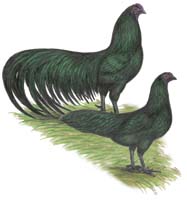
| Male Mature Weight: 40 oz |
| Female Mature Weight: 32 oz |
| Comb Type: Pea |
| Egg Color: White
Egg Size: Very small Rate of Lay: [Probably under 130/yr] |
| Type: Meat - Laying - Dual-purpose - Other- bug-hunter |
| Setting: Yes |
| Disposition/Temperament: Friendly to humans |
| ALBC Priority: Critical |
Ideal Poultry Breeding Farms, Inc:
Black Sumatra Bantams are minature Black Sumatras which are naive to Sumatra and are still as pure blooded today as when they were first discovered on that island in Indonesia. They have a graceful form and distinct carriage with rich lustrous, greenish black plumage throughout. The male's particular characteristic is the flowing tail, which has an abundance of long sweeping sickles and coverts. Bantam Black Sumatras are extremely rare. Since 1999 Ideal has been in the process of developing this bantam breed from original standard Black Sumatra stock.
Standard weight at maturity are male-40 oz. and hen-32 oz.
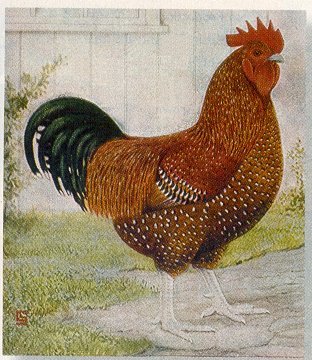
| Male Mature Weight: 9 lbs |
| Female Mature Weight: 7 lbs |
| Comb Type: Single |
| Egg Color: Light brown or tinted
Egg Size: 25-26 Ounces/dozen Rate of Lay: "Good", ~4/week |
| Type: Meat - Laying - Dual-purpose - Other |
| Setting: Some |
| Disposition/Temperament: Friendly, quiet, good with kids, bears confinement well |
| Climate Hardiness: All Climates, Winter-hardy [1], [2] |
| ALBC Priority: Recovering |
| Show Class: English |
The Speckled Sussex was developed in Sussex County, England over 100 years ago. It was famous there as a table fowl with pinkish white skin and long, deep body ideal for fattening. It is of medium size, in the heavy breed class, a layer of light brown or tinted eggs, and the hens will set. Its plumage color is a delight to the eye being of rich mahogany base color with individual feathers ending in a white tip separated from the rest of the feathers by a black bar. Baby chicks vary greatly in color from a creamy buff to dark chestnut and some also have alternate dark and light stripes lengthwise on the back. This variety combines beauty with utility, and is very nice to raise for showing.
Customer comments:
I love my Speckled Sussex I received from Murray McMurray in June 03! This is my first try at
keeping chickens and these are my favorite out of a variety I picked. They are friendly,
curious, beautiful, and great foragers. (I even like the rooster I ended up with.) I would
definitely order more of them.
- - -
My Speckled Sussex rooster is now 2 & half years old. And the beauty of this breed truely does
get better with age. The feed to meat/egg conversion is excellent and the plumage is superb
for avoiding predators. This is truely an ideal chicken for the homestead.
- - -
My first order of chicks from you (Speckled Sussex) arrived three weeks ago, and all are still
active, healthy, and growing like crazy. Great product... Thanks, I'll be back....
- - -
I am very happy with my 2 year old birds I bought from McMurray. They are great layers of medium
sized eggs. I can't get over how friendly they are even with two roosters. My 15 month old son
can follow them around without fear of their reaction.
- - -
Dear McMurray Hatchery, I am 11 years old. Two years ago, I ordered 30 chicks, including 5 Speckled
Sussex. These hens have now become my favorite breed! They are intelligent, beautiful, bursting
with personality, and the friendliest chickens I have ever had the pleasure of meeting! Also, they
lay fantastic eggs. I advise all buyers of McMurray chicks to include some of these superior poultry
in their order. -Rachel,Marietta, OK
- - -
The speckled sussex that we ordered are a real joy to be around. They are so friendly and will hop
up onto our backs when we are doing "chicken Chores." Very pretty and interesting birds. Thanks to
our experiences with McMurray Hatchery, chickens have replaced horses as our favorite farm animals
around here.
- - -
My Speckled Sussex arrived on April 2nd, 2001, four among a larger order of other breeds. They are
stunning in their coloration and do not stand out in advertisement for hawks. I am an aviculturist
and feel that these chickens are a treat. The rooster is an excellent lawn supervisor, protecting
what is his without being aggressive and the girls lay beautiful large brown eggs. They are also
a most terrific pet: they like being handled and will walk up and knock on the back door for entry
to the house!Carolyn WashkoThornhurst, PA
This chicken originated in the county of Sussex and is a very old English breed. The Speckled Sussex chicken was recognized as a distinct breed in 1914. The Sussex is a very gentle and colorful bird. This variety of the Sussex breed makes for a good backyard chicken and dual purpose for meat or egg production.
Ideal Poultry Breeding Farms, Inc:
A medium sized bird with a quiet disposition. The color of the plumage is distinct, unique and beautiful.
Speckled Sussex is the most popular variety of Sussex, which originated in Sussex County England and was bred for table poultry. They are very rare, docile, unique and attractive. Most of the feathers are mahogany bay, tipped with a small V-shaped white spangle. The male's tail feathers are lustrous, greenish black tipped with white. They produce medium sized brown eggs and are known as one of the most prolific brown egg layers.
Standard weights at maturity are males-9 lbs. and hens-7 lbs.
Speckled Sussex are a very popular variety of Sussex, which originated in Sussex County, England in the 1800's, bred for table fowl. Most of the feathers are a rich mahogany, tipped with a small V-shaped white spangle. A beautiful breed of poultry to raise for show, but because of they are regarded as a very prolific egg layer, they make a great dual purpose breed.
Comb: Single.
Standard weight at maturity: Hens 7 lbs, males 9 lbs.
Egg color: Brown
My Pet Chicken: [NAH]
The Sussex have everything: they are great layers of tinted or light brown eggs--and they lay right through the coldest weather. They are dual purpose birds, though: fat-bodied and not prone to flying when mature, so they are easily fenced. In England, they used to be THE standard table bird, before the modern Cornish Crosses came along. They forage well and are economical eaters that are friendly and easily handled. Their curious nature means they will often follow you around the yard if they think they can beg a treat from you. The "speckled" variety has plumage that gives them some camouflage from predators, too. Many tend to get more speckles after each successive molt, so they just get prettier with age. Seriously, what more could you ask for in a chicken?
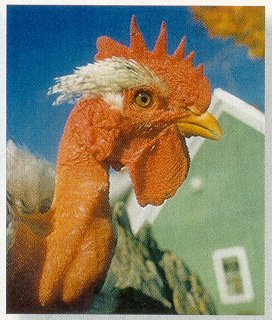
| Male Mature Weight: 8.5 lbs |
| Female Mature Weight: 6.5 lbs |
| Comb Type: Single |
| Egg Color: Brown or Tinted
Egg Size: 24-25 Ounces/dozen Rate of Lay: "Very Good" |
| Type: Meat - Laying - Dual-purpose - Other |
| Setting: Good setters |
| Disposition/Temperament: Friendly, calm, quiet, bears confinement well |
| Climate Hardiness: All Climates, Heat, Winter-hardy [1], [2] |
| ALBC Priority: Study |
| Show Class: Production |
Half chicken and half turkey? No, the Turken is all chicken but unique because of its turkey-like bare neck, less than normal feathering around the breast, under the wings, and around the vent. In spite of the feather shortage, Turkens stand cold weather very well, are good layers of brown eggs, and grow to 6 pounds or more, making a fine eating bird. The hens are also good setters. The origin of this breed is uncertain but more recent development in Eastern Europe gave them the name Transylvanian Naked Necks. They are now standardized for show in White, Black, Buff, and Red. We have purposely kept our Turken flocks mixed in color (including silver) for a more colorful and distinctive offspring. Baby chicks hatch with bare necks and are easily identified.
Customer Comments:
... I bought 1 as a novelty a couple years ago, and does she lay! Last year I ordered 5 more and they
turned out to be the hardiest of the chicks in the batch!...
- - -
Our male Turken was the free chick you gave us in February 2001, he is now so big, heavy and tall,
in good health and strong. An intelligent bird with a big character. We enjoy him so much. Thank you
to gave us the opportunity to meet this breed full of qualities with this nice surprise. Truly.
JohanneSainte-Adele, Quebec
Originally called "Naked Necks" they were first bred in Eastern Hungary. The Turken is noted for its size and laying ability and come in different colors. To be different add these to your collection. A number of the color varieties were admitted into the American Standard of Perfection in 1965. We do not offer any specific color variety of this breed. Noted feature is their turkey like neck appearance.
Hen -------6 1/2 lbs
Rooster----8 1/2 lbs
Pullet------5 1/2 lbs
Cockerel--7 1/2 lbs
Ideal Poultry Breeding Farms, Inc:
Unusual- do not have feathers and the neck and only about half as many on the body. Look as if they may be a turkey-chicken cross.
The history of Naked Necks, which are also known as Turkens, dates back to the distant and obscure past. They were seen in Britain about 1880 and are known as Transylvanian Naked Necks in the British Standards. Their identifying feature is the absence of neck feathers. They also have only half the body feathers as other chickens, which is the result of a dominant gene. They are multi-colored and are very good producers of large tinted eggs.
Standard weights at maturity are males-8 1/2 lbs. and hens-7 1/2 lbs.
Naked Necks look somewhat like a small turkey because of their trademark featherless neck but are actually all chicken. The origin of the Naked Neck is unknown but they first appeared in Europe in the late 1800’s. Although they only have half the feathers of most other breeds of chicken and no feathers on their neck, they seem to do quite well in colder climates.
Comb: Single.
Standard weight at maturity: Hens: 7 ½ lbs, males 8 ½ lbs.
Egg color: Tinted
Wikipedia: [NAH]
...[the Naked Neck] is a dual-purpose utility chicken. They lay a respectable number of light brown eggs, and are considered desirable for meat production because they need less plucking and they have a meaty body. They are very good foragers and are immune to most diseases. The breed is also reasonably cold hardy despite its lack of feathers. Naked Neck roosters carry a single comb, and the neck and head often become very bright red from increased sun exposure. This breed has approximately half the feathers of other chickens, making it resistant to hot weather and easier to pluck...
The naked neck trait which this breed is controlled by an incompletely dominant allele (Na) located near the middle of Chromosome 3. Since this allele is dominant individuals which are either homozygous dominant (Na/Na) or heterozygous (Na/na+) will exhibit the naked neck characteristic though the heterozygous individual will exhibit less reduction in feathering - true breeding members of the breed must then be homozygous dominant, and all individuals in the recognized breed must be also. Individuals which are homozygous recessive (or wild type feathered) (na+/na+) would not exhibit any feather reduction characteristics of the Naked Necks and, baring mutation, would be unable to pass that trait down.
Scientific studies have indicated that the naked neck gene (Na) improves breast size and reduces heat stress in chickens of non-broiler breeds which are homozygous for the trait. Additionally, in tropical climates if the naked neck trait (Na) is breed into broiler strains it has been shown to facilitate lower body temperature, increased body weight gain, better feed conversion ratios and carcass traits compared to normally feathered broilers.
Wikipedia: [NAH]
...Strangely, Turkens are said to fare very well in the cold despite their feather shortcomings and big combs (though these features do help them in the heat)... they are also calm, very friendly and one of the easiest chickens to tame. Relatively rare in North America, Naked Necks are very popular in Europe, especially France and Germany.
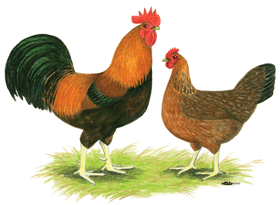
| Male Mature Weight: 6 lbs |
| Female Mature Weight: 5 lbs |
| Comb Type: Single |
| Egg Color: Dark Brown, often spotted
Egg Size: "Large" Rate of Lay: "Medium", ~3/week |
| Type: Meat - Laying - Dual-purpose - Other |
| Setting: No |
| Disposition/Temperament: Docile, intelligent, bears confinement well |
| Climate Hardiness: Cold, Winter-hardy [1], [2] |
| Show Class: Continental |
Also available from:  David Campbell,
Wadhurst, East Sussex, UK; and
David Campbell,
Wadhurst, East Sussex, UK; and  A & J Poultry, Wiveliscombe, Somerset, UK.
A & J Poultry, Wiveliscombe, Somerset, UK.
The Welsummer is a Dutch breed named after the village of Welsum in Holland, developed in the 1900's. It was first imported into this country in 1928 for its large brown egg. The Welsummer is a large, upright, active bird with a broad back, full breast, large full tail and a single comb. They are a fast growing bird and a very rare breed here in the United States. Admitted to the American Standard of Perfection in 1991.
Hen----------6 lbs
Rooster------7 lbs
Pullet-------- 5 lbs
Cockerel-----6 lbs
Ideal Poultry Breeding Farms, Inc:
Welsummers are a breed that originated in Holland. They are best known for the production of very dark eggs. The plumage of the males is very different from the plumage of the females. The male's saddle, head and neck feathers are rich golden brown while the back, wing front and wing bows are bright reddish brown. Each feather of the back of the females is reddish brown, stippled with black, and has a distinct lighter shaft.
Standard weights at maturity are males-6 lbs and hens-5 lbs
Welsummers are a very popular but rare breed that originated in Holland in the early 1900’s and was first presented for show around 1922. Welsummers are known best for the eggs they lay, which are a beautiful dark cocoa brown. Although they are good egg layers, they are considered a non-sitting breed. They are good foragers, so they tend to consume less feed than other breeds.
Comb: Single.
Standard weight at maturity: Hens 5 lbs, males 6 lbs.
Egg color: Dark Brown
Wikipedia: [NAH]
Welsummer is a chicken breed originally from the small village of Welsum, in the eastern Netherlands.
It was bred at the beginning of the 20th century from local fowls of mixed origin: Rhode Island Reds, Barnevelders, Partridge Leghorns, Cochins, and Wyandottes. In 1922-23 steps were taken to fix a standard after the birds began to show a good deal of uniformity. The eggs were originally exported for the commercial egg trade where they were an instant hit. Soon after stock was imported into England. The breed was added to the British Standard in 1930.
It is a light, docile breed, with rustic-red and orange colour. Representations of cockerels in the media are often based upon the "classic" Welsummer look. The most common example of this would be the Kelloggs Cornflakes rooster. Its eggs are dark-brown and spotty. There are three variations of the standard Welsummer, these are the Partrige, Silver Duckwing and the Gold Duckwing... The Welsummer hens usually have gold hair-like feathers on their necks, as the cocks have a rusty-red on their necks.
Backyard Chickens.com: [NAH]
"...In my experience they are a gentle, although not overly friendly breed. They take confinement well.
"Hens are very independent and do not tend to go broody. I have heard of roosters being mean but mine have been pretty laid back. Beware dark eggs can be tricky to hatch..." - mschickychick
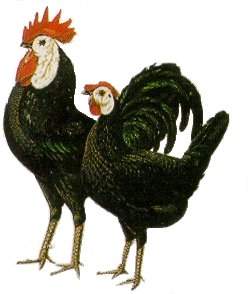
| Male Mature Weight: 8 lbs |
| Female Mature Weight: 6.5 lbs |
| Comb Type: Single |
| Egg Color: Chalk White
Egg Size: "Large" Rate of Lay: 150-180/year, ~3/week |
| Type: Meat - Laying - Dual-purpose - Other |
| Setting: No |
| Disposition/Temperament: Friendly, noisy, does not bear confinement well |
| Climate Hardiness: Heat, not winter-hardy [1], [2] |
| ALBC Priority: Critical |
| Show Class: Mediterranean |
In general carriage the Spanish are graceful and stylish. The rich glossy black plumage, the large red comb, and the long pendulous white face and ear lobes present a striking and different appearance. They are non-setters, lay white eggs, and are the same size as Minorcas. They are thought to be the oldest breed in the Mediterranean class of fowl. The white face of our Spanish is very slow to develop. Please allow the birds to go through one molt before showing them.
Customer comments:
We ordered a pair of White Faced Black Spanish several years ago and they have been a beautiful addition to
our farm. The hen is a consistent layer and the male, with extrememly large spurs, is suprisingly gentle.
Thanks McMurray hatchery, we have been very pleased.
Ideal Poultry Breeding Farms, Inc:
The Spanish breed is probably the oldest breed in the Mediterranean Class, dating back as far as 1572. They have white skin; are non-sitters and are known for their production of large, chalk white eggs. They are kept primarily because they are unique with a dramatic difference between the jet-black plumage and their enamel white face and ear lobes. In the past they have been known as "Clown Faced Chickens".
Standard weights at maturity are males-6 1/2 to 8 lbs. and hens-5 1/2 to 6 1/2 lbs.
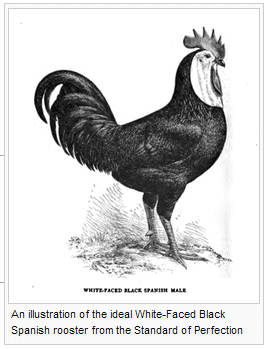 Wikipedia |
Wikipedia: [NAH]
The White-Faced Black Spanish... are thought to be the oldest breed of fowl in the Mediterranean class. The British have records dating back to 1572 referring to this chicken. This breed was admitted into the American Poultry Association in 1874. This breed... came to the Americas through the Caribbean Islands.
Nicknames of this breed include "Clown Chickens," but they were also called, "The Fowls of Seville." They were very popular in the South during Colonial times.
They have glossy black plumage, weigh 6-7 pounds, and are closely related to the Minorca and Castilian breeds. Their most distinguishing feature are their white, low hanging ear lobes, which are actually overdeveloped. They have a single comb, four toes, and no crest. Hens are non-setters that lay eggs that are large, and chalk white in color, with an average of three a week, 150-180 eggs a year.
The Wyandotte is a breed of chicken originating in the United States. The first examples of the breed appeared in 1870s. Wyandottes are a docile, dual-purpose breed kept for both eggs (Wyandottes are brown egg layers) and meat...
The Wyandotte is a medium sized bird with a rose comb and clean legs. The chicken feathers are broad and loosely fitting. The area around the vent is very fluffy. The legs are yellow, although some silver laced may have grey...
The Wyandotte is a breed that suits both free range and confinement in a run. They occasionally go broody. They tend to be quite friendly, and not flighty, and so make good pets for people. They are also very vocal, uttering soft clucks on a regular basis.
The hens (females) will lay around 200 eggs a year with an exceptional hen laying around 240 eggs a year. The eggs are brown or tinted. The hens weigh around 6 pounds and the cocks weigh around 8 1/2 pounds. The hens also make great setters. It is sometimes difficult for natural insemination to occur, due to the number and thickness of feathers in the tail area. For the same reason, they are prone to accumulation of feces on vent-area feathers that needs to be regularly washed off, or the vent could become clogged...
Backyard Chickens.com: [NAH]
"...Wyandottes are very good egg layers even in winter! They make a good table bird, and a dressed Wyandotte is nearly proportional to a modern Cornish rock X.... wyandottes are very docile and mellow, my 5 week old will fall asleep in my hands if I pick her up! she is soooooo friendly! she loves to be petted! I HIGHLY recomend this breed!" - Chickenrandomness
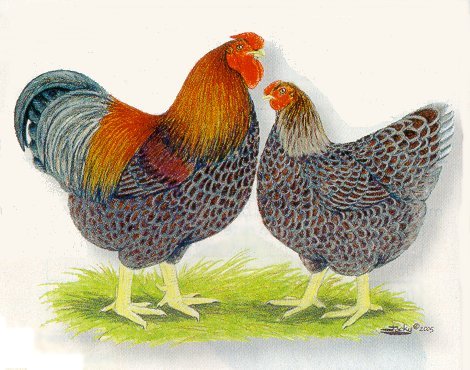
| Male Mature Weight: 8.5 lbs |
| Female Mature Weight: 6.5 lbs |
| Comb Type: Rose |
| Egg Color: Brown
Egg Size: "Large" Rate of Lay: 200-240/year |
| Type: Meat - Laying - Dual-purpose - Other |
| Setting: Yes |
| Disposition/Temperament: Friendly and calm, bears confinement well |
| Climate Hardiness: All Climates, Winter-hardy [1], [2] |
| ALBC Priority: Recovering or rarer |
| Show Class: American |
This variety of Wyandotte is relatively new and came to the United States from England a short time ago. We were able to get our stock from an outstanding breeder here in the states prior to his "closing the door" on this variety and feel fortunate to perpetuate the Blue Laced Red Wyandotte gene pool. The original development of these came from crossing Silver Laced and Golden Laced varieties of Wyandotte's. After much work the Blue Laced Red was developed from this cross. The blue gene will color the chicks either light blue or dark blue in the lacing (the area around the reddish colored feathers) in both the baby chicks and the mature birds. Therefore you may have birds that vary somewhat in appearance but still display the beautiful colors of this very rare and unusual chick. Mature Blue Laced Red Wyandotte's lay brown eggs and are medium in size with the deep - round Wyandotte appearance.
Customer comments:
I ordered some Blue Laced Red Wyandottes from you 2 monthes ago. They are all very healthy and growing
fast. They are absolutely the most beautiful chickens I have ever seen. Thanks for the wonderful poultry
over the years!
- - -
The Blue Laced Red Wyandottes I received from McMurray are gorgeous birds. The color varations from light
to dark blue make a stunning sight. Thanks for offering these unique chickens.
- - -
I ordered 18 breeds from you this year and my pair of Blue Laced Red Wyandottes are my favorites. The
cockerel is large, stately, friendly and calm, as well as gorgeous. The pullet is large, friendly, calm,
and beautiful with a red "dress" and beautiful "blue petticoats." I am very proud of "Wyatt and Charlotte."
This pair of chickens always comes to the gate at bedtime for a special hand-fed bedtime snack. They are
hard to resist!
- - -
We just got 5 of these, and they are gorgeous! They love people, and are just great to be around!!!
- - -
We received a male/female pair of Blue Laced Red Wyandottes in a special assorted bargain this year. These
two are just the most beautiful birds and very friendly. Thanks so much.
- - -
I will be ordering more Blue Laced Red Wyandottes soon. I have ordered 6 this year and I absolutely love
this breed of chickens. They are so friendly and follow me everywhere and they are my favorite of all
the breeds I have ordered from you. These chicks are getting more and more beautiful as each new feather
comes in.
- - -
I ordered 6 blue laced red wyandottes this past May and these are the friendliest breed of chicken I have.
They are always following me around and are totally trusting of me. Their coloring is beautiful and I
will definitely be ordering more of this breed in the future. I am so happy that you are offering this
breed and I hope you continue on with this breed.
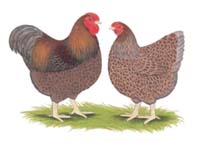
| Male Mature Weight: 30 oz |
| Female Mature Weight: 26 oz |
| Comb Type: Rose |
| Egg Color: Brown
Egg Size: [Small] Rate of Lay: 200-240/year |
| Type: Meat - Laying - Dual-purpose - Other |
| Setting: Yes |
| Disposition/Temperament: Docile, bears confinement well |
| Climate Hardiness: All Climates, Winter-hardy [1], [2] |
| Show Class: Rose Comb Clean Legged Bantams |
Ideal Poultry Breeding Farms, Inc:
Blue Laced Red Wyandotte Bantams have a unique and beautiful color pattern, which is a breeding challenge for even the most experienced breeders. A very large breeder population is required to successfully select and breed this extremely rare variety because the Blue (Bl) gene is incompletely dominant and does not breed true. The color pattern for males is very different from that of the females. Most of the plumage of this variety is rich red with each feather regularly laced with blue. Wyandotte Bantams have a graceful, well-balanced, alert appearance with a docile temperament.
Standard weights at maturity are males-30 oz. and hens-26 oz.
The blue (Bl) gene only has an effect on black plumage resulting in blue plumage when the blue gene is present in the heterozygous state (Bl bl). Other plumage colors are not affected by the blue gene. When blue (Bl bl) males are mated with blue (Bl bl) females, the ratio of colors produced is as follows: 1 black (bl bl), 2 blue (Bl bl) and 1 splash (Bl Bl) (white with a blue cast). Any blue variety ordered from Ideal Poultry may include chicks with black, blue or splash plumage patterns.
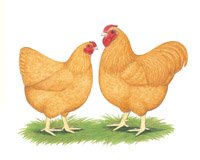
| Male Mature Weight: 8.5 lbs |
| Female Mature Weight: 6.5 lbs |
| Comb Type: Rose |
| Egg Color: Brown
Egg Size: "Large" Rate of Lay: 200-240/year |
| Type: Meat - Laying - Dual-purpose - Other |
| Setting: Yes |
| Disposition/Temperament: Friendly and calm, bears confinement well |
| Climate Hardiness: All Climates, Winter-hardy[1], [2] |
| ALBC Priority: Recovering |
| Show Class: American |
Ideal Poultry Breeding Farms, Inc:
Buff Wyandottes are a rose comb variety, which lay brown eggs, are graceful,well balanced, alert and docile. The plumage is fairly close and silky but not too abundant or fluffy. All of the surface plumage of both males and females is an even shade of intense golden buff, which should be free of shaftiness, mealiness, cloudiness or a mottled appearance. The males head, neck, hackle, back, sickle, wing bow and saddle plumage should be richly glossed, intense, golden buff which makes their plumage darker than the females.
Standard Weights at maturity are Males-8.5 lbs, and Hens-6.5 lbs.

| Male Mature Weight: 30 oz |
| Female Mature Weight: 26 oz |
| Comb Type: Rose |
| Egg Color: Brown
Egg Size: [Small] Rate of Lay: 200-240/year |
| Type: Meat - Laying - Dual-purpose - Other |
| Setting: Yes |
| Disposition/Temperament: Docile, bears confinement well |
| Climate Hardiness: All Climates, Winter-hardy[1], [2] |
| Show Class: Rose Comb Clean Legged Bantams |
Ideal Poultry Breeding Farms, Inc:
Buff Wyandotte Bantams are graceful, well balanced, alert and docile. The plumage is fairly close and silky but not too abundant or fluffy. All of the surface plumage of both males and females is an even shade of intense, golden buff, which should be free of shaftiness, mealiness, cloudiness, or a mottled appearance. The male's head, neck, hackle, back, sickle, wing bow and saddle plumage should be richly glossed, intense, golden buff, which makes their plumage darker than the females.
Standard weights at maturity are males-30 oz. and hens-26 oz.
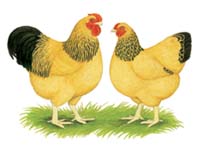
| Male Mature Weight: 30 oz |
| Female Mature Weight: 26 oz |
| Comb Type: Rose |
| Egg Color: Brown
Egg Size: [Small] Rate of Lay: 200-240/year |
| Type: Meat - Laying - Dual-purpose - Other |
| Setting: Yes |
| Disposition/Temperament: Friendly |
| Climate Hardiness: All Climates, Winter-hardy[1], [2] |
| Show Class: Rose Comb Clean Legged Bantams |
Ideal Poultry Breeding Farms, Inc:
Buff Columbian Wyandotte Bantam males and females have very similar plumage color pattern; however, the males appear to be darker because much of their plumage is highly glossed. The Columbian color pattern is the result of the action of the dominant autosomal Columbian (Co) gene. The genetic makeup of this variety is the same as Columbian Wyandotte Bantams when the dominant Silver (S) genes are replaced with recessive Gold (s) genes in the homozygous state (ss) in the males and the hemizygous state (s-) in the females. This result is silvery white plumage being changed to buff with all of the black markings remaining the same.
Standard weights at maturity are males-30 oz. and hens-26 oz.
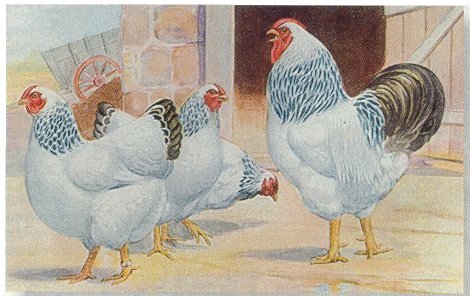
| Male Mature Weight: 8.5 lbs |
| Female Mature Weight: 6.5 lbs |
| Comb Type: Rose |
| Egg Color: Brown
Egg Size: "Large" Rate of Lay: 200-240/year |
| Type: Meat - Laying - Dual-purpose - Other |
| Setting: Excellent setters and mothers |
| Disposition/Temperament: Friendly, bears confinement well |
| Climate Hardiness: All Climates, Winter-hardy[1], [2] |
| ALBC Priority: Recovering |
| Show Class: American |
Columbian Wyandottes are an unusual and attractive variety. They have the same deep, well rounded bodies and close set comb of all Wyandottes, and are of medium size. Appearance is handsome with white bodies, and contrasting neck, tail, and wing plumage which are black with silvery white edging. Their nice yellow skin and plump bodies make them easy to dress and they lay brown eggs. The hens make excellent setters and mothers. This variety was first exhibited at the Columbian Exposition in Chicago in 1893, and got their name in that way. Baby chicks are a creamy white and some have dark gray shading on the back.
Customer comments:
I would just like to let you know how good these chickens are, I bought 25 pullets from you in March and by September they were laying, now I get an egg almost everyday from each one. Thanks James
This chicken was named after it was exhibited at the 1893 (Columbian Exposition or World's Fair) held in Chicago. This variety was admitted as an American Standard breed in the American Standard of Perfection in 1905.
Hen -------6 1/2 lbs
Rooster----8 1/2 lbs
Pullet------5 1/2 lbs
Cockerel--7 1/2 lbs
Ideal Poultry Breeding Farms, Inc:
The plumage of Columbian Wyandotte males and females is very similar. The wing primaries are black or black edged with white, while the secondaries have black inner webs and white outer webs. The hackle and saddle feathers are black down the center, surrounded by white. The male's tail is glossy, greenish black and the coverts may or may not be laced with white. The female's tail is black, except the top two feathers may be laced with white. All of the remaining plumage of both males and females is pearl white. They lay brown eggs.
Standard weights at maturity are males-8 1/2 lbs. and hens-6 1/2 lbs.
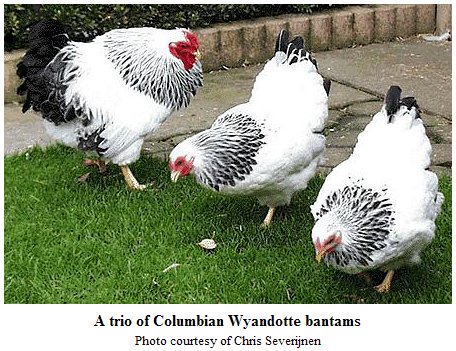 Feathersite |
| Male Mature Weight: 30 oz |
| Female Mature Weight: 26 oz |
| Comb Type: Rose |
| Egg Color: Brown
Egg Size: [Small] Rate of Lay: 200-240/year |
| Type: Meat - Laying - Dual-purpose - Other |
| Setting: Yes |
| Disposition/Temperament: Alert and docile, bear confinement well |
| Climate Hardiness: All Climates, Winter-hardy[1], [2] |
| Show Class: Rose Comb Clean Legged Bantams |
Ideal Poultry Breeding Farms, Inc:
The plumage of Columbian Wyandotte Bantam males and females is very similar and is discussed in the Columbian Wyandotte Internet paragraph. The Columbian feather pattern is one of the most attractive of all color patterns with a dramatic difference between the lustrous, greenish black and the silvery white. This plumage pattern is the result of the action of the dominant, autosomal Columbian (Co) gene. The appearance of Wyandotte Bantams is graceful, well balanced, alert and docile.
Standard weights at maturity are males-30 oz. and hens-26 oz.
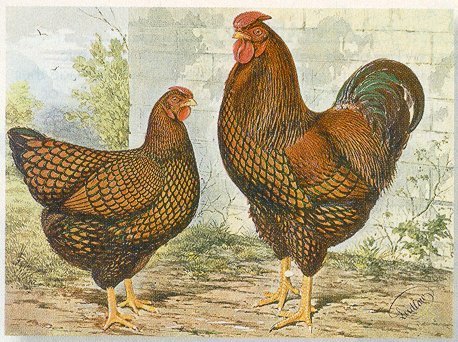
| Male Mature Weight: 8.5 lbs |
| Female Mature Weight: 6.5 lbs |
| Comb Type: Rose |
| Egg Color: Brown
Egg Size: 24-25 Ounces/dozen Rate of Lay: 200-240/year |
| Type: Meat - Laying - Dual-purpose - Other |
| Setting: Yes |
| Disposition/Temperament: "Sweet", bears confinement well |
| Climate Hardiness: All Climates, Winter-hardy[1], [2] |
| ALBC Priority: Recovering |
| Show Class: American |
The “ancestors” of Golden Laced Wyandottes originated in Wisconsin and were called Winnebagoes. By 1880 they received their present-day name. This variety is a beautiful combination of rich golden bay laced with lustrous greenish black. The general feather pattern is very similar to the Silver Laced Wyandottes. A beautiful bird for exhibition.
Customer comments:
These are great birds! In the two years I've put them in the fair, I've gotten seven blue ribbons! They are
beautiful on a summer afternoon, their plumage set off in the sun. And they are just dark enough that in the
winter they look lovely against the white snow. I use them for 4-H and laying (which they're also good at).
I plan to use them in the future!
- - -
These golden girls are one of the most GORGEOUS breeds I've ever had. They're fabulous to have around the
farm with their sweet personalities and good egg laying ability. A flock of 50-50 Golden Laced and Silver
Laced Wyandottes will beautify your homestead like nothing else can!
Admitted to the American Standard of Perfection in 1888. Originated in Wisconsin in 1880 and noted for a nice rose comb. They are a dual purpose fowl used for meat and eggs and represent a true American chicken.
Hen -------6 1/2 lbs
Rooster----8 1/2 lbs
Pullet------5 1/2 lbs
Cockerel--7 1/2 lbs
Ideal Poultry Breeding Farms, Inc:
Same as Silver Laced Wyandottes except gold replaces silver.
Golden Laced Wyandottes, which originated in Wisconsin are known as a docile, good producer of brown eggs. They are a hardy, active, medium weight, dual-purpose variety that is used for production of both meat and eggs. The chicks do not grow as fast as some of the other dual-purpose breeds and therefore, are a poor choice for producing broiler meat. Their unusual, attractive plumage color pattern and docile nature are characteristics that are making this variety more popular each year.
Standard weights at maturity are males-8 1/2 lbs. and hens-6 1/2 lbs.
Golden Laced Wyandottes originated in Wisconsin in 1880 by crossing a Silver Laced Wyandotte hen with a large black/red patterned fowl called a Winnebago. Their unusual yet striking plumage and gentle nature contribute to this beautiful American breed’s growing popularity. Although they don’t grow as quickly, they are still considered a good dual purpose breed.
Comb: Pea.
Standard weight at maturity: Hens 6 ½ lbs, males 8 ½ lbs.
Egg color: Brown
Wikipedia: [NAH]
...Joseph McKeen of Wisconsin was the originator of the Golden Laced Wyandotte. In 1880 he crossed Silver Laced Wyandotte females with a large "Black Red" patterned fowl of unknown origin called the Winnebago. The variety was admitted to the American Standard in 1888.
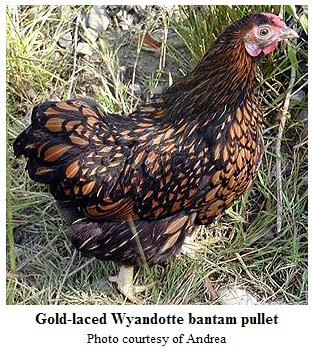 Feathersite |
| Male Mature Weight: 30 oz |
| Female Mature Weight: 26 oz |
| Comb Type: Rose |
| Egg Color: Brown
Egg Size: [Small] Rate of Lay: 200-240/year |
| Type: Meat - Laying - Dual-purpose - Other |
| Setting: Yes |
| Disposition/Temperament: Docile, bears confinement well |
| Climate Hardiness: All Climates, Winter-hardy[1], [2] |
| Show Class: Rose Comb Clean Legged Bantams |
Ideal Poultry Breeding Farms, Inc:
The close-fitting, sharply marked, gold and black color pattern of Golden Laced Wyandotte Bantams is very distinctive and attractive. The males and females have completely different plumage patterns. The entire rose comb, which is set low and firmly on the head, should curve to conform to the shape of the skull. The general appearance of Wyandotte Bantams is a short, deep, wide-bodied bird, which is very docile.
Standard weights at maturity are males-30 oz. and hens-26 oz.
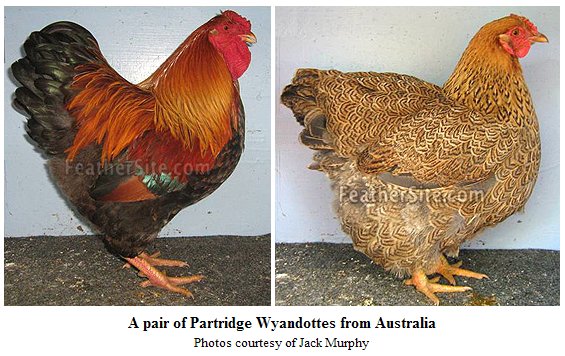 Feathersite |
| Male Mature Weight: 8.5 lbs |
| Female Mature Weight: 6.5 lbs |
| Comb Type: Rose |
| Egg Color: Brown
Egg Size: "Large" Rate of Lay: 200-240/year |
| Type: Meat - Laying - Dual-purpose - Other |
| Setting: Yes |
| Disposition/Temperament: Docile, bears confinement well |
| Climate Hardiness: All Climates, Winter-hardy[1], [2] |
| ALBC Priority: Recovering |
| Show Class: American |
Ideal Poultry Breeding Farms, Inc:
Partridge Wyandotte males and females have beautiful color patterns which are very different from one another. Most of the female's plumage is reddish bay with distinct black penciling. The male's hackle and saddle feathers are lustrous, greenish black with narrow lacing of a medium shade of rich, brilliant red. The breast, body and main tail feathers are black while the upper back is predominately rich, brilliant red. The bright red rose comb, which is low and set firmly and evenly on the head, is square in the front and conforms to the shape of the skull. They have a docile nature and a graceful, well-balanced carriage. They lay brown eggs.
Standard weights for this rare variety at maturity are males-8 1/2 lbs. and hens-6 1/2 lbs.
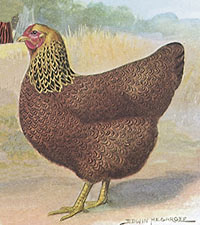
| Male Mature Weight: 30 oz |
| Female Mature Weight: 26 oz |
| Comb Type: Rose |
| Egg Color: Brown
Egg Size: [Small] Rate of Lay: 200-240/year |
| Type: Meat - Laying - Dual-purpose - Other |
| Setting: Yes |
| Disposition/Temperament: Friendly, bears confinement well |
| Climate Hardiness: All Climates, Winter-hardy[1], [2] |
| Show Class: Rose Comb Clean Legged Bantams |
Wyandottes have long been a very popular bantam breed for both show and to have around the farm. Our partridge exhibits its color and type very well and is an excellent chick for show, brown eggs, or hobby.
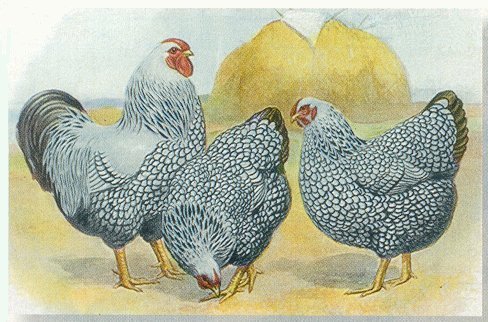
| Male Mature Weight: 8.5 lbs |
| Female Mature Weight: 6.5 lbs |
| Comb Type: Rose or Pea |
| Egg Color: Light-Dark Brown
Egg Size: 24-25 Ounces/dozen Rate of Lay: "Very Good" |
| Type: Meat - Laying - Dual-purpose - Other |
| Setting: Some |
| Disposition/Temperament: Calm and Friendly, bear confinement well |
| Climate Hardiness: All Climates, Winter-hardy[1], [2] |
| ALBC Priority: Recovering |
| Show Class: American |
The Silver Laced is the original Wyandotte and the other varieties were developed from it later with crosses on other breeds. It is an outstanding example of American poultry breeding ingenuity and is one of the most beautiful breeds we offer. It is colorful, hardy, and productive. The broadfeathered, smooth fitting plumage is sharply marked. The general appearance is silvery white and lustrous greenish black as each feather is edged in a contrasting color. The close-fitting rose comb and good body size are valuable assets for winter laying. Cold weather doesn't seem to bother them at all as their hardiness and vigor keep them laying straight through the winter. They lay a nicely shaped, good sized egg, varying from light to rich brown and will set some. This is another excellent variety for exhibition. Baby chicks vary from almost black to light silvery gray and many have contrasting light and dark stripes on the back.
Customer comments:
We added 2 SL Wyandottes in our order last spring. They have rapidly become family favorites. Very
friendly and calm. One of them even perches on my husband's shoulder given the chance! They are now
laying daily.
- - -
WE ORDERED AND RECEIVED 25 HENS. THEY ALL ARRIVED IN EXCELLENT HEALTH AND ARE GROWING VERY WELL.
THE MONTANA WINTER IS NOT BOTHERING THEM AT ALL, THANKS FOR SOME AWSOME CHICKENS WE WILL BE ORDERING
AGAIN FOR THIS SPRING.
- - -
Two years ago this month we bought our first McMurray chicks- equal parts of Silverlaced Wyandotte,
RIR and Barred Rocks. They have proven to be the best layers, healthy, happy, good pets, good manure
makers for our organic garden (and we live in the city). We are ordering more chicks to renew our flock
now that the girls are finally aging out after working so hard.
- - -
I received my chicks in the mail this morning, and they arrived in great shape! Very energetic and happy.
...
- - -
These are one of the most BEAUTIFUL breeds I've ever had. They're calm and friendly and are good layers
throughout the year. A flock of 50-50 Silver Laced and Golden Laced Wyandottes is a gorgeous sight on
the homestead!
Admitted to the American Standard of Perfection in 1883. The Silver Laced Wyandotte originated in New York State and is the parent variety of all the other Wyandotte varieties.
Hen -------6 1/2 lbs
Rooster----8 1/2 lbs
Pullet------5 1/2 lbs
Cockerel--7 1/2 lbs
Ideal Poultry Breeding Farms, Inc:
A beautiful old breed that has close-fitting rose combs. They are popular in cold-weather areas since their combs do not normally freeze.
Silver Laced Wyandottes, which are the most popular Wyandotte variety, are the original variety of the Wyandotte breed. The general appearance of Wyandottes is a short, deep, wide-bodied bird. Their close fitting, rose comb is an advantage in cold climates where single combs sometimes freeze. The unusual, striking color pattern and docile nature are characteristics that make them a popular variety. They are a very good layer of brown eggs.
Standard weights at maturity are males-8 1/2 lbs. and hens-6 1/2 lbs.
Silver Laced Wyandottes appeared around the 1870s. They are very strong egg layers with most hens producing between 200 and 240 eggs annually. The rose comb of this breed makes it a better choice for colder climates, as the comb is less likely to freeze. The temperament of these birds is considered to be docile and friendly, doing very well in both free range or confined environments.
Comb:Rose
Standard weight at maturity: Hens 6 /12 lbs, males 8 1/2 lbs.
Egg color: Brown
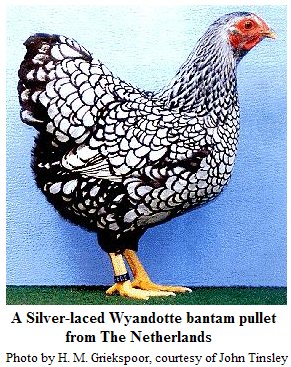 Feathersite |
| Male Mature Weight: 30 oz |
| Female Mature Weight: 26 oz |
| Comb Type: Rose |
| Egg Color: Brown
Egg Size: [Small] Rate of Lay: 200-240/year |
| Type: Meat - Laying - Dual-purpose - Other |
| Setting: Yes |
| Disposition/Temperament: Friendly, bear confinement well |
| Climate Hardiness: All Climates, Winter-hardy[1], [2] |
| Show Class: Rose Comb Clean Legged Bantams |
Ideal Poultry Breeding Farms, Inc:
The close-fitting, sharply marked plumage of Silver Laced Wyandotte Bantams is one of the most beautiful color patterns ever developed. The males and females have a completely different plumage pattern. This color pattern is more difficult to breed to perfection than most others and requires a larger breeding population. The rose combs of Wyandotte Bantams are set low and firm on the head, have an oval surface covered with small rounded points and taper to a well-defined point that curves to conform to the shape of the skull.
Standard weights at maturity are males-30 oz. and hens-26 oz.
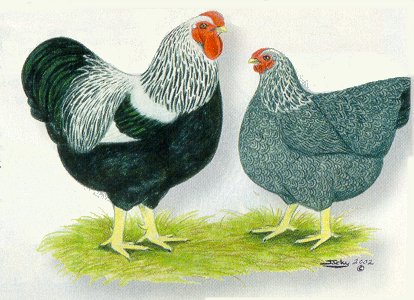
| Male Mature Weight: 8.5 lbs |
| Female Mature Weight: 6.5 lbs |
| Comb Type: Rose |
| Egg Color: Brown
Egg Size: "Large" Rate of Lay: 200-240/year |
| Type: Meat - Laying - Dual-purpose - Other |
| Setting: Yes |
| Disposition/Temperament: Friendly, bear confinement well |
| Climate Hardiness: All Climates, Winter-hardy[1], [2] |
| ALBC Priority: Recovering |
| Show Class: American |
These rare and beautiful birds are highly prized for exhibition purposes and for their valuable plumage which is ideal for fly tying. The male with silvery neck and back and black breast contrasts sharply with the female which is covered with distinct silvery gray and black penciling. Wyandottes have rose combs.
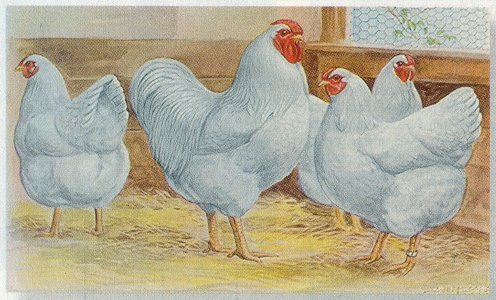
| Male Mature Weight: 8.5 lbs |
| Female Mature Weight: 6.5 lbs |
| Comb Type: Rose |
| Egg Color: Brown
Egg Size: "Large" Rate of Lay: 200-240/year |
| Type: Meat - Laying - Dual-purpose - Other |
| Setting: Yes |
| Disposition/Temperament: Gentle, friendly, bear confinement well |
| Climate Hardiness: All Climates, Winter-hardy[1], [2] |
| ALBC Priority: Recovering |
| Show Class: American |
Their plumage is snow white from the clean, outer feathers clear to the fluff next to their yellow skin. These, with the deep, well rounded bodies, make an ideal bird for dressing. The cockerels acquire a plumpness and finish earlier than many heavy breeds. With their rose combs they can stand cold weather very well, and flocks of this variety are excellent for northern climates. The hens lay a high quality, brown-shelled egg and lots of them. The White Wyandottes are a wonderful dual purpose fowl for the production of both meat and eggs.
Customer comments:
Got my White wyandottes for you in spring of 2002 and the cold of Michigan will not stop these laying machines.
- - -
I really do love these hens. They are very gentle & affectionate. They are 9 weeks old now & looking very healthy.
Admitted to the American Standard of Perfection in 1903. They were developed from the sports of the Silver Laced Wyandotte variety, in New York State in 1887. Noted for a nice rose comb that is suited for more northern climates resisting frost bite.
Hen -------6 1/2 lbs
Rooster----8 1/2 lbs
Pullet------5 1/2 lbs
Cockerel--7 1/2 lbs
NOTE: Murray McMurray "did-you-knows" are randomly selected by the website, so the links below may not match.
* A General Rule: Hens with while ear lobes lay white eggs and hen with red ear lobes lay brown eggs. There are some exceptions. - Murray McMurray Hatchery
* Did You Know?
A lighter weight hen eats about 4 lbs. of feed for every dozen eggs she lays. -
Murray McMurray Hatchery
[ed- With a dozen eggs weighing typically 25 ounces (1 lb 9 oz), this means 4 lbs of feed --> 1-1/2 lbs
of eggs.]
* Did You Know? Hens lay best at 1 to 2 years of age. - Murray McMurray Hatchery
* Did You Know? All pullets lay small eggs at first then they lay 1 egg every 3-4 days. - Murray McMurray Hatchery
*Did You Know? A hen thirty weeks old can lay at least 2 eggs every 3 days. - Murray McMurray Hatchery
*Did You Know? Hens lay best when the temperature is between 45-80 degrees (F) [7 - 27 deg C] - Murray McMurray Hatchery
*Did You Know? To have fertilized eggs, you will need to have 1 rooster to 8-12 hens. - Murray McMurray Hatchery
*Did You Know? A good way to tell if an egg is fresh is to put it in cold water. A fresh egg contains little air so it will sink. - Murray McMurray Hatchery
*Did You Know? When storing eggs in an egg carton, place the larger end up. - Murray McMurray Hatchery
*Did You Know? The cry of a female guinea sounds like buckwheat, buckwheat or put-rock, put-rock. - Murray McMurray Hatchery
*Did You Know? Guineas have dark meat that resembles pheasant meat. - Murray McMurray Hatchery
*Did You Know? Guineas lay from 50-100 eggs a year. - Murray McMurray Hatchery
*Did You Know? Chicks, just before they hatch, draw into their adomen the yolk of the egg. Rich in food value and liquid, the yolk provides the newly-hatched chick with all it needs to eat and drink for over 3 days. That is why we can hatch chicks here, ship them to you , and know that they will be well provided for along the way. - Murray McMurray Hatchery
*Did You Know? Chickens can start sparring to establish the pecking order at about 6 weeks of age. (And I've seen it in 1 week old chicks.) - Murray McMurray Hatchery
*Did You Know? Chickens will molt at about 18 months of age. Molting is where they loose all or some of their feathers and stop producing eggs. This is a natural shedding of feathers. Molting may take 2-4 months. - Murray McMurray Hatchery
*Did You Know? A chicken can live between 10-15 years. - Murray McMurray Hatchery
*Did You Know? An ideal chicken perch is about 2 inches in diameter. If you have bantams, a 1 inch diameter is big enough. - Murray McMurray Hatchery
*Did You Know? Geese are used in weeding tobacco, cotton, mint, strawberry, asparagus, corn, sugar cane, sugar beets, and flower fields, as well as vineyards, nurseries and fruit orchards. - Murray McMurray Hatchery
Hatcheries:
Murray McMurray Hatchery,
P.O. Box 458/191 Closz Drive,
Webster City, Iowa 50595
1-800-456-3280
Email
They also sell assortments of poultry; see their website.
-- Also sell books, equipment, feed, medicines
Cackle Hatchery,
PO Box 529,
Lebanon, MO 65536
(417) 532-4581
cacklehatchery@cacklehatchery.com
-- Also supply coops, books, supplies, etc
Ideal Poultry Breeding Farms, Inc.
PO Box 591/215 West Main,
Cameron, TX 76520-0591
(254) 697-6677
help@idealpoultry.com
-- Poultry only. Largest supplier of backyard poultry in U.S.
Randall Burkey Company,
P.O. Box 1090
Boerne, TX 78006
1-800-531-1097
info@randallburkey.com
-- Large selection of poultry-raising equipment and supplies
My Pet Chicken,
501 Westport Ave #311 (mail only)
Norwalk, CT 06851
888-460-1529 (toll free) or
908-795-1007 (local)
info@mypetchicken.com
-- Serving especially the backyard and urban chicken-raiser.
Specialize in small
(3-10) chick orders and sexed bantams.
Supplies also.
Hillview Exotics,
" Proud member of the Ohio Association of Animal Owners"
HillviewExotics@aol.com
740-258-2421 or 740-644-0653
-- A few kinds each of game birds, guineas, peacocks, pigeons,
chickens, turkeys, ducks, geese, swans, cage birds, and mammals.
Show Me Silkies.com,
Located in Mid-Missouri. "I have been raising Silkie bantams and
perfecting my
bloodline for over 10 years."
Web Contact Form
To Purchase: 4 Sale, and Web Store.
-- Specializing in Silkie bantams, Showgirls, Cream Brabanters,
true rumpless Araucana bantams, and Mandarin ducks.
NOTE: Sells largely hatching eggs,
not live chicks.
Nantahala Farm,
Topton, North Carolina, 28781
(in the Mountains of Western NC),
828-321-9036, Please do not call after 8 pm.
orders@healthtreasures.com
-- Several varieties of rare/endangered farm animals, plus
some other kinds of animals, plants, books
and articles about farming and gardening.
Selection varies, ask for details.
Supplies:
Cutler's Pheasant, Poultry, and Bee Supplies
1940 N Old 51
Applegate, MI 48401
(810) 633-9450 (Phone) - (810) 633-9178 (Fax)
sales@cutlersupply.com
-- Source of "Peepers" (see under Guinea Fowl).
Informational Pages:
Wikipedia on 'Chickens'.
Backyard Chickens.com
Feathersite
Other sources are linked when used.
Most of the chicken paintings are:
Artwork by Diane Jacky.
Email: mail@dianejacky.com
WEB: www.dianejacky.com
unless otherwise indicated
Midway Farm, in Oregon
For their picture of a basket of eggs,
from which I made all the 'back' buttons.
6980 Highway 20 NW,
Albany, OR 97321
(541) 740-6141
Many thanks to firoz.ansari,
on ASP.NET forum,
for his code-snippet for hiding the navigation rows when printing.
Back to Crocuta main
Revision Notes
1
Initial release
2
Added page breaks for improved layout
when printing hardcopy
3
Cleaned up the page breaks and added
CSS snippets for hiding the nav buttons when printing.
